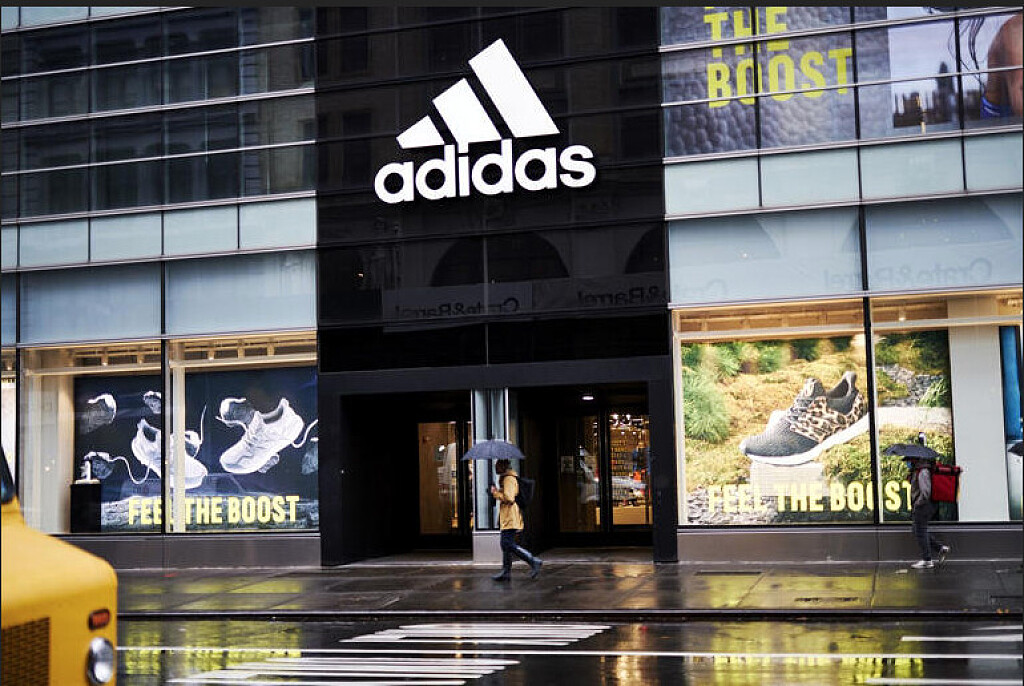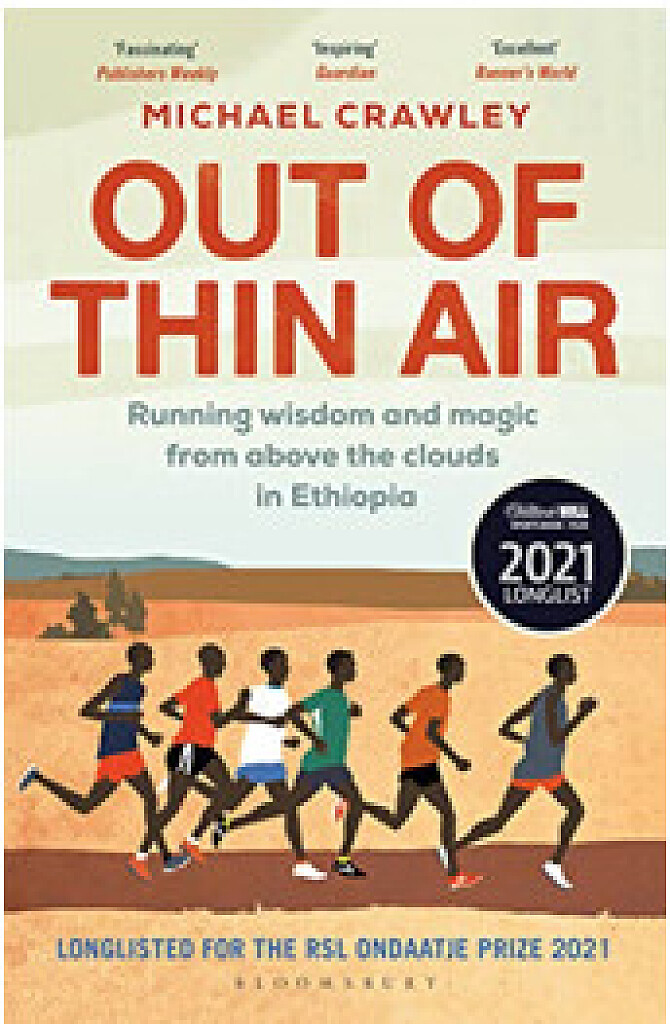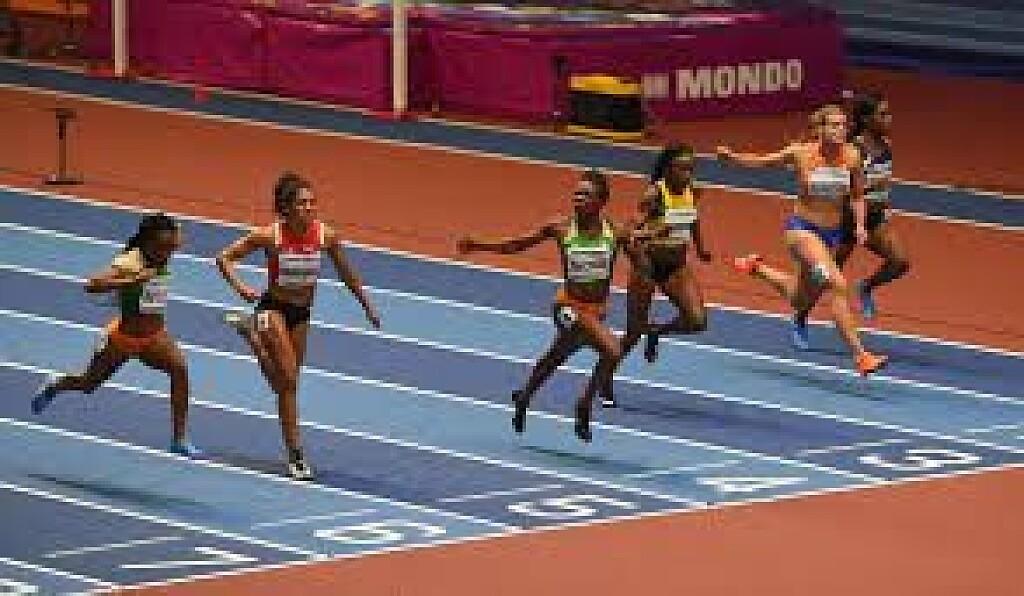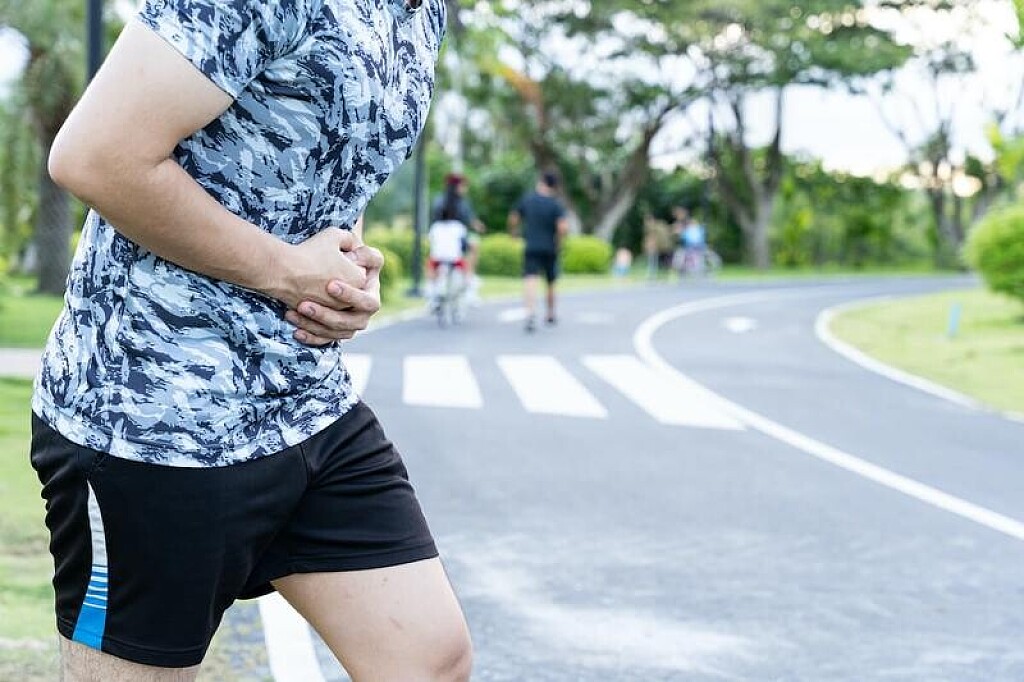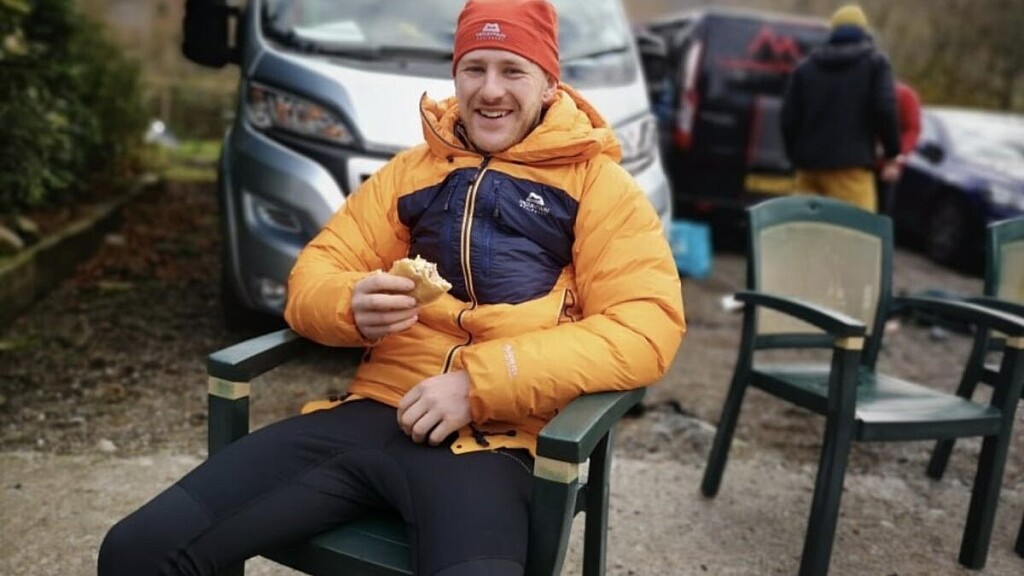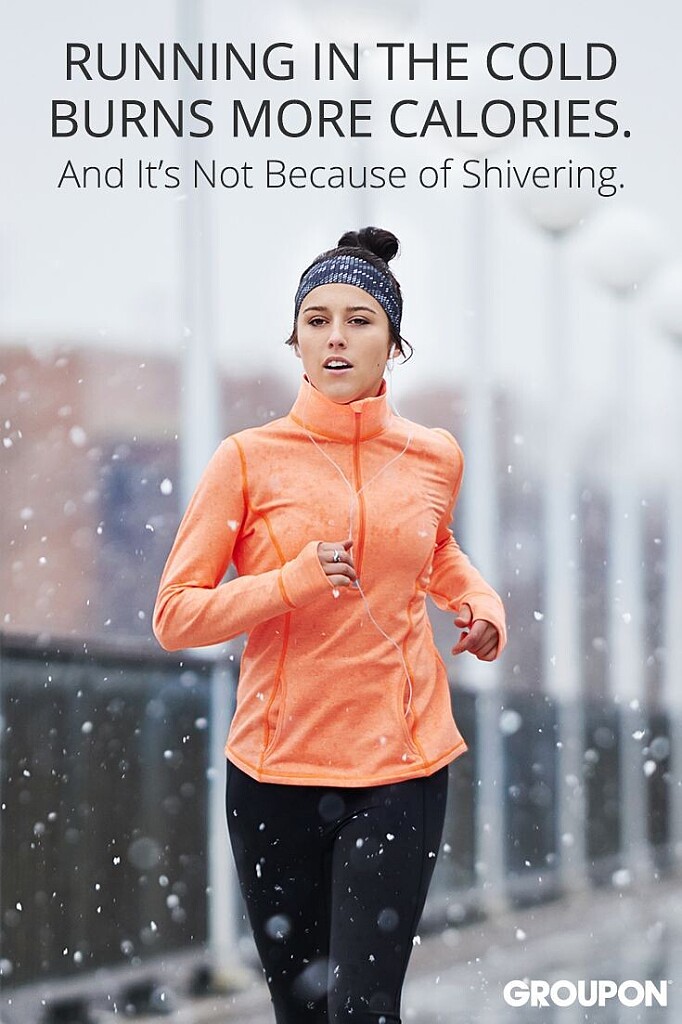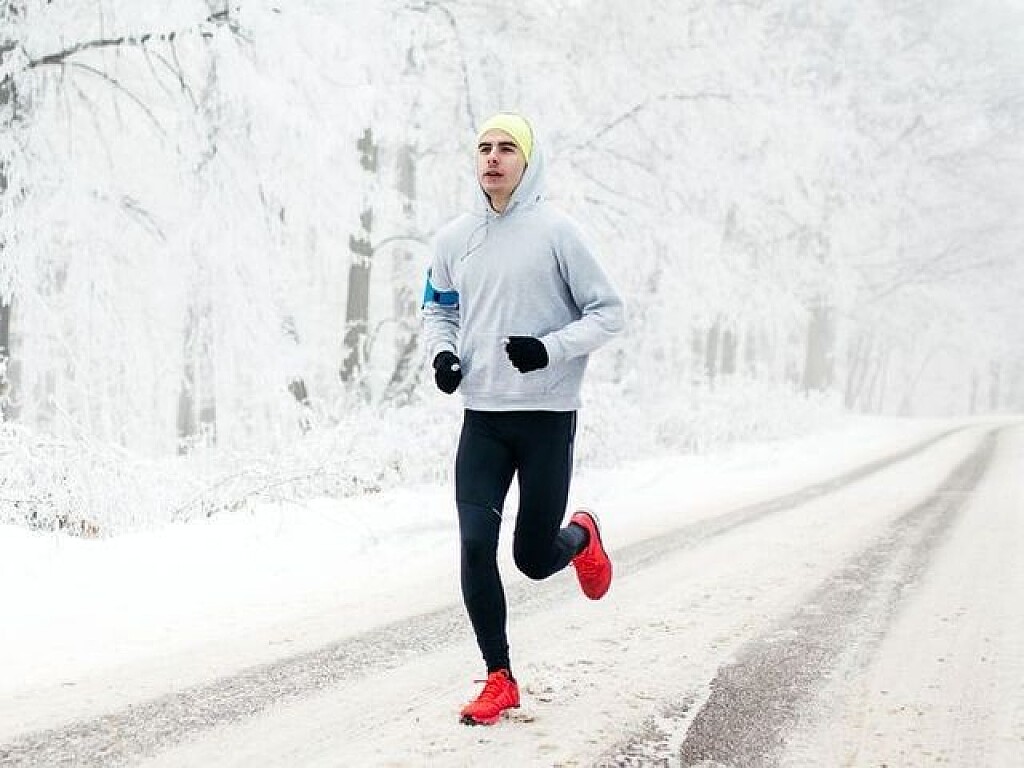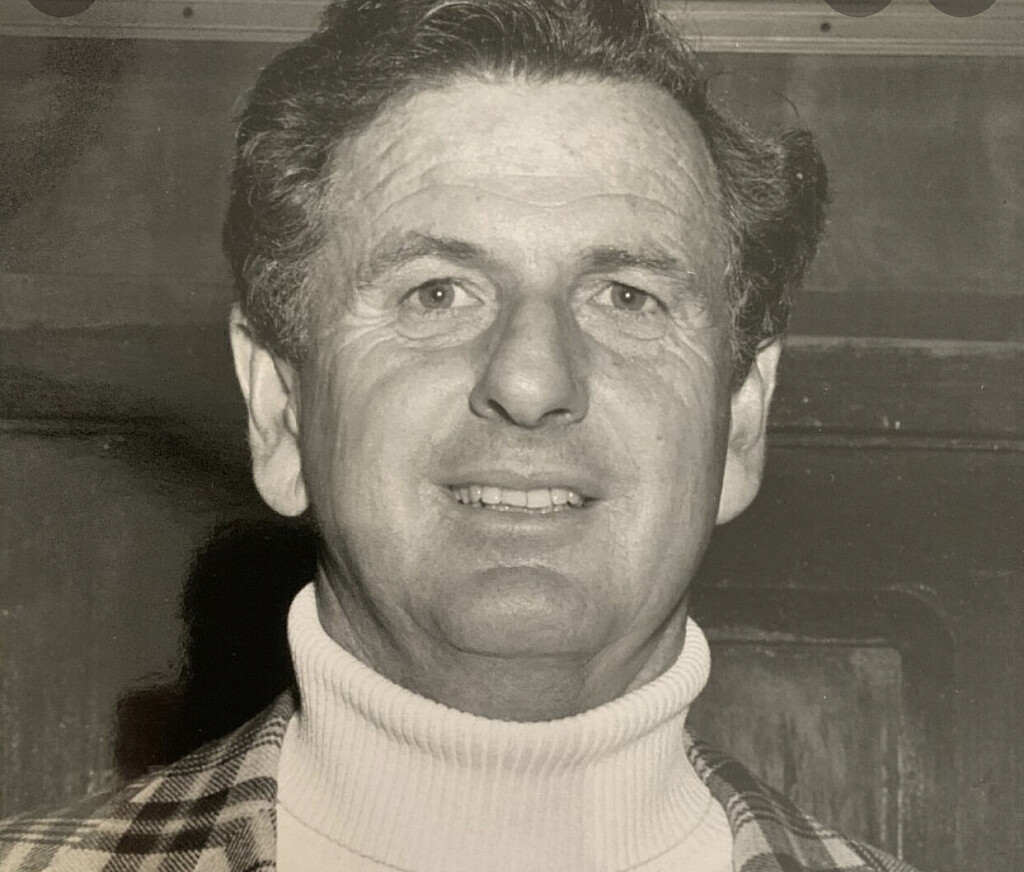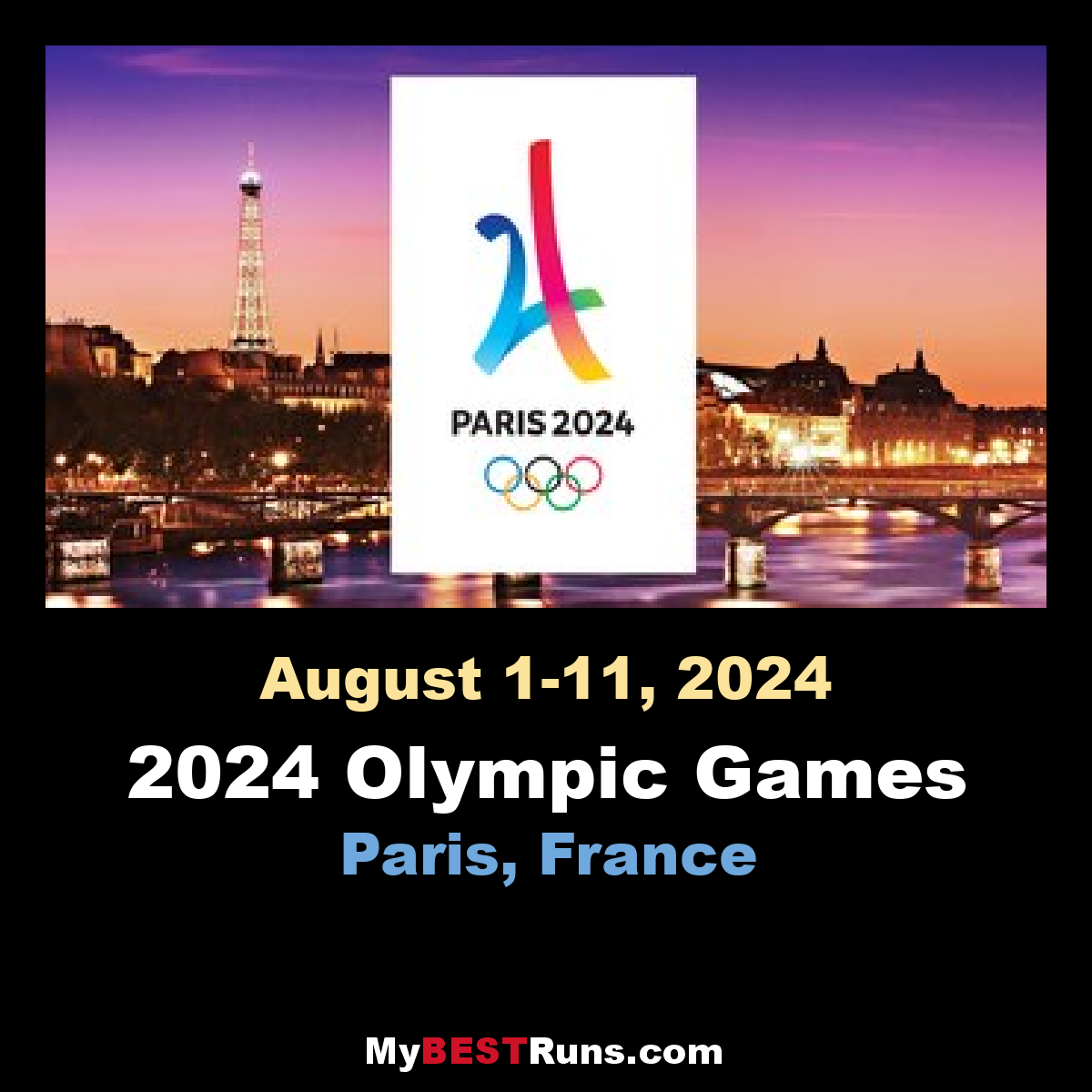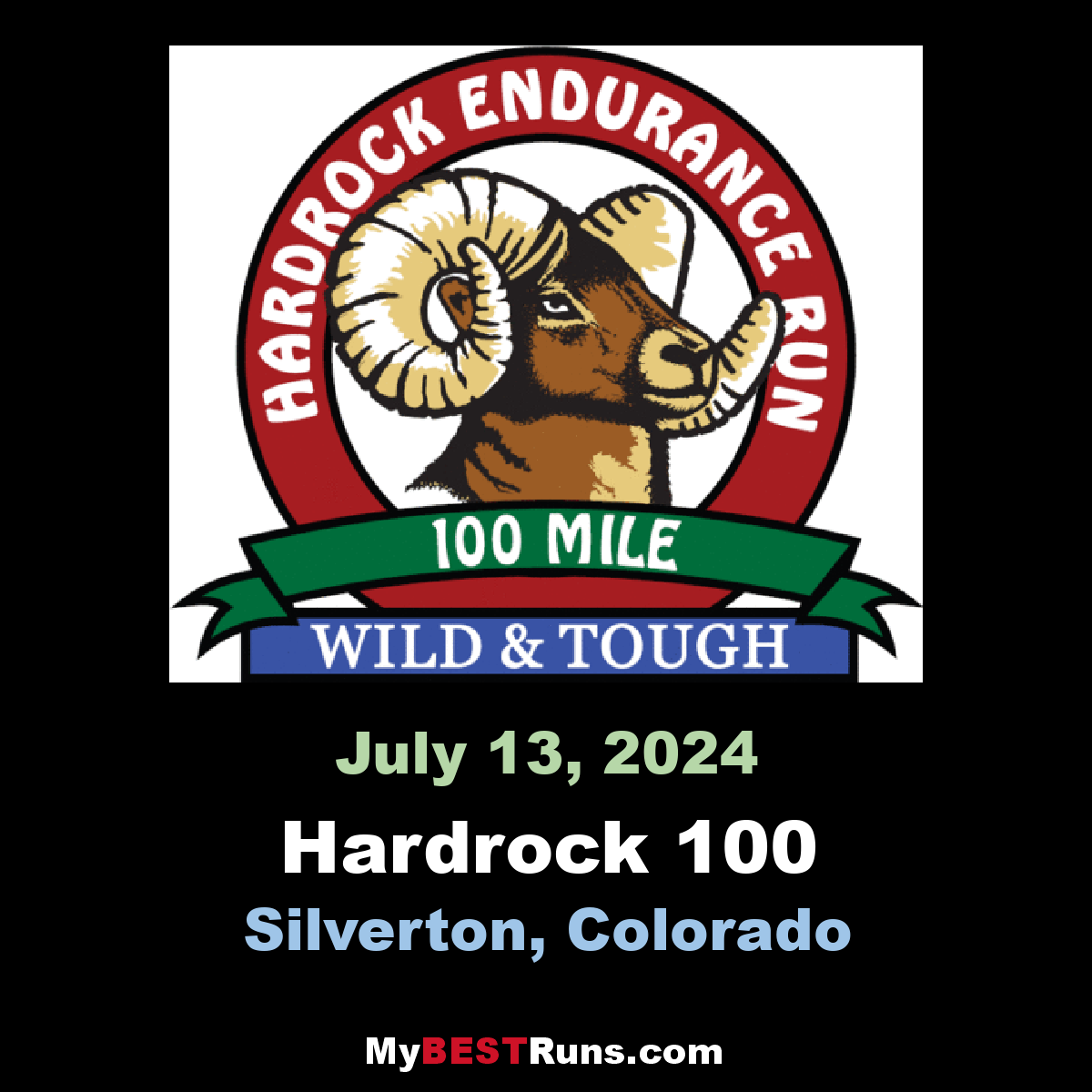Running News Daily
Running News Daily is edited by Bob Anderson in Mountain View, California USA and team in Thika Kenya, La Piedad Mexico, Bend Oregon, Chandler Arizona and Monforte da Beira Portugal. Send your news items to bob@mybestruns.com Advertising opportunities available. Over one million readers and growing. Train the Kenyan Way at KATA Running Retreat Kenya. (Kenyan Athletics Training Academy) in Thika Kenya. Opening in june 2024 KATA Running retreat Portugal. Learn more about Bob Anderson, MBR publisher and KATA director/owner, take a look at A Long Run the movie covering Bob's 50 race challenge.
Index to Daily Posts · Sign Up For Updates · Run The World Feed
Nike Tries to Ban Imports of Adidas Knit Shoes, Accusing It of Copying Designs
Nike Inc. is asking a U.S. trade agency to block imports of a wide range of Adidas AG Primeknit shoes, saying they copy the Oregon company’s patented inventions for a knitted fabric that reduces waste without any loss in performance.
The complaint, filed Wednesday at the International Trade Commission in Washington, seeks to ban imports of shoes, including Adidas by Stella McCartney Ultraboost, Pharrell Williams Superstar Primeknit Shoes and Terrex Free Hiker hiking shoes. Nike also filed a patent-infringement suit in federal court in Oregon making similar allegations.
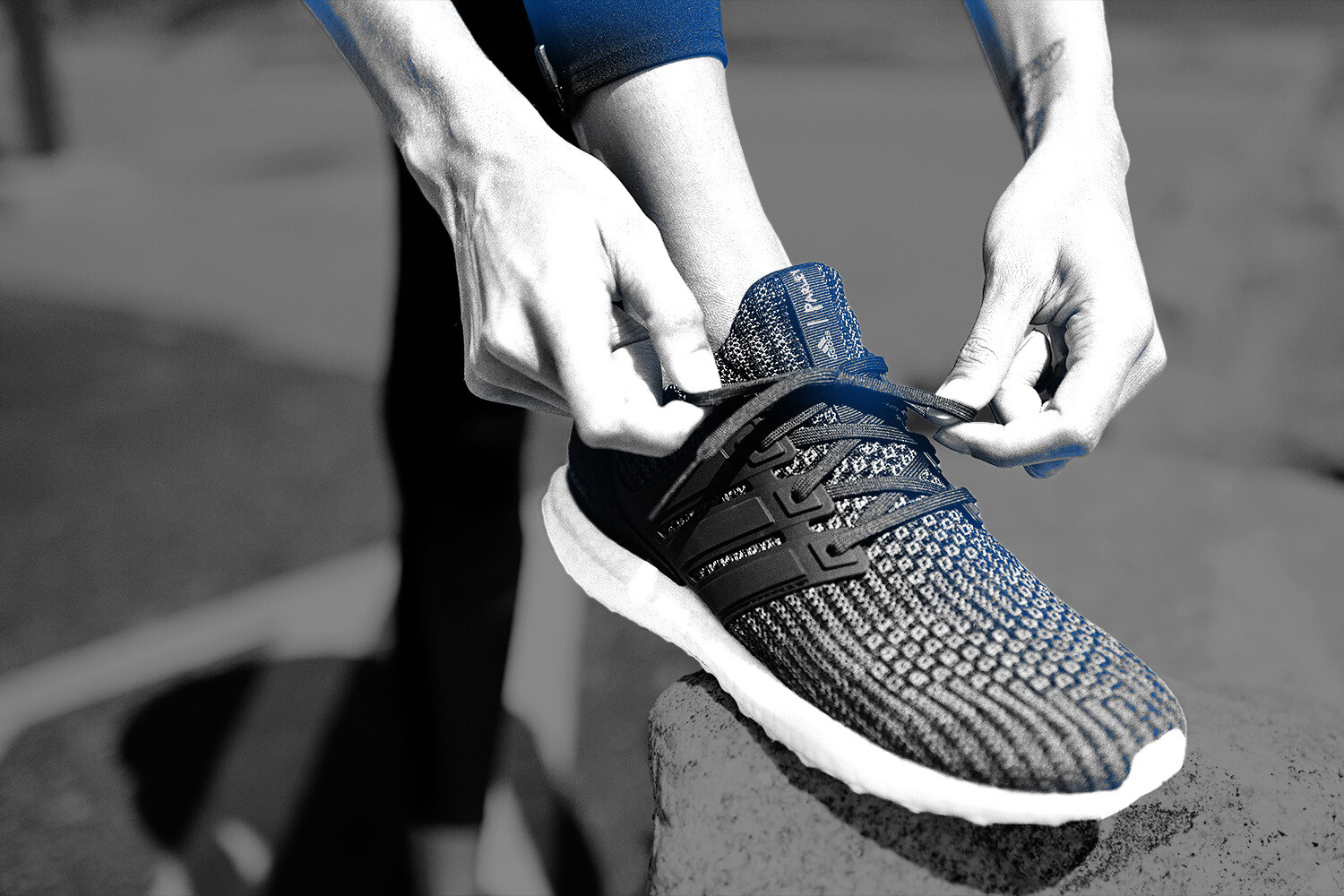
The patents cover Nike’s FlyKnit technology, which uses specialized yarn from recycled and reclaimed materials to create a sock-like fit in the upper part of the shoe. Nike said it was the result of more than $100 million and a decade of research -- almost all done in the U.S. -- and “represented the first major technology innovation in footwear uppers in decades.”
FlyKnit was first introduced before the 2012 London Olympics and has been adopted by “basketball great LeBron James, international soccer superstar Cristiano Ronaldo, and world record marathoner Eliud Kipchoge,” Nike said in the complaint.
“Unlike Nike, Adidas has forgone independent innovation,” Nike said in a court filing. “Instead, Adidas spent the past decade unsuccessfully challenging several of Nike’s patents directed to FlyKnit technology -- all while using Nike’s patented technology without permission.”
Nike said it was “forced to bring this action to defend its investments in innovation to protect its technology by halting Adidas’ unauthorized use.”
Adidas said it’s analyzing the complaint and “will defend ourselves against the allegations.”
“Our Primeknit technology resulted from years of dedicated research and shows our commitment to sustainability,” Mandy Nieber, an Adidas spokeswoman, said.
Several of Nike’s patents, including two of the six in the ITC complaint, have been the target of regulatory challenges by companies including Adidas. Nike said they were filed only because it refused to pledge not to sue the German company.
The civil suit, filed in Portland, Oregon, accuses Adidas of infringing those six patents and three others related to FlyKnit technology. It seeks unspecified damages and asks that any award be tripled for the intentional copying. It’s also seeking an order to halt sales.
Nike has been aggressive in protecting its FlyKnit and other shoe inventions. A lawsuit against Puma SE settled in January 2020 and ones against Skechers USA Inc. settled in November.
The U.S. trade agency is a popular forum for companies looking to derail rivals in the world’s biggest market. The commission works more quickly than most courts, with final decisions typically in 15 to 18 months. Not only can it block products at the U.S. border, it can halt sales of products already brought into the country, an order that’s harder to get in district court.
The cases are In the Matter of Knitted Footwear, 337-3580, U.S. International Trade Commission (Washington) and Nike v Adidas, 21-1780, U.S. District Court for the District of Oregon (Portland).
(12/12/2021) ⚡AMPFive books to make you rethink your running
At moments, running can be a monotonous sport. The same routes traversed time and again over a long winter block of training. Sometimes all it takes to relight that fire is a good book.
Here are five that will inspire you to get the trainers on once more.
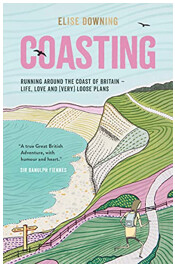

Out of Thin Air by Michael Crawley
Michael Crawley is a talented marathon runner who has competed internationally for Scotland, but it was his trip to Ethiopia that made him fall back in love with the sport. Living with some of the nation’s best athletes, Crawley provides a fascinating insight into one of running’s most fabled heartlands.
From travelling to altitudes where it is difficult to breathe all in search of almost mythical mountain air, to zig-zag runs through dense forests, Crawley introduces us to the almost spiritual association Ethiopia has with the sport.
An awe-inspiring, uplifting read, Out Of Thin Air will bring purpose to those daily runs and a spring in the step for anyone hoping to follow in their footsteps.
Coasting by Elise Downing
Elise Downing’s book starts with the familiar conundrum. A university graduate finding her feet in the working world, Downing faces up to the reality of what her future holds. Her solution, however, is not the typical.
Deciding to run the coast of Britain, Coasting follows her journey round the nation’s shores. It charts the highs and lows of the entire 5000-mile journey, the people she meets along the way and the truths she discovers about herself.
Coasting serves a fitting reminder of how running can provide a great platform to unwind your thoughts, to reflect and ultimately to move forward in a better place than when you headed out the door.
Born to Run by Christopher McDougall
An injury to his foot has McDougall in pursuit of a fix. But in searching for an answer, the author draws us to what many see as the birthplace of North American endurance: the Tarahumara tribe and their incredible ultra-running exploits.
The book follows McDougall in his attempt to complete a 50-mile race in Tarahumara territory and sees him try to answer how humans are capable of such extraordinary feats.
A mixture of high-level sports science and nostalgic romanticism will see you plodding along wondering whether you were born to do this.
Feet in the Clouds by Richard Askwith
Richard Askwith is, by his own admission, no fell-running superstar but his book on the sport provides a compelling illustration of just why so many find the sport so special. One in which the sport’s best and the rest face the same trials and tribulations.
Along his journey trying to complete the Bob Graham Round, a fell-running endurance challenge in the UK’s Lake District, Askwith tells the story of fell-running’s understated stars.
If a book can summarise what it means to be out on the fells, plotting your path, this is probably it.
Feet in the Clouds will have you searching for the tallest hill and making it your mission to climb it.
The Passion Paradox by Brad Stulberg & Steve Magness
In pursing your running goals, it can often feel like you lose balance in your life. When you don’t quite achieve what you are looking for, then it can have a big impact on how you feel. Not just about your running but also about your self-worth.
Stulberg and Magness tackle the notion of passion, how it is important for success but how it needs to be harnessed so as to avoid becoming something obsessive. They talk about the warning signs, how an element of imbalance is necessary but ultimately how you can channel it to your advantage.
Although this book isn’t just about running, it is for all those who feel they’re stuck in a rut and looking for something to freshen up their perspective to their passions.
(12/12/2021) ⚡AMPby World Athletics
World Athletics Indoor Tour to expand in 2022
The World Athletics Indoor Tour will offer enhanced competition opportunities next year with its biggest calendar yet, comprising 38 meetings spread across 14 countries in Europe, North America and Asia.
The expanded tour will broaden the geographical spread of meetings around the world and incorporate additional area level competitions.
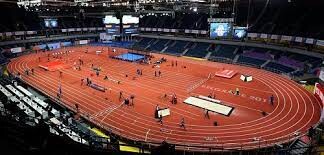
Heading into its seventh season, the World Athletics Indoor Tour will feature seven Gold level meetings in 2022, kicking off in Karlsruhe on 28 January and culminating in Madrid on 2 March.
With 50 days to go until the first Gold level meeting, athletes already announced include world pole vault record-holder Mondo Duplantis for the INIT Indoor Meeting Karlsruhe and the Müller Indoor Grand Prix in Birmingham, with Olympic 800m silver medallist Keely Hodgkinson due to join him in Birmingham. The Millrose Games is set to star Olympic 800m champion Athing Mu, two-time world indoor 800m silver medallist Ajee Wilson, Olympic shot put champion Ryan Crouser, world shot put champion Joe Kovacs and US 1500m champions Elle Purrier St Pierre and Cole Hocker.
The scoring disciplines on the World Athletics Indoor Tour rotate each year. For 2022 the Gold level scoring disciplines will be:
Women: 400m, 1500m, 60m hurdles, high jump, long jumpMen: 60m, 800m, 3000m/5000m, pole vault, triple jump, shot put
Each athlete’s best three results will count towards their overall point score. The athlete with the most points in each scoring discipline at the end of the tour will be declared the winner and will be awarded a USD$10,000 bonus along with a wild card entry for the World Athletics Indoor Championships Belgrade 22.
Each Gold meeting will offer at least USD$7000 in prize money for each individual discipline on the programme, including USD$3000 to the winner.
Silver meetings in the expanded tour will award at least USD$30,000 (at least $4000 per discipline and respecting gender equality) and Bronze meetings will offer at least USD$12,000 (at least $2500 per discipline and respecting gender equality).
Due to the pandemic, planned dates and venues could change as the season approaches. Broadcast details will be confirmed early in the new year.
Calendar – World Athletics Indoor Tour Gold
28 Jan – INIT Indoor Meeting, Karlsruhe, Germany29 Jan – Millrose Games, Manhattan NY, USA6 Feb – New Balance Indoor Grand Prix, Staten Island NY, USA17 Feb – Meeting Hauts-de-France Pas-de-Calais, Lievin, France19 Feb – Müller Indoor Grand Prix, Birmingham, UK22 Feb – Copernicus Cup, Torun, Poland2 Mar – World Indoor Tour Madrid 2022, Madrid, Spain
(12/12/2021) ⚡AMPby World Athletics
Five Tips to Avoid the Running Trots
No doubt the best of us have been in this situation and the only thing to do when, ahem, your lunch comes knocking is to start running towards the nearest toilet. Unfortunately, some of us don’t make it and for those of us who do, stopping mid run can be extremely painful. Not only because that new PB you were chasing will be long out of reach but because that feeling of starting to run after sitting or squatting to relieve yourself can be like knives in your calves. So what are these terrible runner’s trots? Why do they happen and how can you prevent them? TriChicks investigates with help from professional triathlete, Accredited Dietitian and nutritionist, and mum of two, Pip Taylor.
What are Runner’s Trots?
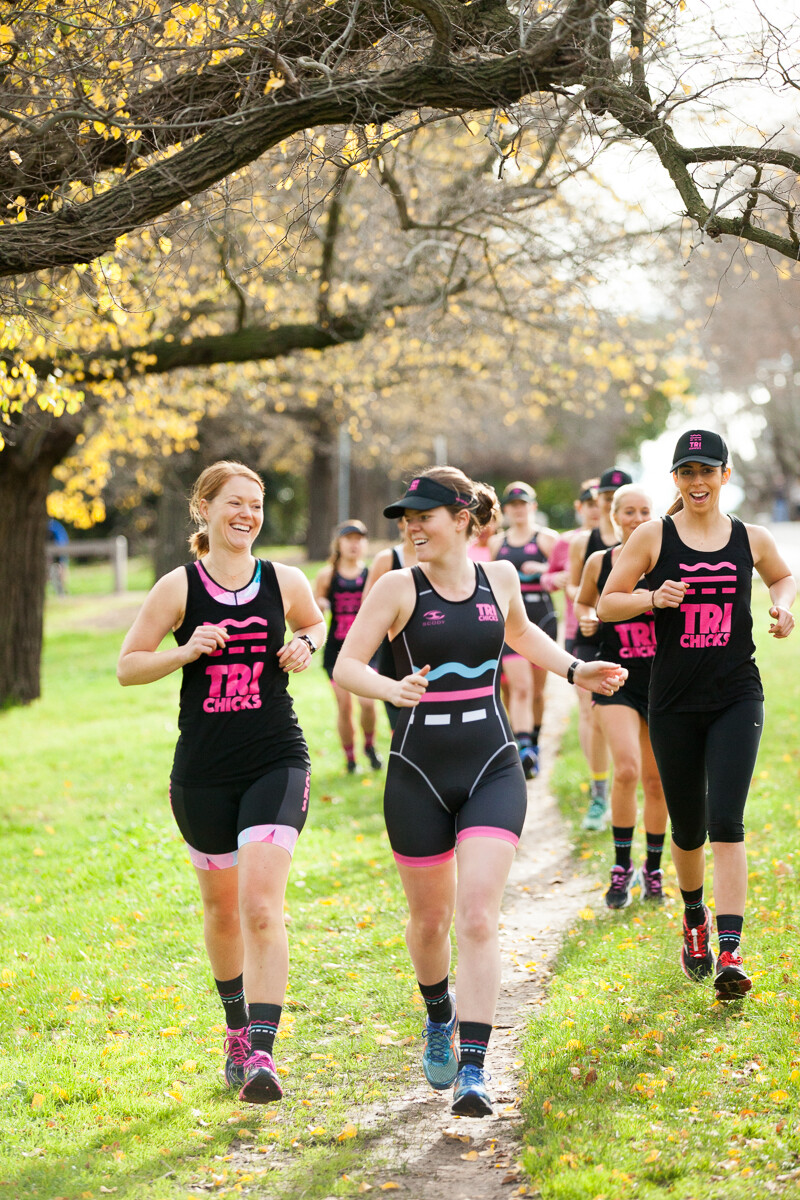
Simply put the term ‘Runner’s Trots’ covers any type of gastrointestinal issues or upset (GI). It can range from bloating and gasiness to vomiting, diarrhoea or urgency. However, when the word ‘trots’ is used it refers to issues of bowel movements and needing to make unplanned bathroom stops during or immediately after a workout.
Any type of athlete can be affected however runners experience this issue more commonly that other athletes. Estimates suggest that around 60-90% of runners have experienced GI issues.
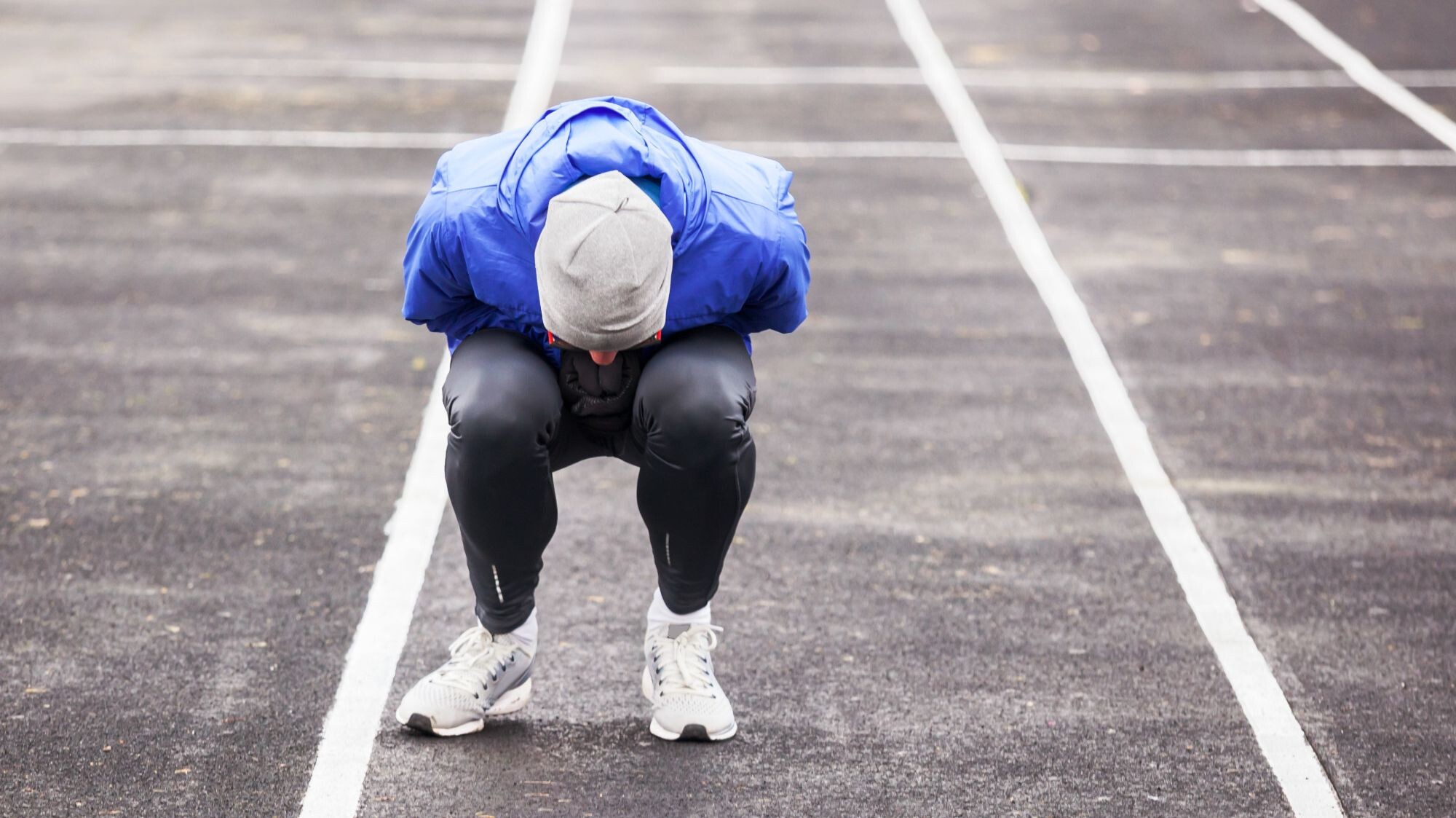
Why do they happen?
There are a number of reasons why you could be experiencing GI issues including stress, movement dietary intake and timing of intake, as well as unidentified food intolerances or sensitivities.
Hydration and heat also play a key role says Pip, “When we exercise, especially at a high intensity, blood is diverted away from the gut and towards working muscles and to the skin for more effective cooling. At the same time we have relaxation of the gut muscular tone by way of the sympathetic nervous system. This compromises the functioning of the gut but also rushes the contents through – hence that feeling of bathroom urgency.”
GI issues can occur in any sport for any athlete however runners are more prone to experience this type of discomfort. Running puts a lot of stress on the body not only from the intense vibration and jarring impact on the gut, but from the result of a high heart rate and increased body temperature.
Why does this happen to me?
Frequency of bowel movements varies for each individual and for some GI issues are something they regularly have to deal with while for others it may only be occasional.
“Race day also brings a whole new level of GI incidence and this is due to anxiety and nerves – the gut is affected hugely by stress as anyone knows who has ever experienced ‘butterflies’ or struggled to eat their pre-race breakfast due to nerves. But just because it is common doesn’t mean that you can’t try and figure out why it is occurring and take steps to reduce the likelihood,” says Pip.
How can I avoid them?
While there is no ‘cure’ as such Pip shares five key things you can do to lessen the chance of a mid run pit stop.
1.- Timing – Eating a meal too close or too large before a workout can be difficult for our gut to deal with, especially once blood flow is restricted. Analyse what you are eating pre-run, eat 1-2 hours prior, keep it simple and familiar.
2.- Overdoing concentrated sugars – This is a huge issue for many athletes, especially those worried about fuelling and who are sucking down on gels and washing down with sports drink. This combo will likely be too great a concentration in the gut and actually draw water back in – effectively dehydrating you and also leading to that feeling of ‘gut rot’ and bloating and/or urgency.
3.- Avoid certain foods – Foods rich in fat or fibre can be problematic for some, especially if this is different to what you would normally eat. Other dietary factors include lactose intolerance (and for many this is not an issue generally until you throw in the added stress of running/exercise); fructose malabsorption or intolerance; and sweeteners such as sorbitol or other carbohydrates that can be malabsorbed. Caffeine can also be an issue for some individuals and particularly if they have taken more than usual.
4.- Stay hydrated – Ensure you are hydrated, but not over hydrated as running with a full bladder can increase the urge, while dehydration slows the body’s ability to digest foods.
5.- Set a routine – As always practice makes perfect so adding in a food column in your workout spreadsheet can help you track what works vs what doesn’t work for you. Once you have found the foods which agree with your gut stick to them and don’t try anything new on race day.
(12/11/2021) ⚡AMPby Tri Chicks
British mountain guide James Gibson becomes first winter runner to complete Wainwright’s 214 peaks
On Dec. 1, James Gibson from Ambleside, U.K., set out to become the first person to run Wainwright’s 214 peaks in the winter. After 200 hours of running in blistery conditions, Gibson arrived back in the town of Keswick, U.K. on Dec. 9, to finish his journey and become the first man to complete this feat in the middle of winter. Gibson finished his record-setting journey in eight days, six hours and 44 minutes.
Here is the history behind the run: The Wainwrights consist of 214 mountain peaks inside Britain’s Lake District National Park – all peaks are taller than 1,000 feet (304 meters), except one.
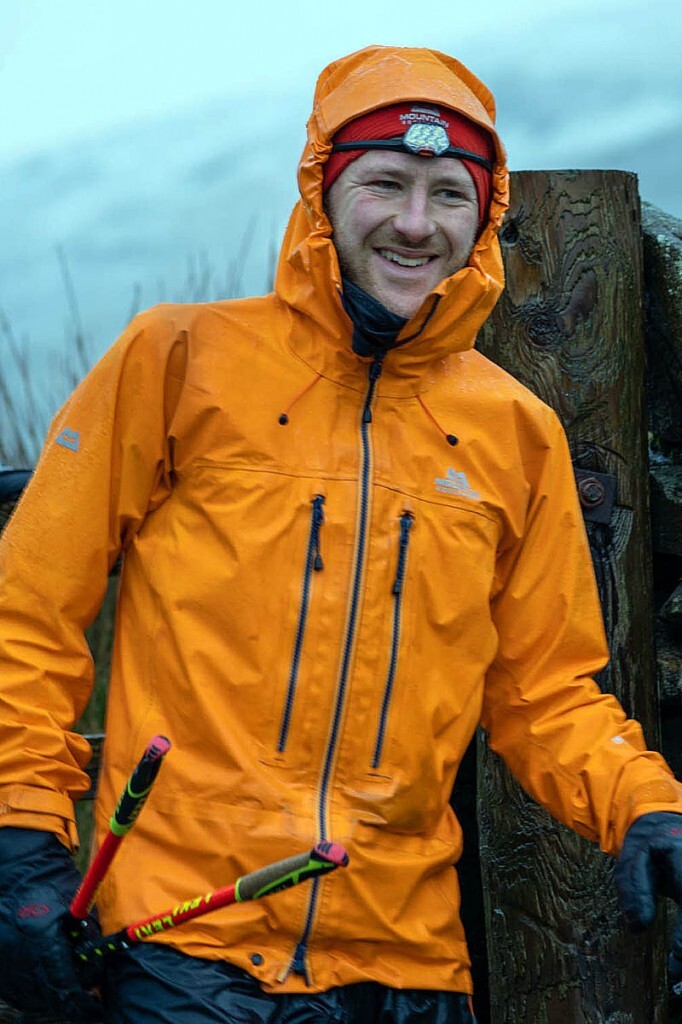
Traversing all the Wainwright’s in one consecutive run involves 523 kilometers of distance and ascending 36,000 meters. Since Alfred Wainwright’s Pictorial Guide to Lakeland Fells was published in the 1950s, summiting these peaks has become a goal for many British ultrarunners.
The rules of the Wainwrights record are simple: runners must start and finish in the town of Keswick, a town located in the national park, and they can take any route they like, as long as they summit each of the 214 peaks.

What made Gibson’s journey unique was the wind, rain, snow and ice he had to endure. A wicked snowstorm hit the coastal mountain range on the sixth day of his journey, resulting in him descending back to the valley. As the storm blasted through, Gibson and his crew resumed, trekking through a foot of snow. As Gibson reached the last peak, he celebrated with a beer before returning to Keswick to finish.
When he finished in Keswick, the previous Wainwright record-holders Steve Birkenshaw and Paul Tierney, who both ran this challenge in the summer, were there to greet him in the village. Gibson was supported by over 60 friends and local businesses that offered hospitality to him on the route.
(12/11/2021) ⚡AMPby Marley Dickinson
Do You Burn More Calories In the Cold?
Do we burn more or less energy running in the cold versus running in the heat, and should there be any relative change to our calorie intake?
If your body temperature drops during a run, you burn more calories as your body works to stay warm. However, after you warm up, you probably aren't burning any more calories than usual. Your energy needs don't change substantially unless you're extra-cold, which likely means you have underdressed.
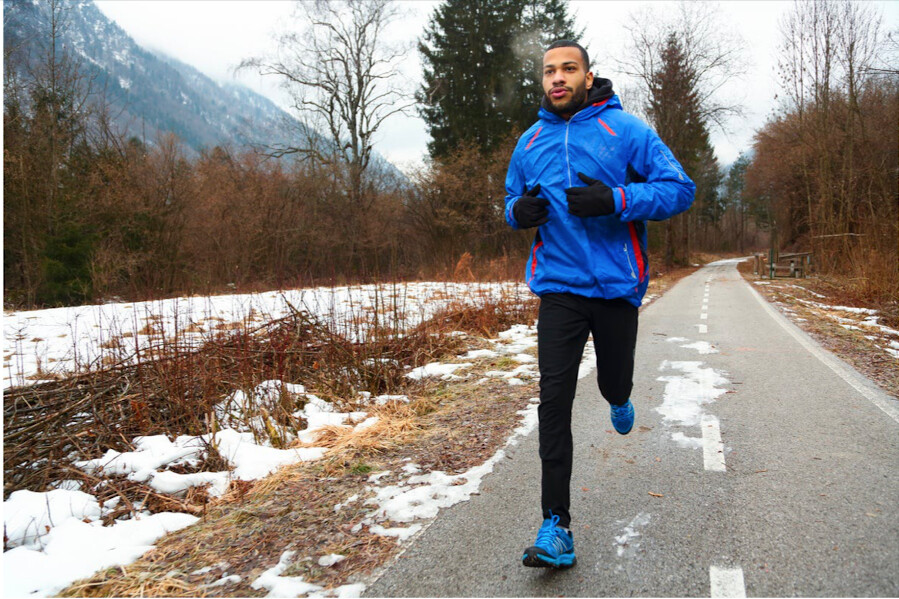
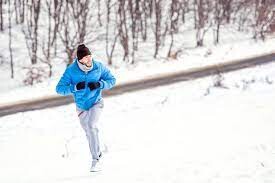
A 1991 article from the journal Sports Medicine titled "The Physiology of Exercising in the Cold" indicates that if you don't dress warmly enough you'll burn more carbohydrates relative to fat to stay warm.
All things being equal, you will likely burn a few more calories in cold weather. However, mid-run energy needs don't change appreciably. Think about a hypothetical runner doing a long run at aerobic threshold (where fat and carbohydrate use is around even); the runner starts with 1,000 calories of stored carbohydrates and burns 400 calories of carbohydrates per hour (along with a similar amount of fat). Even if they now burn 500 calories of carbohydrates in winter, they still have a couple hours of stored energy. Plus, most people can only absorb 200 to 400 calories per hour during activity, so taking in more won't make a huge difference.
As always, the golden rules of nutrition apply: find what works for your body, let hunger be your guide and maintain a general understanding of what is healthy for you based on your goals. Perhaps most importantly, remember that you still sweat in cold weather, especially if you dress well. Just as in hot temperatures, hydration is usually more important than fuel intake. Add some sports drink to the mix, and you'll probably be made in the shade (or in the cold).
(12/11/2021) ⚡AMPby Trail Runner Magazine
Keep Running Strong Through the Holidays With These 8 Tips
If you are feeling blah now that it’s colder and darker, use these tips to stay motivated.
No other time of year does fitting in a workout feel as daunting as trying to run during the holiday season. For many people, your routine is disrupted, it’s hard to stay on schedule, and it’s easy to think it’s just better to just bag it until after the first of the year and start fresh?
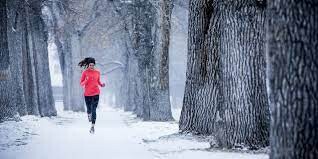

Running during the holidays can be challenging, yes, but it is possible. If you were to throw in the towel from Thanksgiving to the New Year, you could lose as much as one-third of your current fitness level, which would mean starting the conditioning process almost all over again when you begin fully training. And keep in mind that the holidays often mean more stress, too, so we actually need our running outlet more than ever this time of year.
We suggest developing some flexible training tactics that can help keep you on track any time of the year when things get hectic. Work, travel, family, and other obligations can affect our running any time, so it’s important for you to incorporate alternative training strategies for staying on the road even when things get crazy.
Here are nine of our best tips for running during the holidays and beyond.
Plan your runs for the week in advance
Look at your schedule, see what works, and write your runs in your planner. Having them written down makes it much more likely to happen. Heading into a new year might also be a good time to invest in a new journal for all your goals.
Focus on maintaining your current fitness level
Rather than trying to improve your fitness during a busy or stressful time of the year, just make it a goal to keep your baseline of fitness. Running three days a week for 20 to 30 minutes will maintain your current fitness level and help relieve stress until you are able to resume a heavier training load.
Another great option is to try keeping a streak going, like the Runner’s World Holiday #RWRunStreak from Thanksgiving to New Year’s Day, where all you have to do is put in at least a mile a day.
Adapt your training to fit your schedule
If you are struggling to run during the holidays, shorten the length or duration of your runs, alter the intensity, or change the frequency of your runs when necessary. When there is no time for a long run, speed up the pace for a short run. Or change up frequency when necessary, like run three to four times a week rather than five or six times a week, or, vice versa.
Go with the flow
Runners tend to love routine, but this can sometimes be a stumbling block to training during hectic times of the year. Try running at different times of the day and in different places to help running better fit into your day.
Find a race
Between Thanksgiving, Christmas, and the New Year, there are many races of all distances available. (You can find a lot with the .) When traveling for work or the holidays, a race is a great way to get a run in, see the area, and participate in holiday festivities and check out the local running scene. You can also use to time to choose an event to target for spring. Having a goal race on the calendar can help with motivation to run consistently through the holidays and other busy times of the year.
Make your run social
Meet up with your friends for a run before heading to happy hour. And during the holidays, you could plan a run through neighborhoods with festive lights and decorations so you know there is something to see along the way.
Set a different goal
Target something completely different, like a trail race, an obstacle course race, or a new distance to inspire you and help keep you out there when life gets challenging.
Team up
If you’re looking to add structure, join a training program, a running club, or try an online program to help provide you with structure and a plan to follow.
(12/11/2021) ⚡AMPby Runner’s World
You Should Be Mindful of These 5 Things When Coming Back From a Winter Run
Establishing a short post-run routine can be the small detail that helps you recover faster and stay injury-free.
You are at the two-week mark of the Winter #RWRunStreak, and by now, you may already have settled into a rhythm that gets you going day after day. If you’re running in cold weather, you already know how to warm up, stay warm, and motivated. But what you do for winding back down after a run can be the secret sauce to staying on track with your streak—or whatever you’re training for right now.

If you haven’t yet adopted a self-care ritual, developing a cooldown routine is equally as important as what you do before or during your run. So, dedicating time to properly cool down by stretching, rehydrating, and massaging your sore muscles is a great way to make sure you’re ready for your next run—no matter how long or short it is.
Here is a short list of things to be mindful of when coming back from your next run.
Don’t run door-to-door
As much as you might want to plop down onto a couch, taking a few minutes to walk after a run is a must. For example, if you do a 5-mile run, Janet Hamilton C.S.C.S, and owner of Run Strong in Atlanta tells Runner’s World, “You might walk for two and a half to five minutes after your run—just strolling around to get your body back down to its prerun metabolism—to get your heart rate back down and get your respiration rate down.”
Allowing your body to sync back to this normal resting rate, smoothly and naturally, will be better for your overall recovery and cardio health.
“There are a lot of benefits of the body coming back to homeostasis—back to its starting baseline—that you don’t want to rush through,” Theresa Toczylowski, physical therapist and Run Clinic supervisor at MossRehab near Philadelphia, tells Runner’s World.
Change your clothes
If you’re coming inside from running in the cold, it’s likely that you’re sweating under all those layers, even if you don’t feel it initially. Depending on how long you’ve been out, you might want to rush inside to change your clothes and warm up as quickly as possible.
“When I run in the cold my favorite thing to do is to come in and take a shower, get a hot beverage—hot chocolate, hot cider, hot coffee—something warm in my body,” Hamilton says.
Hydrate and refuel
“One thing to remember is we still sweat in the winter, especially if we have overdressed or completed a tough workout. Rehydrating and replacing our electrolytes remain important throughout the winter months,” says Lisa Braden, a registered dietitian who works with endurance runners.
For longer runs, Braden suggests refueling and hydrating within the first hour to help you recover faster. “It doesn’t take much, but a little goes a long way. Ideally, 200 to 300 calories at a 3:1 carb to protein ratio,” for a snack she says. Also, whether you run one mile or five, getting in the proper nutrients this time of year will be helpful in fight of the cold and flu. “Sickness spikes in the winter, so staying healthy with nutrient-rich foods can keep you from catching germs and disrupting your training,” Braden said.
Hit the shower
How hot or cold you take your shower after a run can impact your recovery. Experts have long debated over the benefits and disadvantages of both hot and cold-water therapy. A 2018 meta-analysis published in the Frontiers in Physiology journal highlighted cold water immersion as an effective way to reduce inflammation. While there aren’t many studies that highlight hot water as a recovery technique for runners, Hamilton says the runners she works with tell her they prefer soaking in cool water rather than hot because they feel like they bounced back quicker.
“I would say stay somewhere in the middle,” Toczylowski says, “not too hot and not too cold, either one is going to stress your system.” However, if you still want to take a quick cold bath—five or 10 minutes—to help your muscles recover, you can. Hamilton suggested warming up a towel, grabbing a hot drink, and jumping right in. To make the experience more tolerable, “climb in, and wrap that hot towel around your shoulders.”
Don’t forget to stretch and massage
Your postrun stretch routine is going to depend on how many miles you logged. For shorter distances—at least a mile for run streak—Hamilton says stretching immediately after is the way to go. But if you’re running for longer distances, she says it’s better to wait. “While it’s always advisable to stretch while you are warm because that’s a little easier on your muscles, stretching when you’re fatigued puts you at a little bit of a disadvantage,” Hamilton says. “Your muscle can’t sustain the strain as easily as it could if it had a chance to recover.” So for longer runs like 15 miles or more Hamilton suggests waiting one to two hours before stretching.
If you’re feeling sore, thank your muscles for all their hard work with a self-massage. A massage gun or “the foam roller may help with some blood flow, it may feel pretty good, but don’t go in there and beat it up,” Hamilton says.
(12/11/2021) ⚡AMPby Runner’s World
Al Franken, West Coast sports promoter, dies at 96
Al Franken, who promoted track and field, golf and tennis on the West Coast during a long career in sports, died Wednesday. He was 96.
He died at his home in the Westwood section of Los Angeles from acute myeloid leukemia that was discovered recently, according to his son Don.
Franken co-founded the Los Angeles Invitational track and field meet held at the old Los Angeles Sports Arena in 1960. It was held indoors in February and televised nationally, serving as an elite-level stop between the Millrose Games in New York and the U.S. indoor national championships. It was known as the Sunkist Invitational until 1995 because of its sponsor Sunkist Growers. It continued until 2003, when it was canceled for lack of sponsorship.
Franken hustled to recruit stars and sponsors. He stirred up interest by offering $500,000 to any athlete who broke a world record.
The meet also featured top high school runners. More than 100 Olympic gold medalists competed during its existence.
Franken also coordinated indoor meets in San Francisco and San Diego. He helped develop the Kinney High School Cross Country Championships into a major event
He was the Los Angeles Lakers’ first public relations director when the team moved west from Minneapolis.
Franken handled PR for the Los Angeles Open golf tournament for 22 years, as well as assignments for the men’s and women’s pro tennis tours.
He founded Franken Enterprises in 1952 and World Class Sports in 1982 to promote and market track and field.
Franken graduated from UCLA, where he was sports editor of the Daily Bruin newspaper. He later worked as a sports writer at the Los Angeles Mirror.
Besides his son, he is survived by daughter Jill Franken. He is not related to the former U.S. senator from Minnesota who shares his name.
(12/10/2021) ⚡AMPEliud Kipchoge would like to become first athlete to three-peat in the Olympic marathon
World Athletics sat down with the marathon world record holder and double Olympic marathon champion Eliud Kipchoge, to reflect on his great career. Kipchoge cited his previous Abbott World Major Marathon wins, his world record and running the first sub-two-hour marathon (unofficially) as things he joyfully looks back on.
When asked about his future goals, he said he wants to become the first athlete ever to win three straight Olympic gold medals in the marathon.
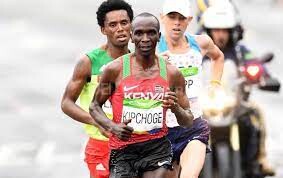
“My goal going into the 2020 games was to win back-to-back Olympic golds, and I’d like to win the third one,” Kipchoge said to World Athletics. He also mentioned other goals on his running bucket list, such as running all six Abbott World Marathon Majors and lowering his half marathon personal best.
If Kipchoge defends his title at the 2024 Paris Olympics, he would become the first-ever athlete to three-peat. Currently, he is in an exclusive club of three, the other two athletes being Abebe Bikila of Ethiopia (who won gold at both the 1960 and 1964 Games) and Waldemar Cierpinski of East Germany (who won gold at the 1976 and 1980 games, but it’s been highly speculated that he was part of East Germany’s state-sponsored doping program during the 1970s).
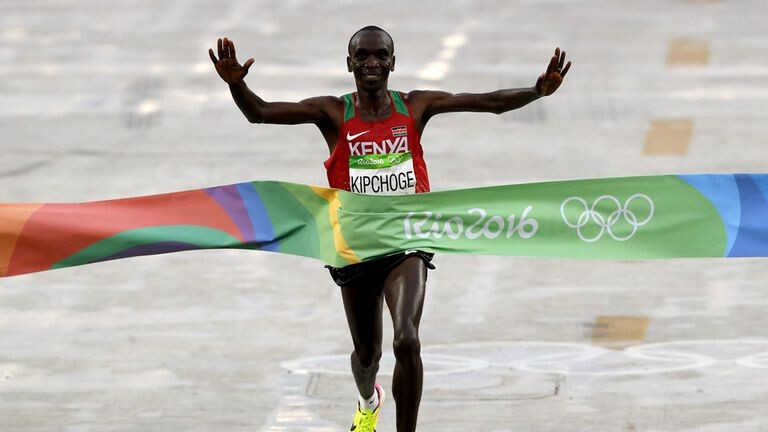
When he was asked about giving the world record another shot, Kipchoge said, “There are many people who could break my marathon world record. I think Geoffrey Kamworor will one day break the world record. Joshua Cheptegei will also make his mark in the marathon, and Kenenisa Bekele is still there.”
As his 2021 season comes to an end, Kipchoge isn’t sure of his 2022 race plans. “I always strive to improve my fitness, and I approach it like education. For example, if you have an exam in two years, you have to plan carefully for it to have success.”
(12/10/2021) ⚡AMPby Marley Dickinson
Paris 2024 Olympic Games
For this historic event, the City of Light is thinking big! Visitors will be able to watch events at top sporting venues in Paris and the Paris region, as well as at emblematic monuments in the capital visited by several millions of tourists each year. The promise of exceptional moments to experience in an exceptional setting! A great way to...
more...Strong field will be competing in 2022 Hardrock 100, with a lottery narrows field to 145
The Hardrock 100 ultramarathon held its lottery on Saturday to select runners to fill out its field of 145.
The race had 1,916 runners apply from 46 states and 50 foreign countries this year, which is slightly down from the roughly 2,200 applicants in 2019. The ages of the applicants ranged from 19 to 73, and the largest group was 40 to 49 years old, or 43% of the total.
New this year is a gender-equity provision, guaranteeing the percentage of women in the field at least equals the percentage of women who applied. So, since 345 women applied, representing 18% , 27 women were selected to participate.
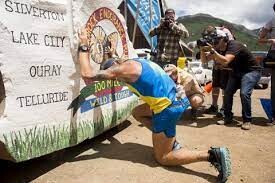
“I thought the gender equity worked out well,” said race director Dale Garland. “The lottery is designed for gender equity and also to make it accessible to new runners and people who have been here before. Both are important.”
Because of COVID-19, international runners who were chosen for the previous year’s event but were unable to travel in 2021 gained an automatic entry for the 2022 race, which includes 16 men and two women.
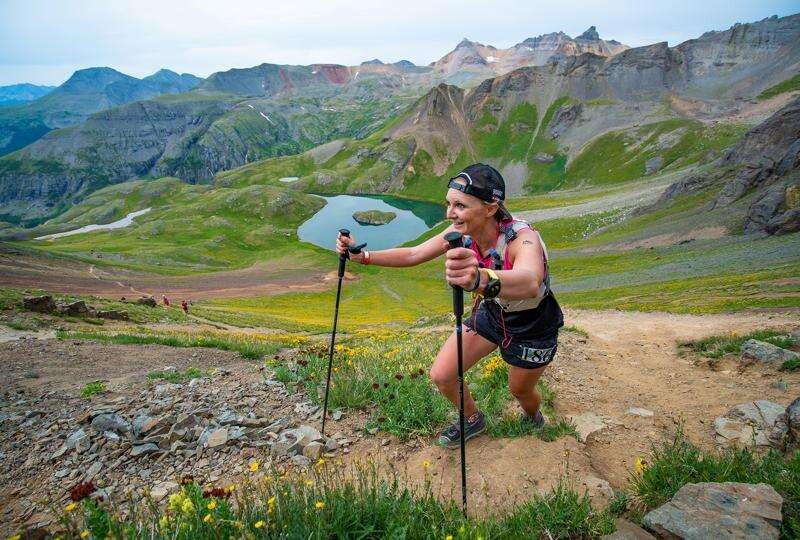
Automatic entry goes to last year’s winners – Sabrina Stanley, a two-time champ, and Francois D’Haene, who set a course record last year. D’Haene also won the Ultra Trail du Mont Blanc last year in Chamonix, France.
Garland also got to choose six entries, which are kept secret. He said, however, that his picks this year are elite runners, some runners who have provided service for the event and two with good storylines.
After that, 119 runners were selected in the lottery. To be eligible for the lottery, the athletes had to complete one of 30 qualifiers around the world that are all at least 100 miles long.
“I’m really happy with it,” Garland said this year’s field of athletes. “There’s some interesting competitive story lines, some competitive longevity story lines, and we’re seeing some people who have run in 10 or 15 Hardrocks.
Killian Jornet, a four-time Hardrock champion, will race again this year. Aurélien Dunand-Pallaz, who finished second at the Ultra-Trail du Mont-Blanc last year, also is expected to compete for the title.
In the women’s race, Courtney Dauwalter, an Ultra Trail du Mont Blanc winner in 2019 and 2021, will challenge Stanley. “It will be an interesting dynamic to have those two run,” Garland said.
Darcy Piceu, an eight-time Hardrock finisher with three wins, also will be in contention, as will Meghan Hicks, a top-three finisher from last year who lives in Silverton, like Stanley.
Neal Matosky of Durango and Durango High School graduate Dakota Jones also will compete.
“I wouldn’t be surprised to see (Jones) in the top 10,” Garland said.
The race takes place July 15-17. It will start at 6 a.m. on July 15, and the runners will have 48 hours to complete the race. It will start at Silverton and go to Telluride first this year, then Ouray, close to Lake City and finish in Silverton. The first race was held in 1992 and this will be the 27th running of the event. Snow and fires caused a few to be canceled.
Volunteers are needed for the event. For information, visit hardrock100.com.
(12/10/2021) ⚡AMPby Cody Olivas
Hardrock 100
100-mile run with 33,050 feet of climb and 33,050 feet of descent for a total elevation change of 66,100 feet with an average elevation of 11,186 feet - low point 7,680 feet (Ouray) and high point 14,048 feet (Handies Peak). The run starts and ends in Silverton, Colorado and travels through the towns of Telluride, Ouray, and the ghost town...
more...Join us in central London next year!
While yesterday’s news about the move to Plan B wasn’t what any of us wanted to hear, we’re staying positive and looking ahead to next spring and the Vitality London 10,000.
As you’ve told us you’re interested in the event, we bring you good news: it will be back on its central London course on Bank Holiday Monday 2 May 2022 – and entries are open now!
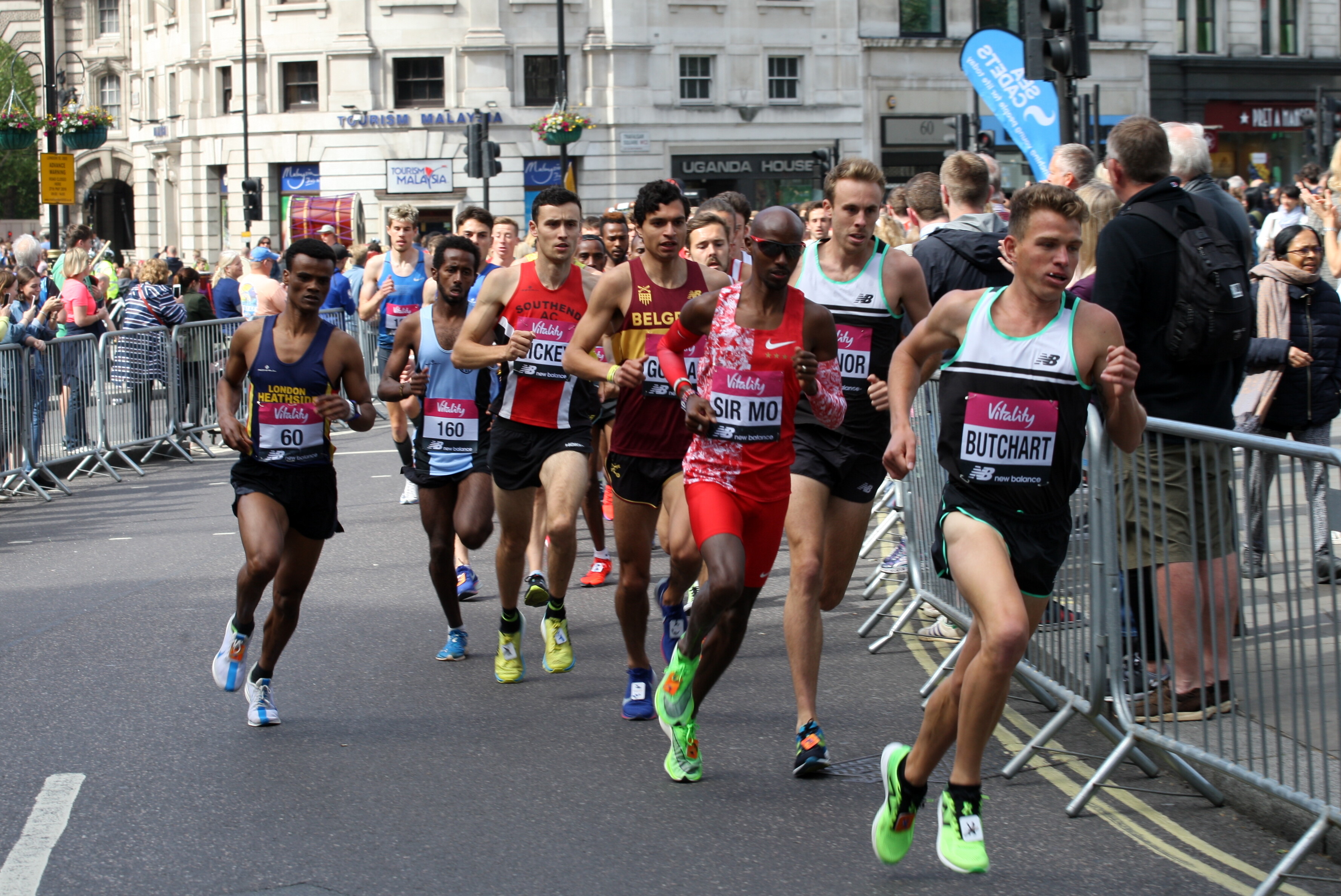
It’s your chance to set yourself a goal that’ll help you keep moving during the dark winter months while also enjoying the mental and physical health benefits of exercise.
It’s been more than 1,000 days since we were last able to hold the event in the capital and we can’t wait to return.
There’s nothing quite like the feeling of running past some of the most famous sights in the city – including St Paul’s and the Houses of Parliament – surrounded by people with the same aim as you: to get to the Finish Line (and have fun of course)!
So enter now and begin the new year on a high, with a fun and achievable goal to aim for and something to look forward to in the spring.
See you on the Start Line!
(12/10/2021) ⚡AMPVitality London 10,000
The Vitality London 10,000 takes you past many landmark sites, including the London Eye, Buckingham Palace and the Bank of England – so you even get to do a bit of sightseeing along the way! You will run alongside elite runners and have coverage from the BBC, making this 10km one of the highest in profile of its kind....
more...How to hill train without a hill, you can still prepare for a hilly race, even if you live somewhere flat
We talk a lot about the benefits of hill running, but if you live in a flat area, what are you supposed to do? Not every neighbourhood has its own version of heartbreak hill, but that doesn’t mean runners who live there can’t still simulate the benefits of hill training.
If you’ve got a hilly race coming up on the calendar and nowhere to train for it, use these alternatives to be ready for it.

You may not have any big hills nearby, but if you have a good set of stairs at your disposal, they make an excellent alternative. This one’s easy if you live in an apartment building, but if you have a stadium nearby with bleachers, that works too. Depending on the size of the staircase, you can simply run to the top, jog (carefully) back down and repeat, but if the staircase is particularly long, you could break it up however you like (for example: 2 minutes hard, 1 minute easy).
One of the big benefits of hill training is it improves your strength and power so you can run faster and stronger on the flats. You can make similar gains in the gym as well. Mimic hill training indoors with explosive movements like box jumps, jump lunges and jump squats, and improve your ability to handle the pounding associated with downhill running by doing lots of eccentric contractions, where you’re slowing down the movement while you lengthen the muscle (as you lower yourself into a squat, as you’re jumping back down off of the box, etc.).

Add some surges to your run
Olympic gold medal winner Frank Shorter once said “hills are speedwork in disguise,” so if you don’t have a hill nearby, try adding some one-minute or 30-second surges every three or four minutes during a tempo run. This forces you to change up your gait in a similar way as if you were tackling a hill in the middle of your run.
Hop on the ‘mill
Love it or hate it, the treadmill is an excellent tool to train hills when you don’t have a hill nearby. All you have to do is crank up the incline, and you’ve got a great hill workout without going anywhere.
(12/10/2021) ⚡AMPby Brittany Hambleton
The Bank of America Chicago Marathon Announces Field of 40K Runners for 2022
The Bank of America Chicago Marathon on Thursday announced its field for the 2022 race, bringing back 40,000 runners to Chicago streets after hosting a smaller field in 2021.
Runners who entered the non-guaranteed entry drawing for the 2022 race were notified of their status Thursday.
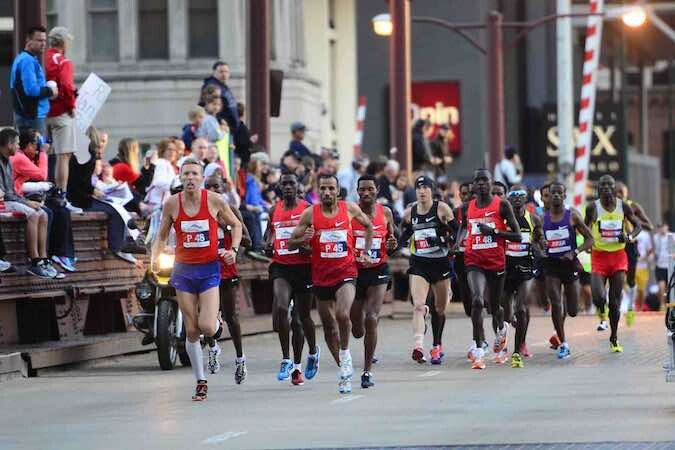
Guaranteed runners already in the lineup include Chicago Marathon and Shamrock Shuffle legacy finishers, time qualifiers, international tour group participants, charity runners and those who deferred or cancelled entries from a previous event.
"Today, we celebrate the commitment made by our newest field of competitors, alongside the continued dedication and support of our volunteers, spectators and community members,” Marathon Race Director Carey Pinkowski said in a statement. “The Bank of America Chicago Marathon has always been the people’s race. They helped to create the tradition and they will be a part of the comeback as we embark on the next chapter in the event’s history.”
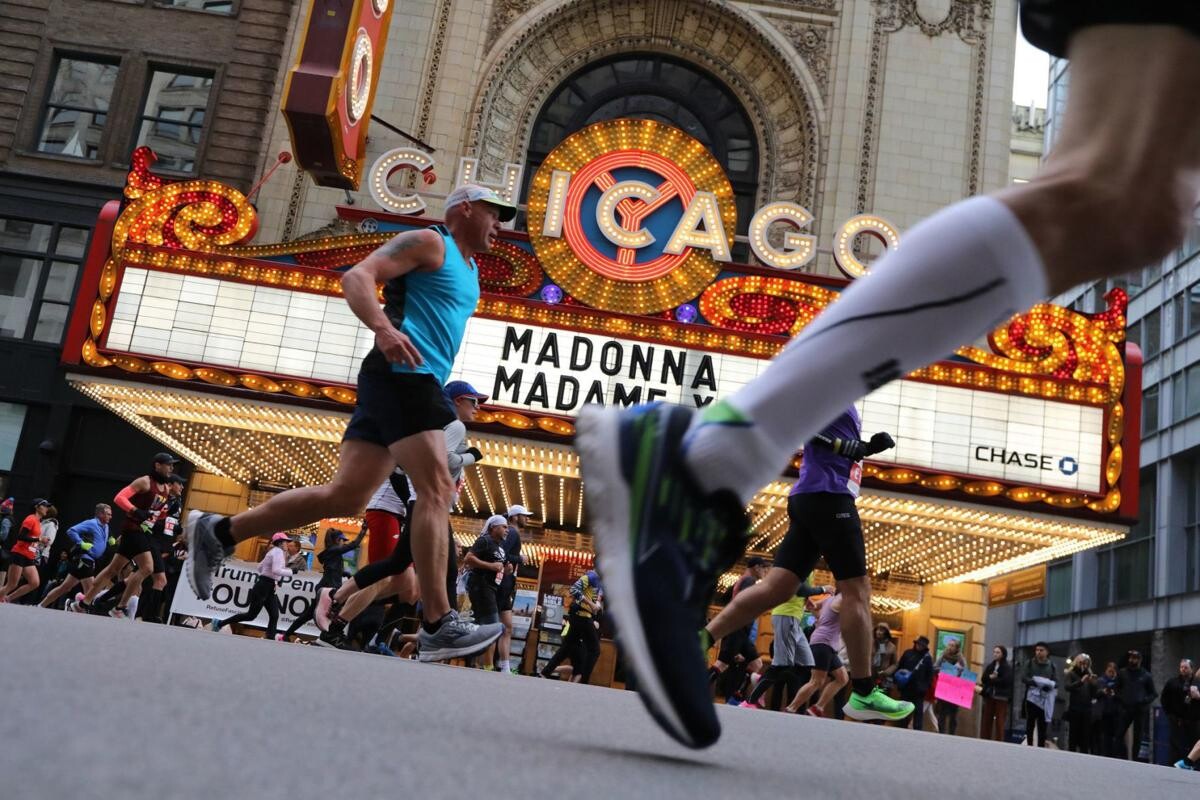
But it won't be the last chance for runners to enter.
Organizers noted that those still hoping to participate in next year's event will be able to join an official charity team, with more than 170 nonprofit organizations currently raising funds in 10 different categories. Runners who register with one of those charities will need to raise a minimum of $1,750.
So far, the race plans to nearly double the number of runners from last year's event, which saw 26,109 participants cross the finish line. Organizers said health and safety plans will be released in the months before the race.
(12/10/2021) ⚡AMPBank of America Chicago
Running the Bank of America Chicago Marathon is the pinnacle of achievement for elite athletes and everyday runners alike. On race day, runners from all 50 states and more than 100 countries will set out to accomplish a personal dream by reaching the finish line in Grant Park. The Bank of America Chicago Marathon is known for its flat and...
more...Lawrence Cherono receives State Award
Recently crowned Valencia Marathon champion Lawrence Cherono has urged young athletes to work hard and be patient, and success will come their way.
Speaking in Kabarnet, Baringo County while receiving his Head of State Commendation through the County Commissioner Henry Wafula, the 2020 Tokyo Games Olympiad, said he trained for many years before breaking into the limelight.
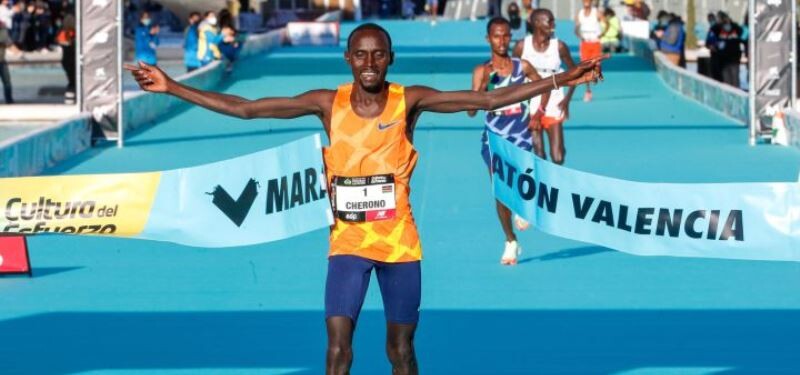
“I want to thank President Uhuru Kenyatta for the award I have received. I also want to encourage upcoming athletes to continue training hard because in athletics, one might take long before excelling," said Cherono.
“In my case, it took me five years to get on the podium and 10 years to be in the national team,” the 33-year-old runner said.
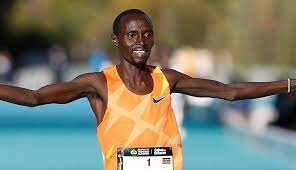
Cherono donned the Kenyan colours for the first time at the Tokyo 2020 Olympic Games where he finished fourth in the men’s marathon race in Sapporo.
He was one of the athletes honoured by President Kenyatta on Mashujaa Day.
Cherono, who trains under the Rosa Associati Management, is currently ranked as the eighth fastest marathoner of all time in the world.
He has won a couple of major marathons including Chicago and Boston and was recently crowned the Valencia Marathon champion.
The Kaptagat-based athlete on Sunday timed 2 hours, 05 minutes and 12 seconds ahead of Ethiopia’s Chalu Deso who was second in 2:05:16 while Kenya’s Philemon Kacheran finished third place in 2:05:19.
The women category saw Nancy Jelagat cross the line in 2:19:31 ahead of Ethiopians Woldu Etagegne (2:20:16) and Degefa Beyenu (2:23:04) who came in second and third respectively.
Cherono, who won the 2019 Boston and Chicago marathons, said that he will be taking the Christmas break as he waits for his manager to decide on which races he will feature in next year.
Wafula asked upcoming athletes to emulate Cherono by working hard and focusing on their careers for better results.
“Cherono is a good example to youth who are training in this region and they should follow his example because nothing comes easy,” said Wafula.
(12/09/2021) ⚡AMPby Bernard Rotich
VALENCIA TRINIDAD ALFONSO
The Trinidad Alfonso EDP Valencia Marathon is held annually in the historic city of Valencia which, with its entirely flat circuit and perfect November temperature, averaging between 12-17 degrees, represents the ideal setting for hosting such a long-distance sporting challenge. This, coupled with the most incomparable of settings, makes the Valencia Marathon, Valencia, one of the most important events in...
more...Honolulu Marathon is ready to host 14,000 runners this weekend
Rain or shine, the Honolulu Marathon is on at 5 a.m. sharp Sunday with no capacity limits.
Dr. Jim Barahal, chief executive officer of the Honolulu Marathon Association, has dealt with more than a year of much uncertainty due to the COVID-19 pandemic — but took a leap of faith that the race could be staged this month.
Despite the detection of the omicron variant in Hawaii, plus financial loss due to a drastic drop in runners from Japan, Barahal is determined to move ahead, pointing to the overall event as a symbol of triumph over adversity.
Barahal said he feels confident that outdoor activities are safe, based on guidelines from the U.S. Centers for Disease Control and Prevention, and that the marathon, which has about 14,000 registered participants across three events over the weekend — down from about 35,000 in 2019 — also will be safe.
“We’re excited,” he said. “We think a lot of people in the community are going to celebrate with us. When the gun goes off and fireworks go up in the sky, we’re going to send a signal that Hawaii is back.”
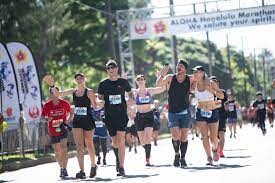
Dozens of marathons around the world have been staged this year, he noted, including major races in Boston, London and New York City. Last year’s Honolulu Marathon, along with scores of other races, was staged virtually, with participants submitting images from completed runs.
Some 10,000 participants are signed up for the 26.2-mile race, which starts on Ala Moana Boulevard and ends at Kapiolani Park. Most are local runners, while only a few hundred will be coming in from Japan. The rest are signed up for the Kalakaua Merrie Mile on Saturday and the Start to Park 10K on Sunday.
Historically, according to Barahal, half of early registrants do not show up, so organizers are expecting about 7,000 participants. “This is going to be primarily a local event,” he said, adding that he believes it will be the largest since the pandemic started.
There is going to be a financial hit, he admitted, with at least an 80% decline in revenue. The marathon gets no funding from the city, state or visitor industry.
There was no significant boost in registrations after Hawaii opened up to international travelers last month, according to Barahal, who did not expect one with the short window of time. There will be about 400 runners from Japan this year compared to 17,000 in past years. Mizuno and Japan Airlines have stayed on as sponsors.
“We’re ready to go. We have budgeted the event, we have cut where we need to, but nothing that compromises safety,” he said, adding, “To not do it two years in a row would threaten the existence of it.”
The marathon’s largest fixed costs, which include securing the course with special duty officers, barricades and the use of timing chips, will still be covered, he said, but some bells and whistles such as the video screen and photo bridge at the finish line have been dropped.
There will still be malasadas for finishers, but no live entertainment along the route or at Kapiolani Park.
The marathon is now open to fully vaccinated participants and those who show proof of a negative COVID-19 test taken within 48 hours of the event. Barahal estimates about 90% of registered runners are fully vaccinated.
Participants older than age 12 need to bring photo ID and proof of COVID-19 vaccination or negative test when picking up race packets at the Honolulu Marathon Expo at the Hawai‘i Convention Center on Friday and Saturday.
Masks will not be required while running, and under the most recent easing of restrictions, staggered starts are no longer limited to 200 participants at a time. Runners will be separated based on projected times, but the goal is to get as many on the course as quickly as possible, Barahal said.
(12/09/2021) ⚡AMPby Nina Wu
Honolulu Marathon
The Honolulu Marathon’s scenic course includes spectacular ocean views alongside world-famous Waikiki Beach, and Diamond Head and Koko Head volcanic craters.The terrain is level except for short uphill grades around Diamond Head. ...
more...The easiest gifts for runners this Christmas
If there is a runner in your family who hasn’t sent you their Christmas list yet, don’t worry, we have you covered. You shouldn’t stress about buying Christmas gifts for runners, as they are the easiest demographic to shop for. Here are a few ideas.
Stance performance socks
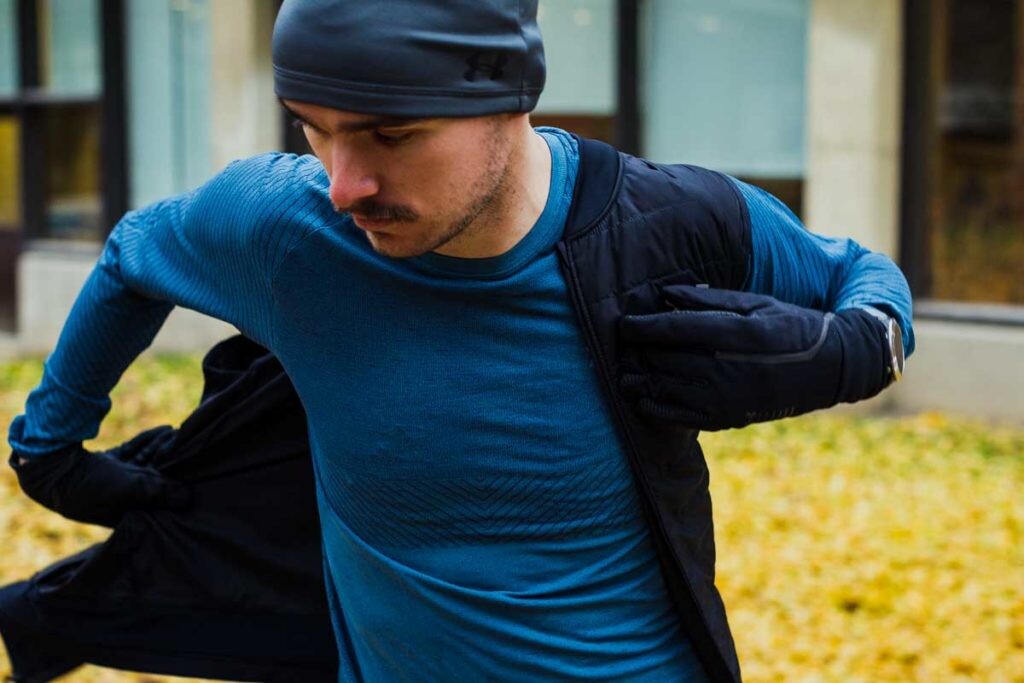
Runners can never have too many pairs of socks. Stance socks are made of a performance polyester called ‘FEEL360,’ a sewn fibre that reacts to your body’s temperature for high-performance comfort. They also feature moisture-wicking technologies guaranteed to keep you feeling fresh and dry in the summer heat and warm in the winter. A bonus is that these socks can be purchased in unique colours and designs, such as, Wu-Tang Clan, Forrest Gump and Bob Marley styles. Stance socks range from $25 to $45 per pair and can be purchased online at MEC.
A nice pair of running gloves

A runner truly appreciates a nice pair of running gloves to get them through the winter. The run liner gloves from Under Armour are a great base layer for your hands. They’re form-fitting, light and stretchy, with the right warmth when temperatures are below zero. These gloves have water and wind-resistant panelling on the front and a plush interior for the right amount of warmth. They’re also touchscreen-friendly, allowing you to use your phone without having to take your gloves off.
Smartwool merino men’s sport boxer brief
Men, it’s time to upgrade your running underwear this Christmas. These performance-style briefs are designed to help you operate in comfort regardless of the conditions. They feature a double front panelling designed to provide extra support down low, and sewn with a flatlock seam to eliminate chafing. These briefs are made to help keep you cool and dry while you’re out for a long winter run. Smartwool boxer briefs can be purchased online at MEC.
Petzl Bindi headlamp (200 lumens)
Light up the night sky with the Bindi headlamp from Petzl. This headlamp is ultra-compact and ideal for training in everyday urban environments. The headlamp has a range of 40 metres and is convenient to charge via a micro USB port. The Bindi headlamp is minimalist, yet functional, combining style and performance. The headlamp retails at MEC for $59.95.
Hydration is important all year for runners. They need an electrolyte mix to replace the nutrients lost in sweat during exercise. Skratch sports mix has a light, easy-drinking taste. The Skratch powder is non-GMO, non-dairy and gluten-free, so it will be easy on the stomach during or after a run. You can purchase Skratch online or at your local independent running retailer or MEC, prices ranging from $19.99 to $69.99
(12/09/2021) ⚡AMPby Marley Dickinson
Toronto’s Bernard Abarquez completes 42 marathons in 42 weeks
Abarquez began the challenge on his 42nd birthday in February 2021 and averaged 3:17 marathons for 42 straight weeks.
Forty-two weeks ago, Toronto’s Bernard Abarquez began the remarkable challenge of running 42 marathons in 42 weeks to celebrate his 42nd birthday. On Sunday, Dec. 5, Abarquez completed his challenge in the heart of Toronto, running 17 2.5-kilometer loops around Exhibition Place, joined by many members of the Toronto running community.
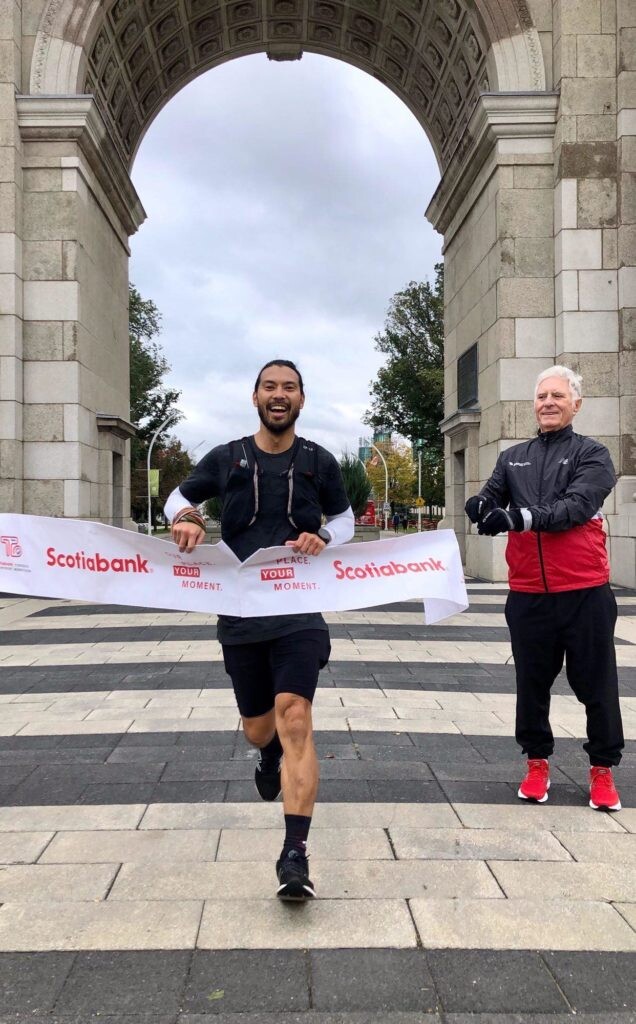
Instead of approaching running from a competitive perspective, Abarquez’s journey led him to a new source of fulfillment: inspiring others to look past limitations through running. Abarquez got the idea for Project42, having run ‘birthday mileage’ on his previous birthdays.
His goal for his 42nd birthday was to run a sub-three-hour marathon, but his planned races were postponed due to the pandemic. After chatting with some of his friends in his Everyday Fit Social Club, Abarquez started Project42.
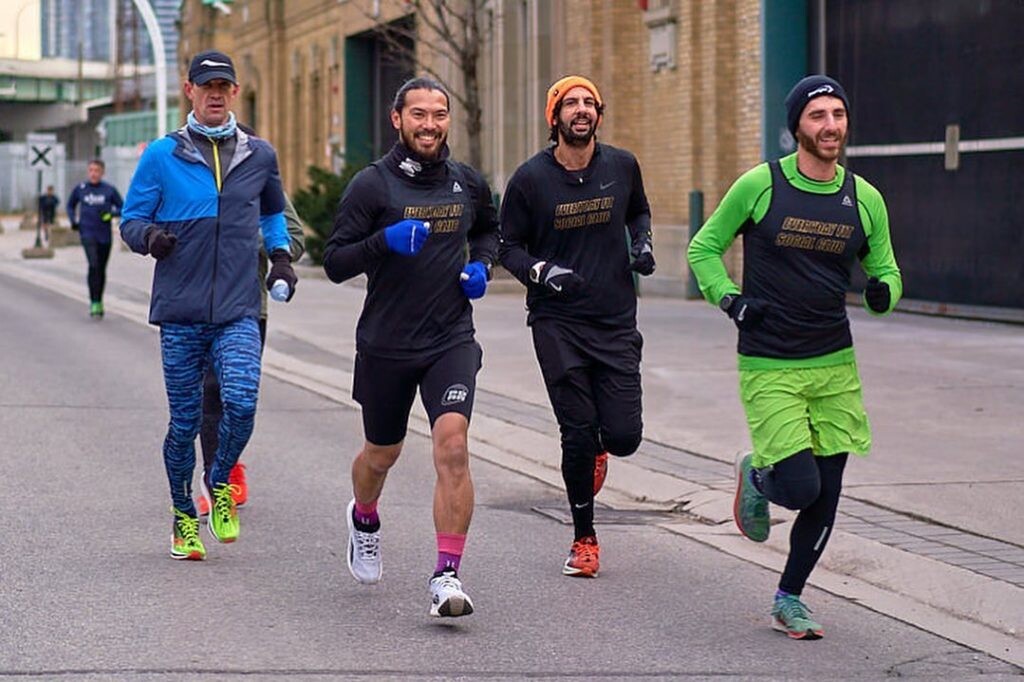
At the start of his project, Abarquez was only running once weekly for his marathon, but as weeks passed, he gained fitness and started to add a few shakeout runs and workouts into his weekly mileage. Abarquez changed up the scenery on a few of his runs, completing marathons in towns across Ontario in Sauble Beach, Hamilton and Brighton.
As races began to open up with the easing of the pandemic restrictions, Abarquez completed three in-person marathons, achieving his Boston qualifying time and sub-three-hour goal at the Muskoka Marathon in October.
“At the start of the challenge, running 42 marathons was daunting,” Abarquez says. “I began to approach every run with excitement and told myself to take things one marathon at a time.” As he began sharing his journey on social media, many runners in the Toronto community started to get behind his project. “Every run I would show up at, people were genuinely excited for me, which kept me positive throughout my challenge.”
Abarquez began running seriously in 2015, but since then, the unofficial Toronto running ambassador has completed multiple marathons and run as a pacer for several more. An accomplishment he’ll never forget is when he finished his first 100-miler. “The ultra community taught me to be optimistic – everyone in an ultra race wants you to succeed,” says Abarquez.
“I had fears of course, and at the start, I wasn’t sure if I could do this,” says Abarquez. “There was never a day I didn’t want to be out there, running.” Several sponsors were on board alongside Abarquez for Project42, including Rally Beer, Nuun Hydration, Reebok, Undefined (socks) and Endurance Tap fuel. His friend Saul Weiss supported Abarquez on the bike for 36 of his 42 marathons and ran the entire distance himself on two occasions.
Throughout the project, Abarquez supported Hospice Toronto, a non-profit organization providing palliative care for terminally ill patients. He also contributed towards the Scarborough Health Network, which helped his cousin beat cancer 11 years ago.
In terms of what’s next for Abarquez, he plans on changing his running shoes to snowshoes this winter as he plans to run a self-supported snowshoe marathon.
(12/09/2021) ⚡AMPby Marley Dickinson
Joint Discomfort: What Can Be Done?
At a younger age, the human body is stronger and more vibrant. As one grows older, however, it is not unusual to start experiencing bodily discomforts and diminished overall strength. Flexibility also suffers the aging blow, which is why you will often see older folks looking a bit stiff and slow. For the same reasons, many people also experience joint pain as they approach their sunset years.
Now, joint pain affects around a third of adults, with the knees, shoulders, and hips being the most commonly affected areas. Alongside the pain, joint pain is often accompanied by discomfort, soreness, and a decreased range of movement. These aches and pains aren’t always ailments that can be treated. That is to say, the most we can do is learn to handle and cope with the pain. With that in mind, let’s look at how you may effectively deal with joint pain.
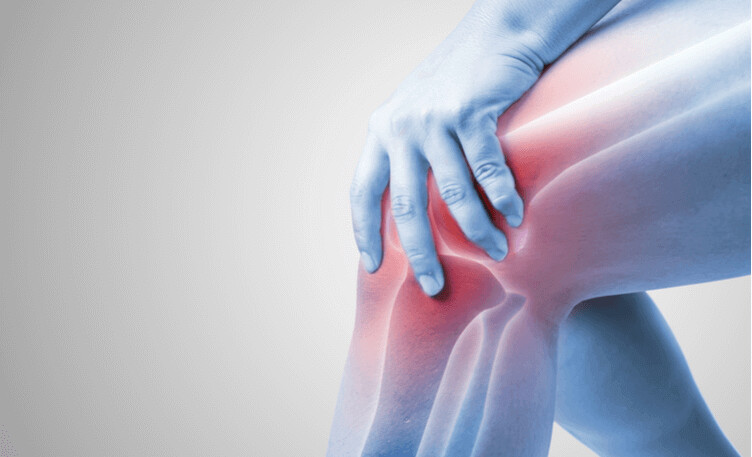
Physical Therapy and Support Devices
There are a variety of ways you can get relief from joint pain without taking medicine. For starters, excessive strain on your knees from excess weight could be the source of your knee pain. As a result, lowering weight can be an excellent way to help ease your pain, and this is also where knee braces come in. To make your knees even stronger while soothing the pain, knee braces can help. If you read full article coverage by Adam on the Best Knee Braces, you will learn the different types of knee braces for different situations. This will help you decide if you need one and which one you should get.
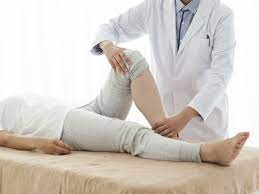
All the same, physical activity can help alleviate weight loss while easing knee pain. Exercising and eating a nutritious diet at the same time can help you reach your ideal weight. Cycling, swimming, and jogging are all low-impact exercises that can help you manage your joint pain. High-impact exercises, on the other hand, should be avoided because the strain will exacerbate the pain. You can get expert advice on the finest types of exercise to participate in.
Medication
If you’ve been suffering from joint pain for a while, you should be aware that there are many types of joint pain. The discomfort can be minor at times and intense at other times. Anti-inflammatory medicines, either over-the-counter or prescribed, can help you deal with moderate-to-severe joint discomfort and swelling.
Aspirin, celecoxib, ibuprofen, and naproxen are examples of these medications. Because of the numerous cases of joint pain, these medications are widely available in any pharmacy. However, you should be aware that some of these medications have side effects. This is why it is preferable to obtain these medications with a prescription from a licensed physician.Acetaminophen can be used to relieve minor discomfort that is not accompanied by significant edema. However, you must exercise extreme caution when using these medications because large doses might cause drug-induced liver damage, especially if you drink alcohol. You’ll need stronger medicines if you have significant joint problems. This necessitates the use of more potent opioids. However, because these drugs are known to cause drowsiness, this is why you must obtain them with a doctor’s prescription.
Home Treatment
Joint discomfort, as previously stated, can be a major annoyance, causing you agony and lowering the quality of your life. Depending on the causes and type of joint pain you are suffering from, it pays to know how to handle discomfort. Aside from medication and physical therapy, there are a few low-cost activities you can do to alleviate joint discomfort. Take a look at the following home treatment routines:
Oftentimes, you will find that joint pain is worse in the evenings or after strenuous activity. Participating in these activities will only exacerbate the pain. As a result, if you have frequent joint problems, you should try to rest as much as possible. It’s also a good idea to avoid any activity that causes the pain. This will substantially assist you in dealing with the pain.
If you have a sore injury, ice can help relieve the pain by numbing the nerves in the area. Your joints can be treated in the same way. You can relieve pain by icing these joints for around 15 minutes multiple times.
Supporting or wrapping the afflicted joint can help with the pain. This can be done when the discomfort is significantly worse than usual. The bandage will keep the joint from moving, reducing pain.
Elevating your joint above the level of your heart can offer some relief from pain. Elevating an injury above the level of your heart reduces swelling by allowing fluid to flow away from the affected area.
Joint discomfort can have a significant impact on one’s quality of life. This is especially true if you have no notion of how to handle it. While medication is one option, you should also be aware of the various alternative strategies for dealing with aching joints.
(12/08/2021) ⚡AMPby Colorado Runner
Do you need to drink electrolytes in the winter?
Hydration is top of mind for most runners during the hot summer months, but when the winter rolls around, our concern for staying hydrated tends to drop along with the temperature.
While you may be sweating less when it’s cold out, maintaining your fluid and electrolyte balance during the winter is still important if you want to feel and perform at your best.
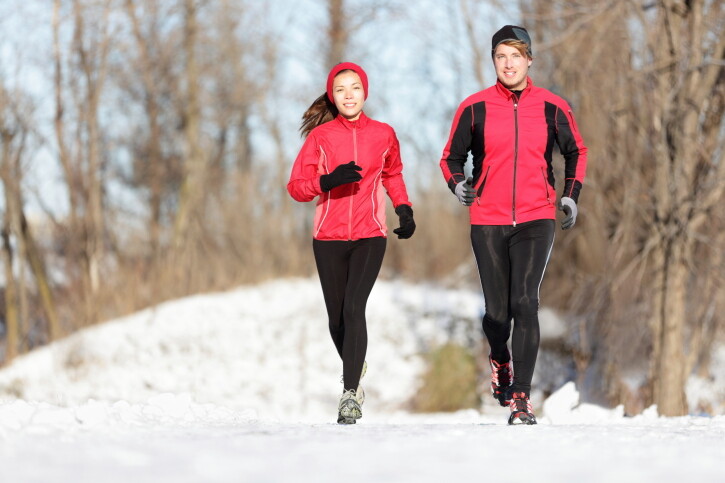
Dehydration can sneak up on you in the cold weather
In the colder weather, we don’t experience the same psychological and physiological triggers to remind us to drink water, but that doesn’t mean we don’t need to drink. In fact, there are several ways winter conditions can actually make you more dehydrated.
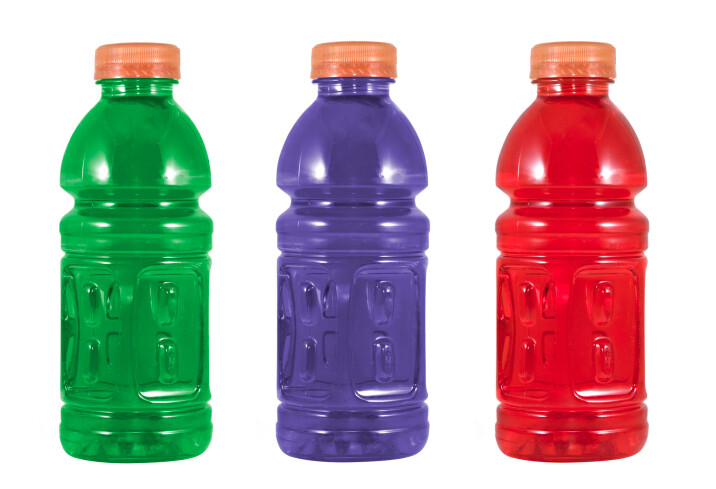
Cold, dry air: Cold air contains less moisture than warm air, so your lungs actually have to moisturize the air every time you take a breath. On top of that, when you’re not out for a run, you’re likely spending most of your time in heated buildings, which can also be very dry during the winter months. These dry conditions rob the body of a tiny bit of water every time you inhale, which can add up over the course of a run.
Sweat evaporation: Sweat evaporates very quickly in the cold, so you arrive at the end of a run with relatively dry clothes compared to the summer. This can give you a false impression of how much you were actually sweating during your run, so you may not think you need to drink a whole lot to replace what you’ve lost.
Cold diuresis: Your blood flow is constricted in the winter, which can cause your blood pressure to increase. To counteract this increase, your body tries to rid itself of some of the water in your blood by increasing urine output, which can contribute to dehydration.
Do you need electrolytes in the winter?
With all of that in mind, the rules around hydration in the winter are not that different from the rules in the summer. You may, however, need to be more intentional about your fluid intake during the winter because it’s easy to forget you need to hydrate when you’re not a sweaty mess at the end of every run.
Just like in the summer, when your run is less than an hour, water is just fine for replacing fluid lost through sweat and respiration. If you’re running for more than an hour, you should rehydrate with an electrolyte beverage to replace sodium, potassium and other electrolytes lost through sweat. There are plenty of great hydration products on the market, and if you’re struggling with muscle cramps during your runs or you’re simply feeling sluggish and tired every time you lace up your shoes, dehydration or an electrolyte imbalance could be the culprit.
(12/08/2021) ⚡AMPby Brittany Hambleton
Andrew Oberle runs marathon nine years after being mauled by chimpanzees
He was told that he would never be able to run again after the chimpanzee attack.
On the tenth anniversary of his first marathon in 2011, Andrew Oberle of St. Louis, Mo., returned to the Rock ‘n’ Roll San Antonio Marathon eager to complete his second. This year’s marathon was meaningful for Oberle, as his athletic ability was set back nine years ago while volunteering with animals in South Africa. Oberle was viciously mauled by chimpanzees and was left in critical condition, fighting for his life.
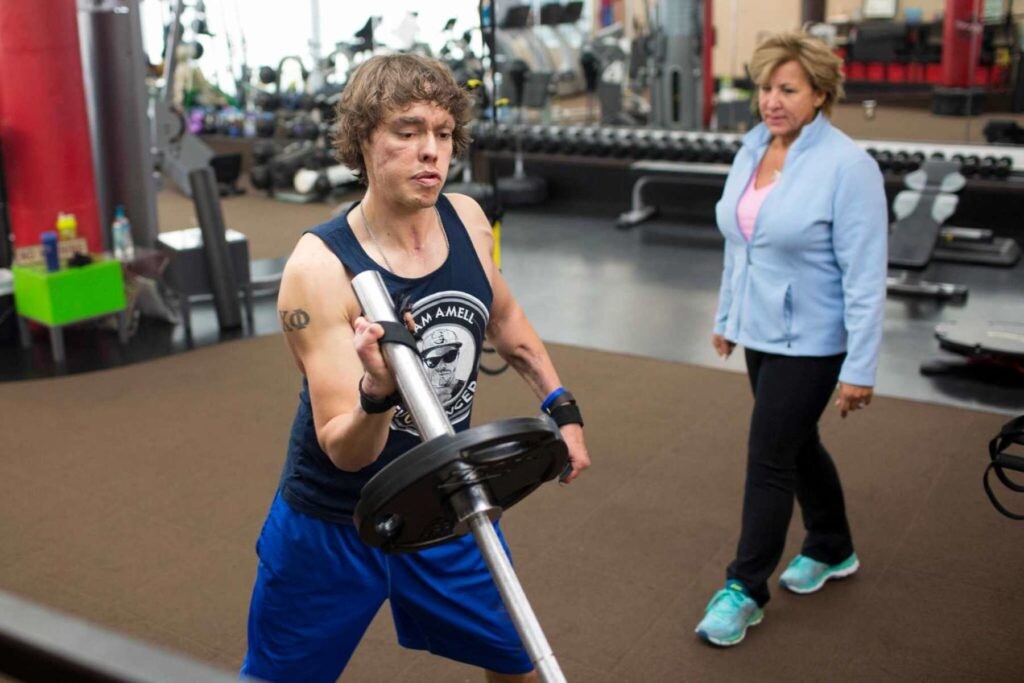
Although Oberle has always shown an interest in running, he was told he would never be able to run again. At the 2021 San Antonio Marathon, he redefined the odds finishing in 5:57:55, with the help of modern-day prosthetics.
The attack shredded parts of his nose, ears, hands and feet, requiring him to be put in an induced coma for two weeks and endure 26 surgeries. Oberle now sports a collection of carbon-fibre prosthetics on his hands and legs to assist him during exercise.
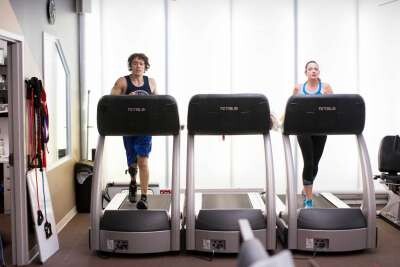
During his rehabilitation process, Oberle was inspired by Paralympians at the London Olympics. In a 2017 interview with Men’s Health, Oberle said that he was lying there after his accident feeling sorry for himself, but seeing Paralympians doing incredible things with far worse injuries motivated him to get back to his active lifestyle.
Oberle began running again three years after his surgery in 2015 at a local 5K, where he placed third in his 25-29 age category in 31:50. He also ran the half marathon at the 2020 Rock ‘n’ Roll race weekend, finishing in a time of 2:42:07.
(12/08/2021) ⚡AMP
by Marley Dickinson
Rock N Roll San Antonio
Take a running tour through San Antonio with live entertainment along the course. Then celebrate your finish with a festival, beer garden and headliner concert! The end of fall 2019 brings the 12th annual running of San Antonio’s Rock ‘n’ Roll Marathon & Half Marathon, which — like its counterparts in San Diego and Virginia Beach— features live bands to...
more...More than 50 years after winning the first Dallas Marathon, Annabelle Corboy is set to participate in the half marathon
The 74-year-old will be participating in the half-marathon at the 50th running of the Dallas Marathon.
Fort Worth resident Annabelle Corboy will be the first to tell you she is nothing special when she laces up her running shoes.
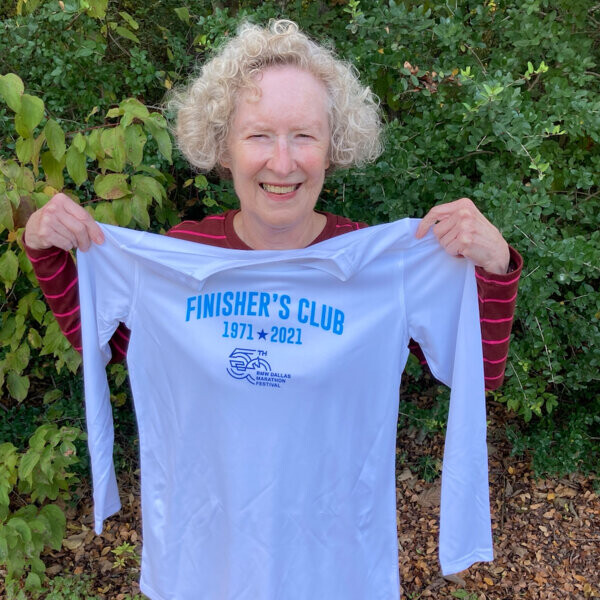
“Let me make sure it’s clear: I am an average runner,” Corboy told The Dallas Morning News. “My main claim to anything is that I’ve been running a long time, and I’ve been lucky to not have been injured and so forth.”
That first statement may be true, but the second is not entirely accurate. She does have another claim to fame.
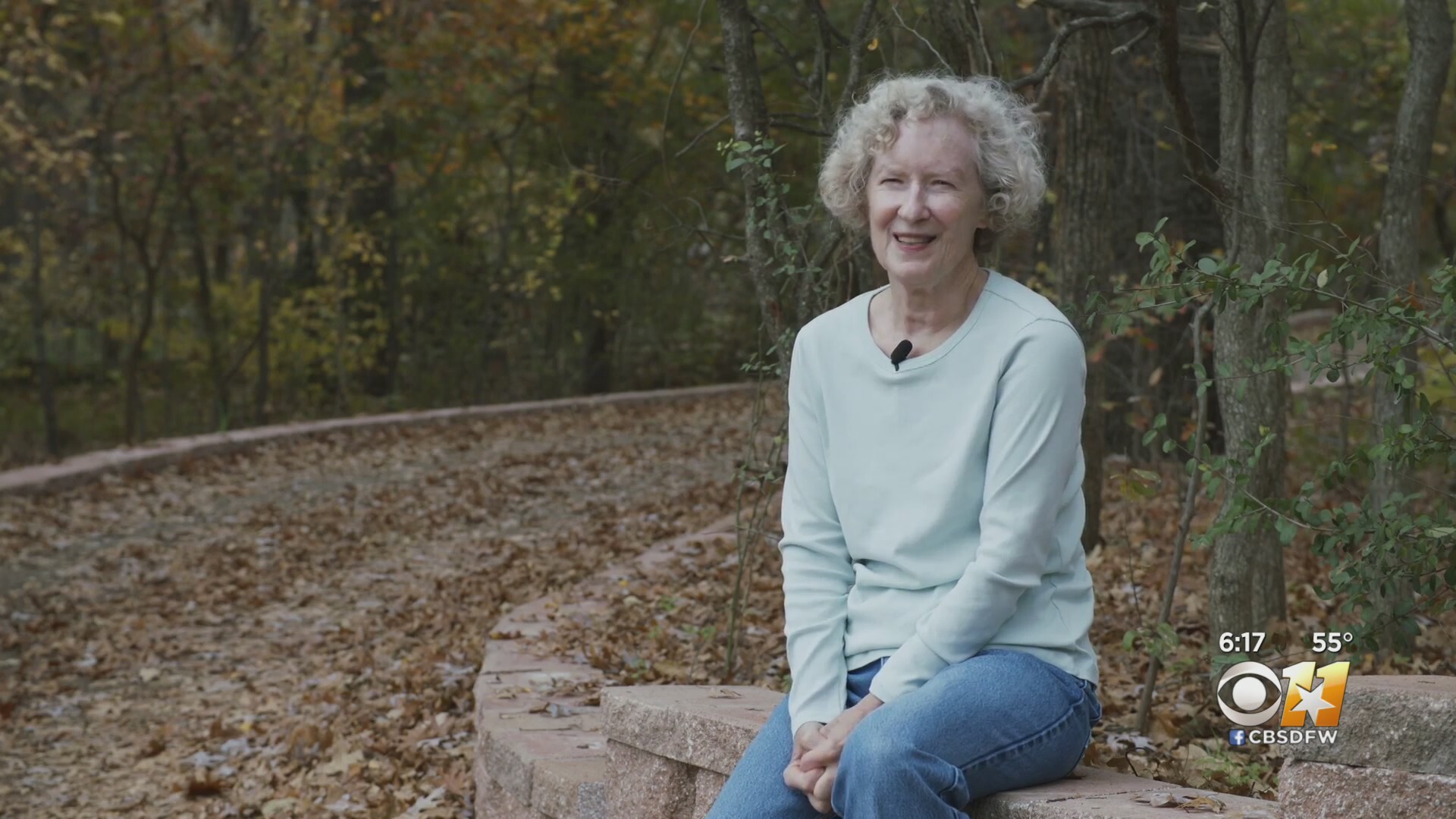
Corboy was one of 82 participants in the first Dallas Marathon, then called the White Rock Marathon, on March 6, 1971. And she crossed the finish line that day with a time of 4:12:25, becoming the first woman winner of the event.
“For a very, very, very short time, I was a very, very, very minor celebrity,” Corboy said. “I got a couple of letters in the mail, fan letters telling me how proud they were of me.”
More than 50 years after winning the first Dallas Marathon, Corboy will be participating in the festivities once again this Sunday. The 74-year-old will be participating in the half-marathon at the 50th running of the Dallas Marathon.
“It’s pretty amazing,” Corboy’s husband, Mike Poteet, said. “Fifty years of running is a lot of running.”
Kenneth Cooper, the aerobics pioneer, inspired Corboy to start running when she was around 20 years old. At 21, Corboy spent a year earning a master’s degree in mathematics at the University of Illinois.
The school had a fitness program that gave Corboy a really good start in running. When she returned to the D-FW area, she started looking for a club to join to help her continue to run and found the Cross Country Club of Dallas, where she became an involved member.
Tal Morrison was a founder of the Cross Country Club of Dallas and the founding father of the Dallas Marathon. When the first marathon was being planned and prepped, he recruited runners for the event, including Corboy.
She recalls him as eager to get a woman to participate in the race and asked her to run it. Corboy said she had probably never run more than about 10 miles, let alone a marathon, before when he asked.
“He and I ran around the lake, maybe did a 16-mile run, a couple of weeks before the race, and he said, ‘You know, what’s 10 more miles anyway?’” Corboy said. “He talked me into it.”
Of the 82 race participants that first race day, two were women. Corboy was the lone female finisher of the 61 people who completed the race. By comparison, in 2019, the last time the event was held, there were about 2,300 finishers, 770 of whom were women.
Over the years, Corboy continued to run in the marathon, although she did not make it an annual occurrence. She has also run the relay and half-marathon events at the Dallas Marathon.
Corboy did not travel much for her races. She ran the first Cowtown Marathon in 1978 and ran the Houston Marathon a few times. The last marathon she ran was the 2005 Boston Marathon after she was offered a spot in it by a friend.
She never won another race after the 1971 Dallas Marathon but has finished as an age-group winner at multiple events.
Corboy wasn’t planning on running at the marathon this year until she realized it was the 50th running of the event. The symmetry of saying she ran at an event at the first marathon and at the 50th is exciting.
“In spite of the fact that I insist that I’m an average runner, I have spent a lot of hours of my life running,” Corboy said. “It is something that means a lot to me. To be able to kind of look back and say, yeah, I’ve done this for 50 years, it’s something I am proud of.”
(12/08/2021) ⚡AMPby Peter Warren
BMW Dallas Marathon
The BMW Dallas Marathon is the result of the efforts of a pioneering group of brave Dallas runners, who had the foresight to establish an annual 26.2-mile race more than 40 years ago. In 1971, Tal Morrison – the official founding father of the marathon – placed a $25 ad in Runner’s World beckoning runners from around the country to...
more...Athing Mu and Ajee Wilson set to clash over 800m at Millrose Games
Organizers of the Millrose Games have announced that Olympic champion Athing Mu will take on world bronze medalist Ajee Wilson in the 800m at the World Athletics Indoor Tour Gold.
Aged just 19, Mu has this year established herself as the best 800m runner in the world and was undefeated at the distance indoors and outdoors. She won Olympic gold in Tokyo, breaking Wilson’s US 800m record, and then earned a second gold medal in the 4x400m. She went on to lower the US 800m record to 1:55.04 when winning at the Wanda Diamond League meeting in Eugene.
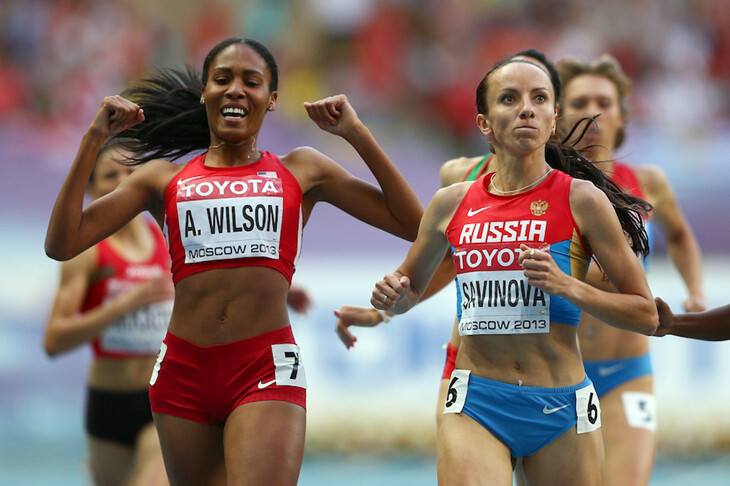
“Millrose is the ideal place to begin my season,” said Mu, who last week was named by World Athletics as the 2021 Female Rising Star. “The audience brings great energy and I always look forward to the atmosphere and competing at The Armory – It's iconic.”
Wilson, a six-time Millrose Games champion, has not lost at this meeting since 2013. Wilson broke her own US indoor record at the 2020 Millrose Games, clocking 1:58.29.
“It's been a while,” Wilson said, referring to last season’s cancelled Millrose Games due to the pandemic. “I'm super excited to return to The Armory for the Millrose Games.”
World and Olympic finalist Natoya Goule-Toppin, the Jamaican record-holder indoors and outdoors, will join Mu and Wilson in the 800m at the Millrose Games.
These 800m stars are the latest big names to be announced for the Millrose Games, following the recent confirmations of Olympic shot put champion Ryan Crouser, world shot put champion Joe Kovacs and US 1500m champions Elle Purrier St Pierre and Cole Hocker.
(12/07/2021) ⚡AMPby World Athletics
NYRR Millrose Games
The NYRR Millrose Games,which began in 1908 as a small event sponsored by a local track club, has grown to become the most prestigious indoor track and field event in the United States. The NYRR Millrose Games meet is held in Manhattan’s Washington Heights at the New Balance Track & Field Center at the Armony, which boasts a state-of-the-art six-lane,...
more...The best pacing strategy for every distance
Most of the work that goes into running a personal best happens before the race — you train, you focus on proper recovery and you eat well. The final piece of the puzzle happens during the race, specifically, how you pace yourself to get to the finish line as fast as possible.
A good pacing strategy can be the difference between a PB and going home disappointed, so make sure you get it right if you want to have success the next time you toe the start line.
If you’re racing a 5K
In general, most experts agree the best pacing strategy for any distance is to be as even as possible, but in a shorter race like a 5K, you have a little more room to play around with your pace.
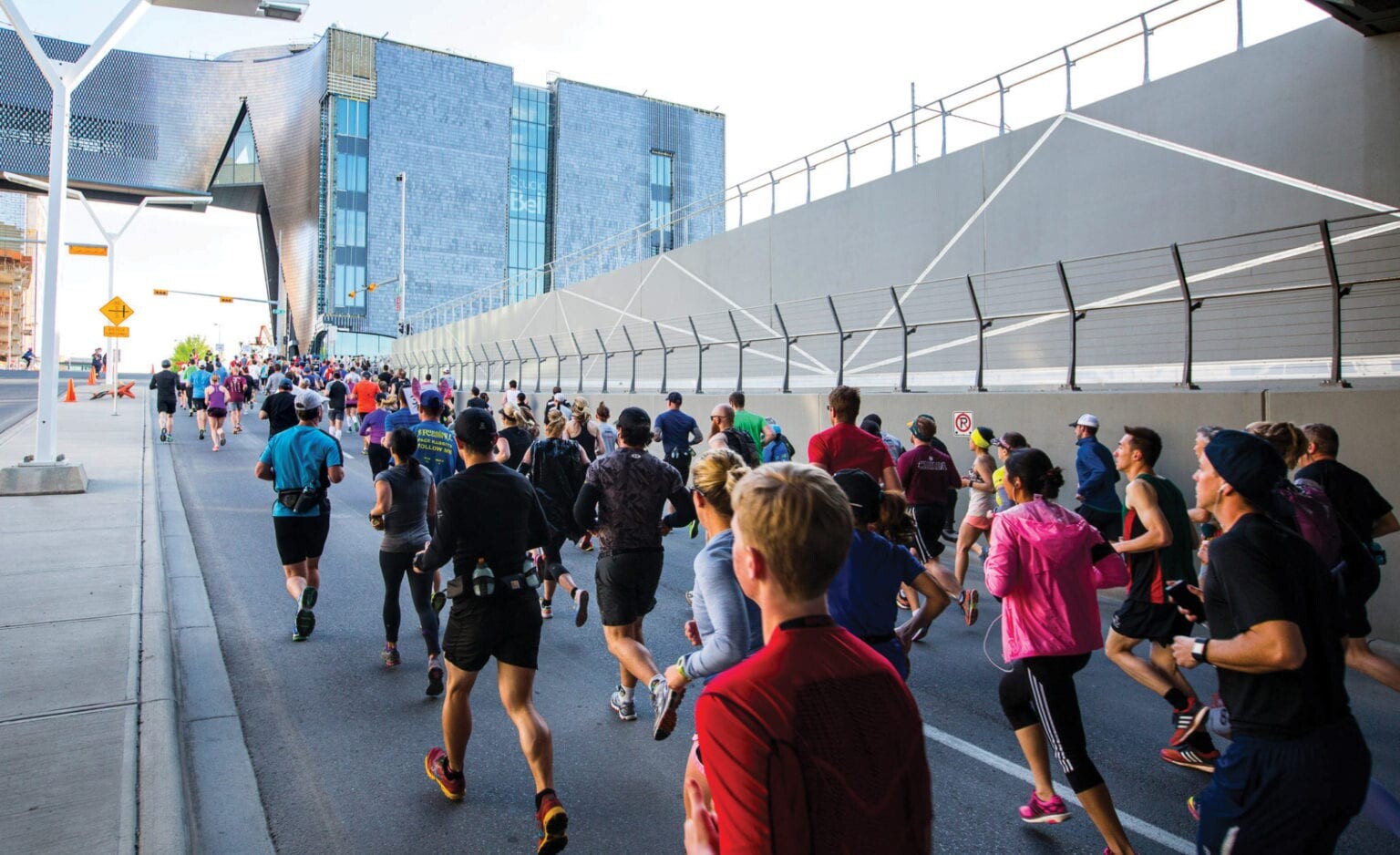
Consider this 2006 study, which had a group of moderately-trained female distance runners do 5K time trials with three different pacing strategies. In the first, they ran the opening mile at their average pace from an earlier baseline time trial and then were allowed to run the last two miles at whatever pace they could maintain.
In the second, they ran the opening mile three per cent faster than their average, and in the third, they ran the first mile six per cent faster than their average. Surprisingly, the women ran their fastest times in the final time trial, despite starting out about 15 seconds per mile faster than their race pace.
In other words, going out a bit aggressively isn’t always a terrible idea, as long as the race isn’t too long, you don’t go out too hard and you’re relatively fit so you can handle riding the pain train into the finish. This “fade from the front” strategy requires lots of confidence and some serious mental toughness, so if you don’t think you can handle it, you’re better off sticking to a more even effort.
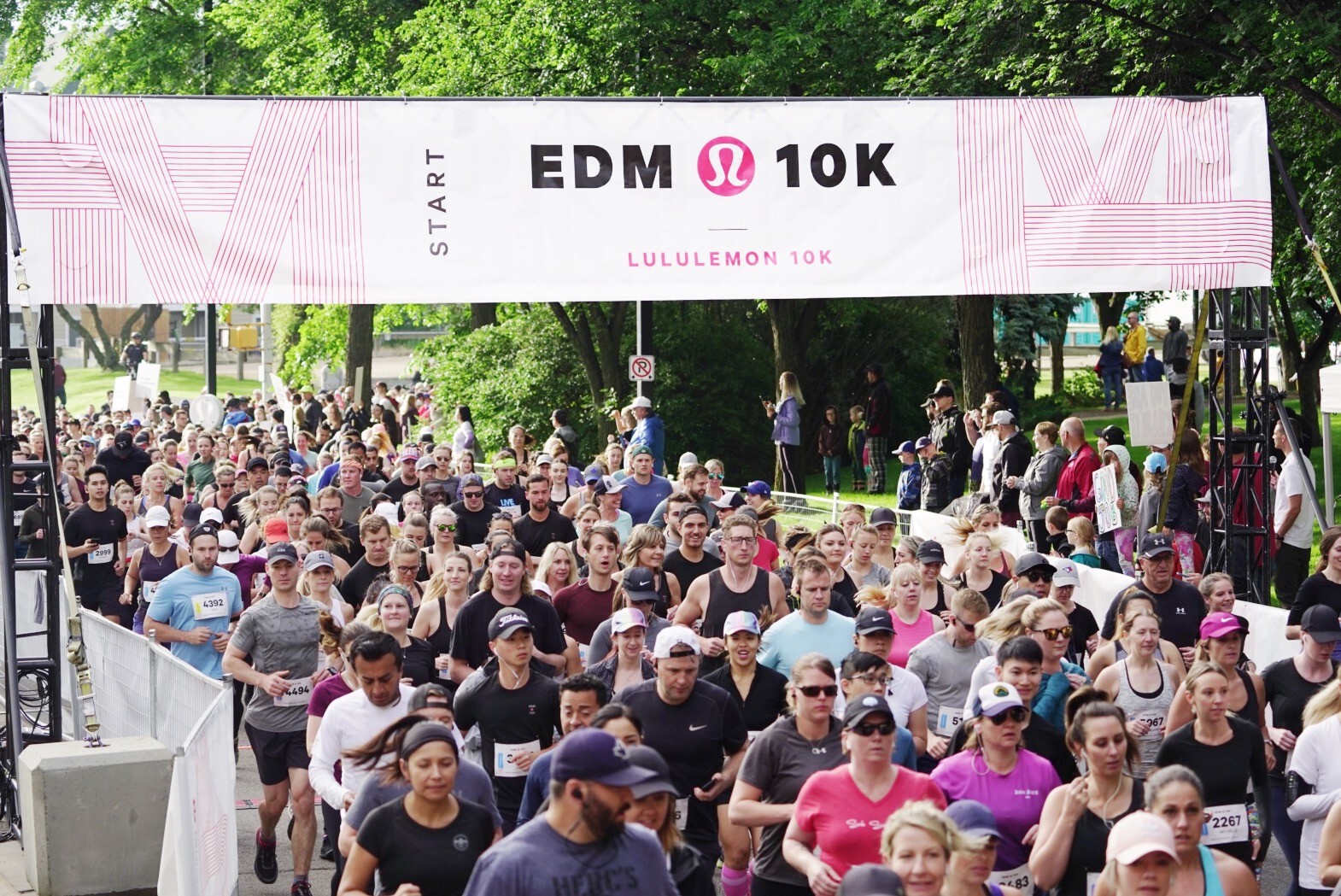
If you’re racing a 10K
The best 10K runners have learned how to combine the aggressiveness of a 5K with the patience of a half-marathon, and are good at staying focussed in the middle of the race when they’re most likely to fall off the pace. Your first kilometre will likely be a bit faster than your goal pace, which is OK as long as you can settle into your pace quickly afterward and stay there for the majority of the race.
Runners who are newer to the 10K distance may also benefit from the negative split strategy, which involves starting your first 5K out conservatively and then picking up the pace in the second half. This will prevent you from going out too hard at the beginning, and allow you to finish strong, which will give you confidence when you toe the line in your next race.
If you’re racing a half-marathon
Now that you’re dipping your toe into the longer stuff, you’re going to want to err on the side of conservative in the first half of the race. The benefits of going out more aggressively start to diminish when you get to the half-marathon distance because any time you gain at the beginning, you’ll likely end up giving back with interest at the end.
Keep in mind that conservative doesn’t mean slow. Starting off way under your goal pace is also a bad idea because as the miles accumulate on your legs, it will be harder and harder to speed up enough to make up for it in the second half. With that in mind, make sure you’ve practiced running at your goal race pace so you know what it feels like, and do your best to run as evenly as possible from start to finish.
If you’re racing a marathon
Everything we said for the half-marathon you’re going to want to double-down on in the marathon. At twice the distance, pacing mistakes in the early stages have the potential to be much more catastrophic later on, so you need to exercise a lot of patience. Your best bet is to avoid getting caught up in the excitement of the start line, stay relaxed and hit your splits as evenly as you can.
(12/07/2021) ⚡AMPby Brittany Hambleton
Dan Green didn't sign up for the first ever Chevron Houston Marathon thinking he would win, 50 years later, he is still in love with running and helping other athletes cross the finish line
Dan Green didn't sign up for the first ever Chevron Houston Marathon thinking he would win.
But in 1972, he was the first to cross the finish line in Memorial Park - cementing his place in Houston history.
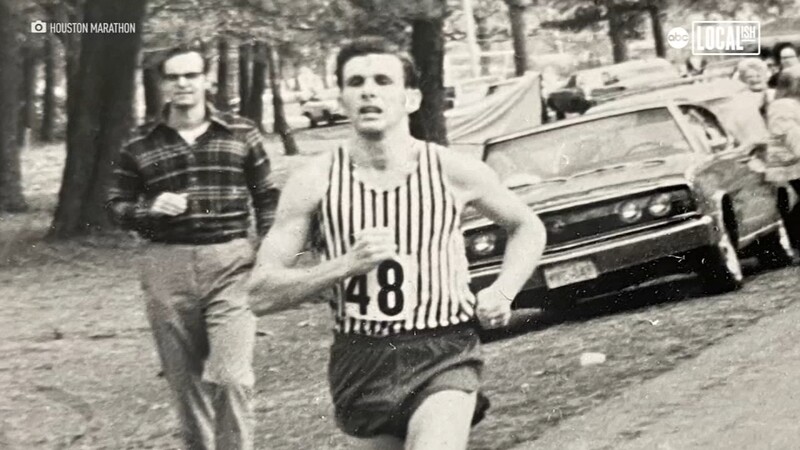
Since then, Green went on to win countless titles including every Amateur Athletic Association Gulf Championship race distance.
He has built running clubs and communities across Houston. Green is also the coach and founder for Team Green Running, where he has trained some of the best athletes.
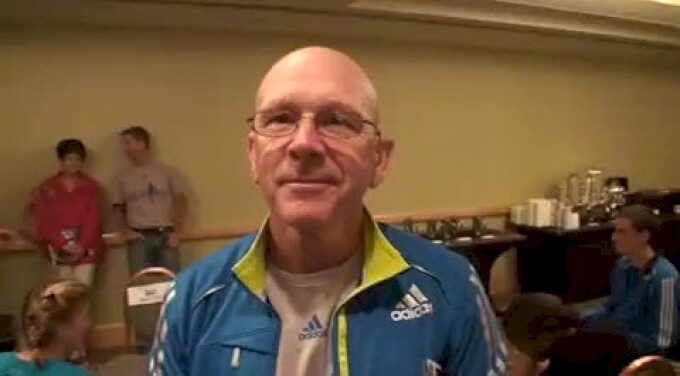
He trained Wilkerson Given, the 2018 men's top American finisher at the Chevron Houston Marathon.
Green was inducted into the Houston Marathon Hall of Fame in 2018.
50 years after winning that first race, Green says Houston is still one of the best cities for runners and the Chevron Houston Marathon is one of the best races in the country.
(12/07/2021) ⚡AMPby ABC 13 News
Chevron Houston Marathon
The Chevron Houston Marathon offers participants a unique running experience in America's fourth largest city. The fast, flat, scenic single-loop course has been ranked as the "fastest winter marathon" and "second fastest marathon overall" by Ultimate Guide To Marathons. Additionally, with more than 200,000 spectators annually, the Chevron Houston Marathon enjoys tremendous crowd support. Established in 1972, the Houston Marathon...
more...NYRR will require COVID-19 full vaccination to participate in its 2022 races
New York Road Runners (NYRR) today announced that runners taking part in its 2022 adult races will be required to show proof of COVID-19 full vaccination to participate. With COVID variants and cases increasing, the decision was made in collaboration with medical and public health experts and state and local government officials.
The new health and safety protocol will begin with the NYRR Midnight Run on December 31 and continue with races moving forward.
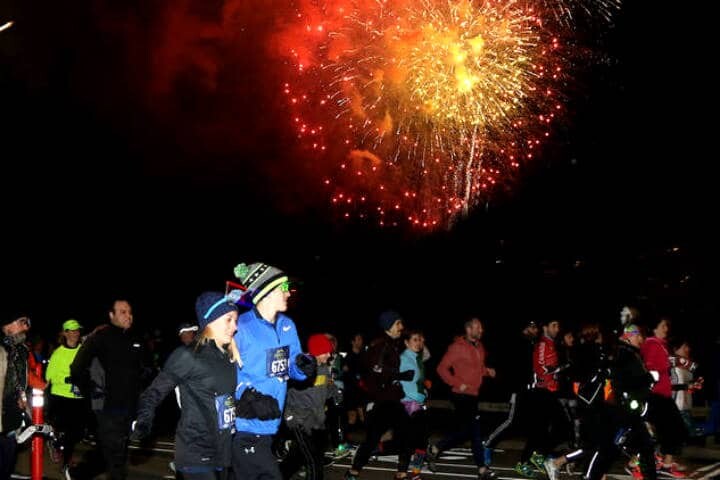
“We are excited to have our traditional calendar of events safely return in the new year,” said Kerin Hempel, CEO, NYRR. “The health and wellness of all of those involved continue to remain at the forefront of our organization.”
All entrants will be required to show proof of full vaccination series authorized by the Emergency Use Authorization by the U.S. Food & Drug Administration (FDA) or on the World Health Organization (WHO) Emergency Use lists.
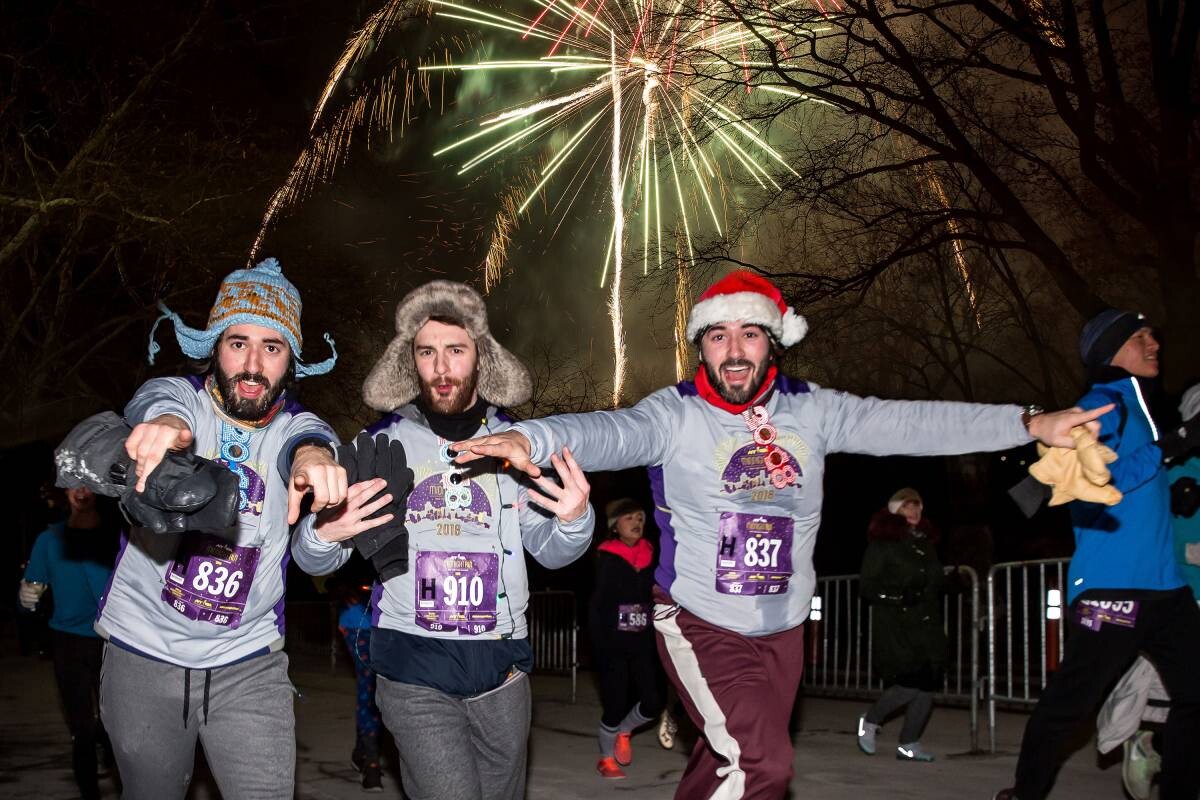
Runners who have already registered for a 2022 race will have the option to receive a refund or gift card or donate their race entry fee to NYRR’s youth and community programs.
Guidelines and protocols may continue to evolve and subject to change. NYRR will revise its operational plans as necessary.
(12/07/2021) ⚡AMPby Running USA
NYRR Midnight Run
Kick off the New Year at the Midnight Run! Join the fun and celebrate with music and dancing (starting at 10:00 p.m.) as 2019 comes to a close. With a countdown to midnight beginning at 11:59 p.m., the four-mile run will begin on the stroke of midnight, as will a spectacular fireworks display to light up the night and the...
more...Canadian Reid Coolsaet set to run the 2022 Western States 100
The lotteries for the 2022 Western States 100 and Hardrock 100 took place this weekend, and Canadian Olympian Reid Coolsaet got his name on the Western States list. With over 8,000 applicants vying for only 340 lottery spots (221 for Western States and 119 for Hardrock), runners without automatic entry have a slim chance of having their names pulled, but 34 lucky Canadians got a spot on the start lines.
Western States
Of the top 10 male finishers at last year’s race, eight will be making their return to Olympic Valley, Calif., including second- and third-place finishers Tyler Green and Drew Holmen. Jim Walmsley, who won the race in 2018, 2019 and 2021 (the race was canceled in 2020 due to COVID-19), has not elected to return for the 2022 race. The top three podium finishers from last year’s race, Beth Pascall of the UK, Ruth Croft of New Zealand and Ragna Debats of the Netherlands, will all be returning, as will six more of the top 10 women from 2021.

Canada’s Ailsa MacDonald received automatic entry, thanks to her 13th-place finish at the 2019 Western States and first-place finish at the 2020 Tarawera 100 Mile. Other fast runners who have received automatic entry include Sébastien Spehler (second at Ultra Trail Cape Town this year), Tom Owens (fourth at UTMB in 2019), Cole Watson (third at the Javelina Jundred), Stephanie Auston (third at the 2020 Black Canyon 100K and second at the 2019 Tarawera 100K) and Zoë Rom (third at the 2021 Rio del Lago 100 Mile and third at the 2021 Tillamook Burn 50 Mile), among others.
Coolsaet will be one of the top Canadians in the race, despite being relatively new to the ultramarathon scene. In August, he won his first-ever ultra, the Quebec Ultra Trail 110K, despite missing a turn and having to run an extra 10 kilometres. He will be joined by several other Canadians, including:
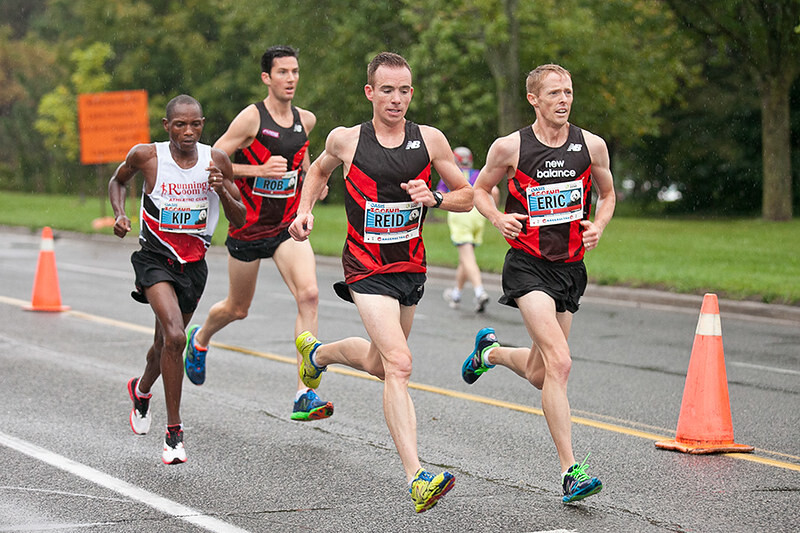
Leo Fung, Calgary
Jesse Hulley, Calgary
Mike Jollie, Calgary
Kevin Jansen, Calgary
Rohan Aurora, Vancouver
Steve Day, North Vancouver
Adam Harris, Squamish, B.C.
Patrick Humenny, Kimberly, B.C.
Ricardo Tortini, Port Moody, B.C.
Dawson Mossman, New Maryland, NB
Aytug Celikbas, Oakville, Ont.
Matt Lowe, Hamilton
Derek Mulhall, Tecumseh, Ont.
Norman Nadan, Orangeville, Ont.
James Swartz, Toronto
Vincent Gauthier, St-Zotique, Que.
Fanny Barrette, Calgary
Tara Chahl, Edmonton
Chelsey Topping, Lethbridge, Alta.
Kelly Haston, Toronto
Karen Holland, Kimberly, Ont.
Hardrock 100
Hardrock is particularly difficult to get into, because the only way to gain automatic entry into the race is by winning it the previous year. A unique addition to this year’s lottery: entrants who were chosen for last year’s race but were unable to travel because of COVID-19 were given automatic entry for 2022, which included 16 men and two women.
There are some big names on the 2022 start list, including Courtney Dauwalter, Sabrina Stanley, Magie Guterl, François D’Haene, Kilian Jornet, John Kelly, Luke Nelson and Jeff Browning. Canada’s Stephanie Case, who was the first woman (and third overall) at the 450km Tor des Glaciers race in Italy, will also be on the start line.
Other Canadians who received entry into Hardrock include:
Suzanne Johnson, North Vancouver
Dana Samis, North Vancouver
Joanna Ford, Calgary
Larry Kundrik, Lethbridge, Alta.
Ken Legg, Powell River, BC
Randy Duncan, Victoria, BC
Christopher Aubrey, Sherwood Park, Alta.
Nathaniel Couture, Fredericton, NB
Matthew Fortuna, Oyama, BC
Leo Fung, Calgary
(12/06/2021) ⚡AMPby Brittany Hambleton
Western States 100
The Western States ® 100-Mile Endurance Run is the world’s oldest and most prestigious 100-mile trail race. Starting in Squaw Valley, California near the site of the 1960 Winter Olympics and ending 100.2 miles later in Auburn, California, Western States, in the decades since its inception in 1974, has come to represent one of the ultimate endurance tests in the...
more...Try diagonals: a Kenyan recovery workout, use this workout to improve leg speed and running economy
Given that Kenya has produced several of the top distance runners in the world, when the country’s athletes or coaches share a bit of training wisdom, runners of all levels listen up.
Recently, Coach Peter Bii at the Asics Chojo Camp in Iten, Kenya, shared a recovery workout that his athletes do on a regular basis called Diagonals, which help keep their legs feeling fresh for their next workout.
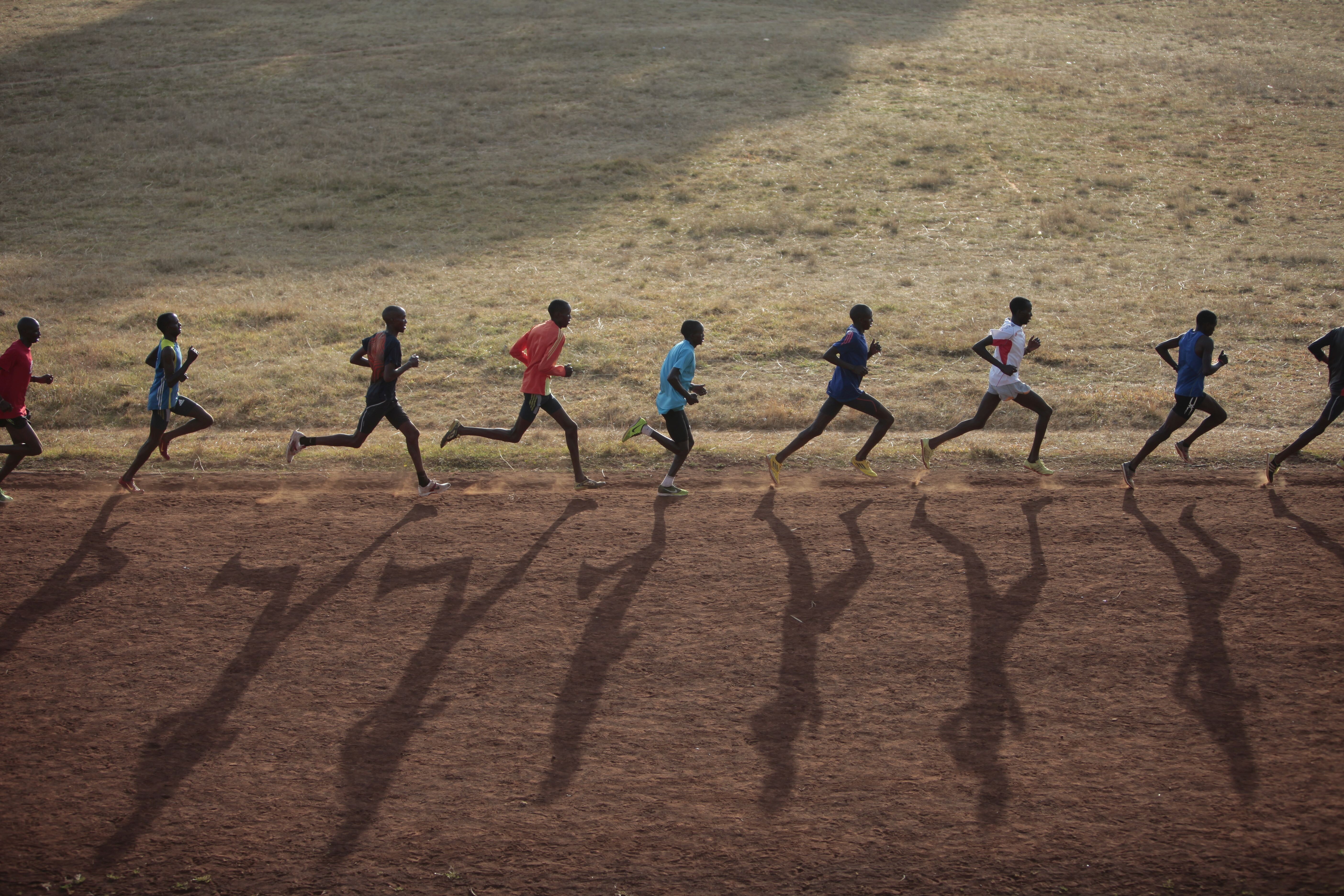
The athletes perform the workout on a soccer field, where they jog along the goal line and do strides diagonally across the field, from one corner to the opposite corner. Bii explains that the workout is meant to promote quick leg turnover, and improve leg speed, strength and running economy without taxing the aerobic system too much. The athletes will perform diagonals for the entire length of a regular run, usually 40-50 minutes.
Bii says in the video that he usually has his runners perform this workout after they’ve already done a harder workout earlier in the week. In the video, he is using the session as a final prep workout before the athletes toe the line in a race on the weekend.

“If you tell the marathoners that today we are doing 100m on the track, they won’t do it,” says Bii. “But if you say we’re doing diagonals at a bit up pace, then they won’t see what it is.”
Doing diagonals for upwards of an hour might be too much for you, but the great thing about this workout is it can easily be adapted for all experience levels. To start, you could try doing a 10- or 15-minute warmup, followed by 15 minutes of diagonals, and work your way up from there.
(12/06/2021) ⚡AMPby Brittany Hambleton
After a two-year hiatus, Dallas Marathon is coming back, celebrating its 50 anniversary
The 50th anniversary of the Dallas Marathon was always going to be a special event.
But then the race was canceled last December for only the second time ever because of the pandemic. The makeup race in May suffered the same fate.
A pandemic-induced cancellation won’t happen a third time. And Paul Lambert, the president of runDallas, the organization that puts on the marathon, said the yearlong wait is going to make the marathon’s golden jubilee even more special.
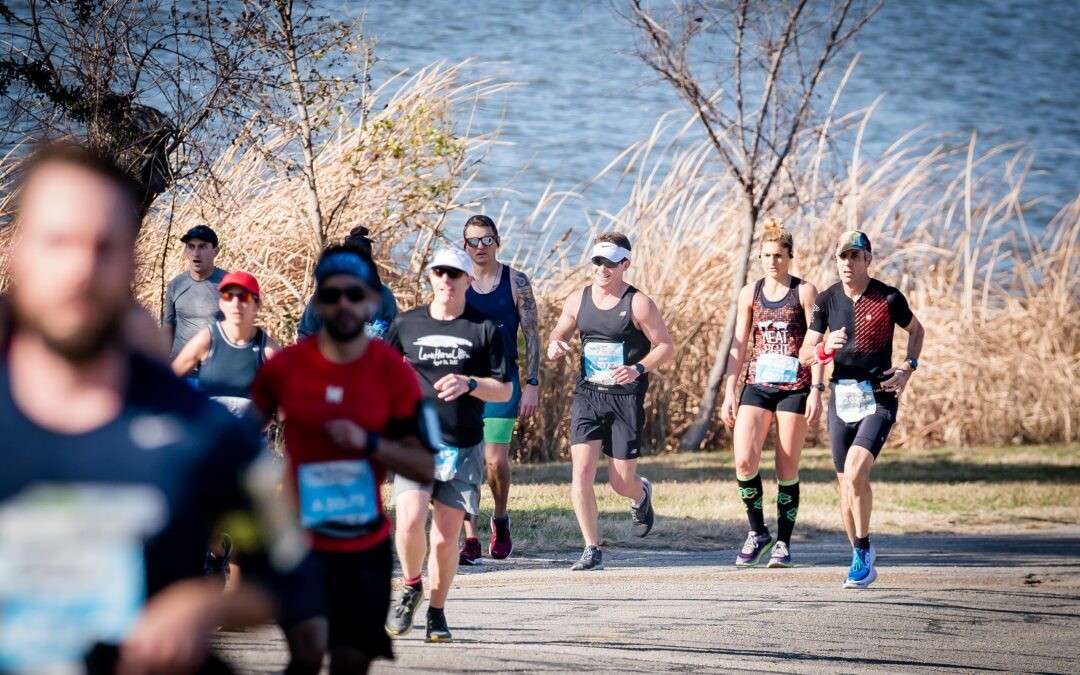
“We’re actually putting a video together and the theme song is ‘Back to Life,’” Lambert said. “If you would ask me how it feels, it’s a combination of truly back to life; not only for, hopefully, a lot of our runners and the feeling that they get out in these massive public community running events, but also for us as a management team.”
The BMW Dallas Marathon will take place next weekend with the 50th running of the marathon scheduled for next Sunday. Ten races will take place throughout the weekend, plus a Health and Fitness Expo at Kay Bailey Hutchison Convention Center on Friday and Saturday.
The first Dallas Marathon, then called the White Rock Marathon, was held on March 6, 1971. Far from the major weekend event it is now, the race had 82 participants and the course was only around White Rock Lake.
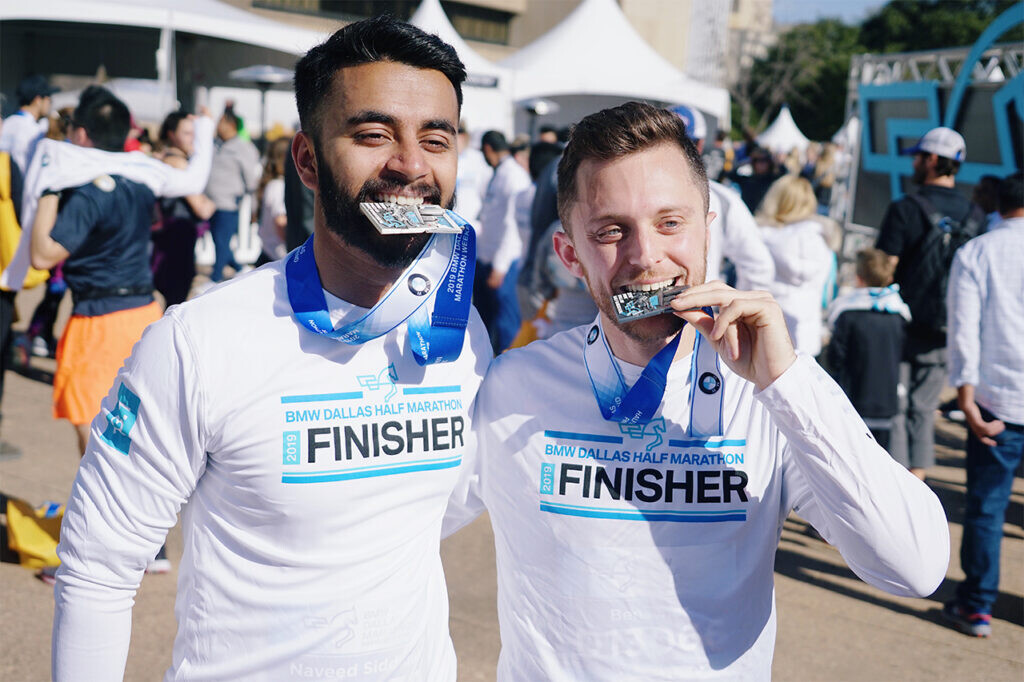
“The changes are really something else,” said Annabelle Corboy, the first female winner of the Dallas Marathon. “The changes in 50 years are incredible. ... There’s so many things that are different between now and then.”
Registration for the original 50th anniversary date opened in April 2020, and runDallas saw strong early participation numbers compared with other races across the country. Lambert said it was because the Dallas Marathon was “probably the first major race to come out with a defined contingency message.”
That plan was if the race couldn’t be held in person in December 2020, runners could either run a virtual race or push their registration back to a backup date in May 2021. And when the backup event was cancelled, the organization offered the same option to run virtually or push registrations to December.
The uncertainty that hung over the organization weighed on its small staff. Despite the contingency messages, it was difficult to do much planning for anything more than three months in advance. And without knowing when the next big race was coming, the team had to make sure it could maintain its financial viability.
But the extra time did give runDallas the opportunity to refine and fine-tune the event, as well as further grow and strengthen relationships with its partners. It has also resulted in extraordinary growth of runners.
Marcus Grunewald, the executive director of runDallas, said the weekend is reaching record participation.
“I think there’s a real pent-up demand to have a big event like this,” Grunewald said. “In fact, our numbers are a bit unusual for the industry as a whole.”
About 15,000 runners participated in the events included in the 2019 marathon. With about a week to go before the first race on Friday, over 23,0000 people have signed up to participate across the 10 different events. RunDallas expects that number to be about 25,000 by race weekend. More than 2,500 people have also signed up to volunteer.
Participation in the ultra marathon, a 50k race added to the program in 2018, sold out weeks ago. The marathon and half marathon are also approaching sellout status, and Grunewald believes they may sell out before race day.
“I think this will be a highlight of the last two years for almost everybody involved with the entire weekend,” Lambert said.
It will be for Logan Sherman, for whom the marathon is almost always a yearly highlight.
He first participated in the Dallas Marathon as part of a relay team in high school over 20 years ago. He has since won the half marathon three times and the 2015 marathon with a time of 2:27:28.
Sherman is now a current member of the runDallas board, and isn’t running any long races this year, instead focusing on volunteering at the event. He is hopeful the 50th anniversary is going to take the event to the next level.
“This is gonna be so much fun,” Sherman said. “I guarantee you there’s gonna be a lot of smiles and emotion that people are going to have at the finish line when they get back to City Hall. I don’t plan on leaving right after the start. I plan on staying up there and just watching the smiles and the emotions that come through.”
(12/06/2021) ⚡AMPby Peter Warren
Bredan Gregg and Sara Vaughn won the Comeback California International Marathon
Davis native Brendan Gregg won the 2021 California International Marathon alongside Sarah Vaughn, a debut marathoner.
A graduate of Davis High School and Stanford University, Gregg finished the race with a personal best time of 2 hours, 11 minutes, and 21 seconds.

“I love coming back here,” Gregg said in a statement. “I’ve done other marathons, but I always want to come back and do it at home at the people’s marathon.”
Gregg's pace was about 5:01 minutes per mile, according to the CIM event results.
Sara Vaughn, of Boulder, Colorado, won with a time of two hours, 26 minutes and 53 seconds.

Vaughn attempted her first marathon just 12 weeks ago, according to a press release.
“Sacramento has always been wonderful to me in my running career,” Vaughn said in a statement. “I made my first Team USA here at Sac State, and last time I was here, I won a race. I had to keep the streak going.”
Gregg and Vaughn, will both take home $10,000 in prize money, plus any performance bonuses.
The competition was cancelled in 2020 due to the pandemic. 9,000 people were registered for the marathon this year.
(12/06/2021) ⚡AMPby Lauren Walike
California International Marathon
The California International Marathon (CIM) is a marathon organized by runners, for runners! CIM was founded in 1983 by the Sacramento Running Association (SRA), a 501(c)(3) non-profit organization. The SRA Board of Directors is comprised of runners with a combined total of 150+ years of service to the CIM. The same route SRA management created for the 1983 inaugural CIM...
more...Fast times at the USATF Half Marathon Championships
The final stop on the 2021 USATF Running Circuit presented by Toyota did not disappoint, as Keira D’Amato and Conner Mantz came away victorious at the USATF Half Marathon Championships presented by Toyota in Hardeeville, South Carolina.
As the women’s race got underway, D’Amato, Allie Kieffer, and Natosha Rogers jumped to the front, putting a six-second gap on a chase trio of Erika Kemp, Makena Morley, and Lauren Paquette, coming through the 5 km split in 16:04.
The lead trio would run together until mile five, when D’Amato pushed the pace and was able to gap Rogers and Kieffer. D’Amato grew her lead quickly, coming through 10 km in 32:05, 12 seconds ahead of Kieffer, who had a nine-second lead on Rogers.
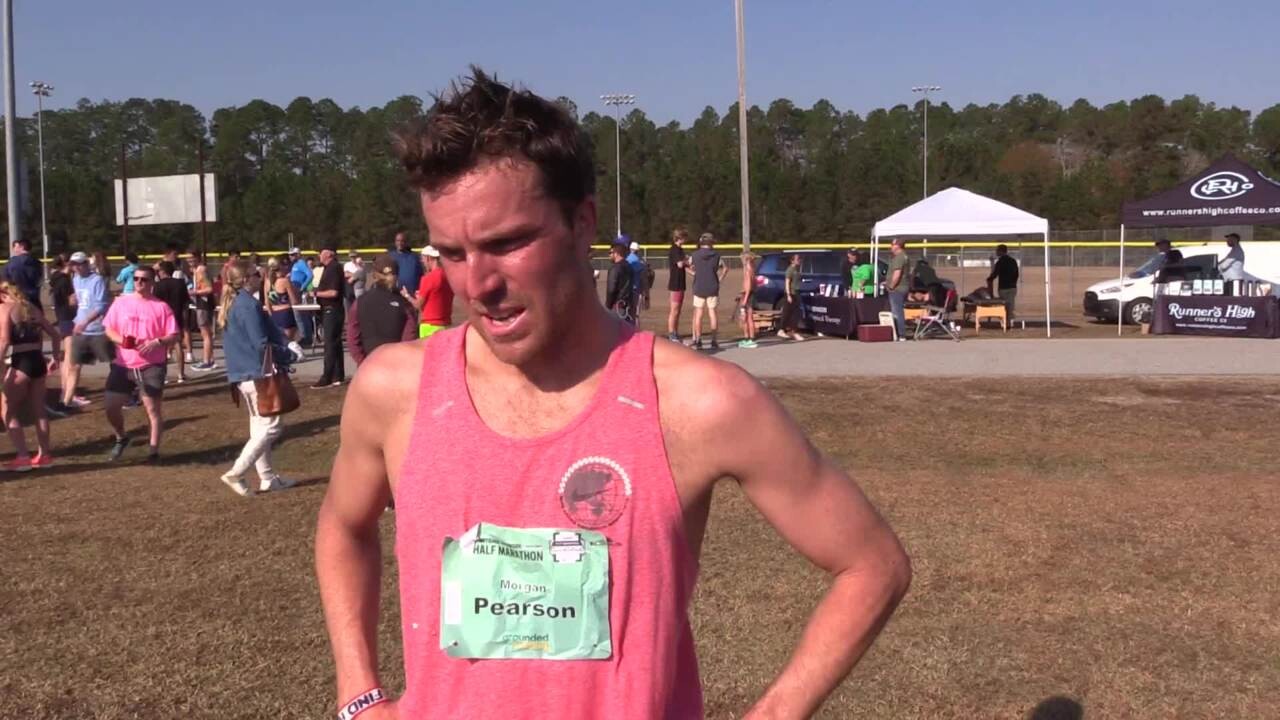
D’Amato would continue to grow her lead, running nearly a minute ahead of Rogers and Morley, who were running second and third. Kieffer sat in fourth a couple seconds back of the duo, as was Paquette.
Over the next 5 km, D’Amato grew her lead to 1:34 over Rogers and Dakotah Lindwurm, who ran a tremendous 10th and 11th mile to move up into the chase, while Paquette started to pull ahead of Morley for fourth.
With the finish line in sight, D’Amato pushed the pace once last time, crossing the finish line with her arms raised and a smile on her face, finishing the half marathon distance in 1:07:55.
Rogers held off the late-race push from Lindwurm to place second overall in 1:09:36, having yet another fine USATF Half Marathon Championship performance. Lindwurm ran an excellent back half of the race to take third in 1:09:40, just ahead of Paquette, who ran to a fourth-place time of 1:09:46, her debut at the half marathon distance.
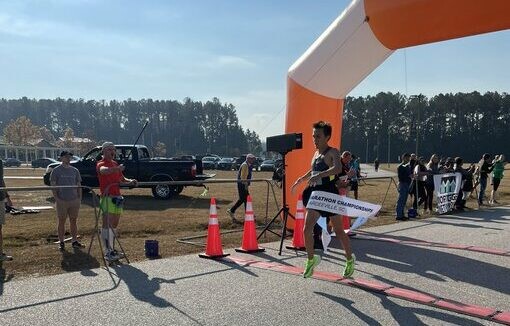
Morley held on over the final miles to place fifth in 1:09:57, edging out Erika Kemp, who placed sixth in 1:10:38. Kieffer faded a bit in the later stages of the race, but still place seventh overall in 1:10:44, while Maggie Montoya ran 1:11:21, Susanna Sullivan ran 1:11:58, and Jessie Cardin crossed in 1:12:08, as the trio took eighth through tenth.
While D’Amato ran a dominating performance to win Sunday, there was another race within a race, with Kemp and Morley battling for the 2021 USATF Running Circuit title. As the final race of the 2021 USATF Running Circuit season, Kemp entered Sunday’s action with a nine-point lead over Morley.
Early on Sunday, it seemed as though Morley might pull away and claim the overall title, but Kemp’s strong finish helped her outlast Morley. Kemp’s sixth-place effort claimed her the overall USATF Running Circuit title with 62.5 points, just ahead of Morley’s 55 points. Emily Durgin finished with 49 points to place third overall, while Lindsay Flanagan and Annie Frisbie earned fourth- and fifth-place finishes with 34 points and 30 points.
A large group led the men’s race early Sunday morning, with all of the pre-race top contenders in tow. Reigning NCAA Division 1 cross country champion Mantz led the way early, as Sam Chelanga, Lawi Lalang, and Augustus Maiyo also ran up front, as the pack found hit a groove, running 4:40 mile pace for the early miles.
As the men came through 10 km, Mantz continued to lead, with Chelanga, Maiyo and Morgan Pearson off his shoulder. Over the next 5 km, Pearson and Mantz would take turns pacing, while Maiyo and Chelanga right behind with Lalang.
As the lead group passed through mile 10, Lalang started to drop off, while Clayton Young and Nico Montanez moved up. The pace continued to ratchet down, as the group formed a single file line, with Mantz and Pearson pushing ahead.
With a mile to go, it was now a three-man race, with Mantz, Chelanga and Montanez running together. Chelanga tried to push the pace and break up the group, but Mantz hung tough and wouldn’t concede any ground to Chelanga.
In a furious kick to the finish, Mantz showed his championship-level form, pulling away from Chelanga to claim his first USATF title, crossing the finish in 1:00:55 in his debut over the half marathon distance.
Chelanga took home second place in 1:00:59, a strong finish to his 2021 USATF Running Circuit season, as Montanez placed an impressive third in 1:01:13, his second top three finish on the USATF Running Circuit season and less than two months after placing seventh at the Bank of America Chicago Marathon.
Clayton Young, who won the USATF 15 km Championship title, the first race of the USATF Running Circuit season, finished fourth overall on Sunday in 1:01:18. Futsum Zienasellassie had another strong performance to take fifth in 1:01:21, as Maiyo finished well to take sixth in 1:01:33.
Olympian Leonard Korir took home seventh in 1:01:43, just ahead of Pearson, who claimed eighth in 1:01:47. Frank Lara and Lawi Lalang rounded out the top ten crossing the finish in 1:02:19 and 1:02:49, respectively.
While he didn’t race Sunday, Abbabiya Simbassa claimed the 2021 USATF Running Circuit overall title with 77 points, well ahead of the rest of the field, after claiming two USATF victories and two runner-up efforts during the 2021 USATF Running Circuit season.
Chelanga’s runner-up finish in Hardeeville gives him 48 points and a second place finish in the overall USATF Running Circuit standings, followed closely by Young, who claimed third with 47.5 points. Montanez finishes fourth on the season with 37 points, while Fred Huxham places fifth on the season with 30 points.
(12/05/2021) ⚡AMPBored on Your Long Run? Here’s Why You Feel That Way—and How to Embrace It
We talked to a psychologist and a professional ultrarunner to understand why you you feel this way—and how to embrace it.
It’s Sunday morning. You roll out of bed, head downstairs, pour yourself a cup of coffee, and munch on a protein bar. Yup, it’s that time of week again—long run day.
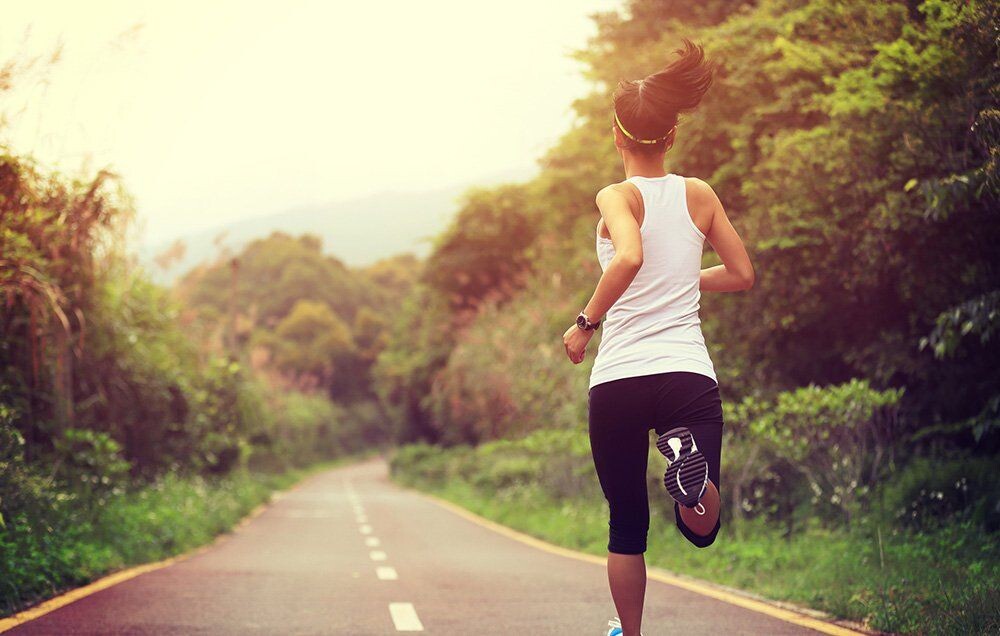
Long runs are a staple of training, whether for a 5K or a marathon. But let’s be frank: Despite the benefits, long runs can be pretty boring. While you might normally rely on the company of others—or perhaps even music or a podcast—during your normal runs, those simple escapes just don’t cut it when you’re trotting along for twice as long. Conversation becomes agonizing, pop bangers non-motivating, and true crime dramas stale.
So why, even though it’s one of your most cherished activities, do you sometimes feel overcome with boredom when long running?
According to Erin C. Westgate, Ph.D., director of the Florida Social Cognition and Emotion Lab at the University of Florida, boredom is an emotion characterized by lack of meaningfulness and engagement.
“So, what you’re doing needs to feel meaningful to you personally, otherwise you’re bored,” Westgate tells Runner’s World. “… [and] you need to be able to pay attention to what you’re doing. That means if you’re doing something that’s too easy or too hard, you’re going to struggle to pay attention.”
Long runs are hard. You run farther than you would any other day of the week, which is mentally and physically taxing. No wonder it leads to boredom.
So, what actually is boredom?
Scientists previously considered boredom a neutral state, Westgate says, so it did not meet the criteria to be considered an emotion. However, recent research suggests that boredom is an emotion—and not a neutral one.
“It’s actually pretty unpleasant and aversive,” Westgate says. “People don’t enjoy experiencing it.”
During a graduate school study, Westgate had subjects sit in an empty room. The first part of her research measured pleasant versus unpleasant experiences. Would a patient pay to come back and look at the same beautiful painting again? Yes, for $5. Would a patient pay to not experience pain from a shock device? Also yes, for $2.
During the final part of the study, she asked participants to sit alone in an empty room and entertain themselves with their thoughts for 10 to 20 minutes. There were only two rules: stay in the chair and don’t fall asleep. Each subject was also told that if they wanted to, they could use the shock device from the earlier part of the study. Sixty-seven percent of the men and 25 percent of the women shocked themselves, preferring pain to the monotony of sitting with their thoughts.
While this paints a poor portrait of boredom, Westgate says the emotion shouldn’t be seen as inherently positive or negative. It’s simply information, which can tell you a lot about how you’re feeling.
Here’s why you might be bored on a run—and what to do about it
Katie Asmuth—who is a professional ultrarunner for Saucony—believes that boredom can teach you something about yourself. Depending on the training cycle, she might run for up to five hours at a times—a distance many folks would find mind-numbingly boring. To her, it's the furthest thing from it.
“To be bored while running doesn’t have to do with the act of running, but with the mindset behind the action,” she says. “If you are bored, you are not engaged with the process.”
The emotion is a symptom of something bigger, whether lack of motivation, mental burnout, or something else entirely. “Boredom is sort of like a dashboard light letting you know something is off,” says Westgate. “It gives you an opportunity to fix that.”
If you’re bored because your long run doesn’t feel challenging enough, you can add in a few pickups to keep it interesting. Or, if you’re bored because your run doesn’t feel meaningful to you in the moment, you can remind yourself that this run is valuable to your long-term goals.
Tuning into why you feel bored teaches you how to motivate yourself in the future. After you complete the big marathon that you trained four months for, it might be difficult to become excited about training again—those 20-minute runs might mentally feel like a long run now, when a month ago a long run flew by like it was only 20 minutes.
Westgate says that’s it’s okay to feel this way. After all, you can’t be die-hard motivated all the time. Using a distraction—such as music or a podcast—to get through mentally challenging runs isn’t a bad thing.
“It’s almost like comfort food,” says Asmuth. “… sometimes you need that initial trigger that excites you to get out the door.” But such as with comfort food, it’s healthiest in moderation.
You don’t have to completely suppress your feelings of boredom. Embrace them instead!
You can easily distract yourself too much. Instead of getting to the root of your boredom, you put on music just to push through it. In the long-term, this can reduce the activity’s meaningfulness.
“Suppression strategies are not a healthy way of dealing with the feelings we have,” says Westgate. “Part of that is because they don’t actually solve the underlying problem.” She likens coping this way to pulling out your phone every time you’re bored at work; by doing so, you’re not dealing with the hard truth that the work makes you feel bored.
It’s important to keep in mind, though, that everyone is different, and one person’s suppression could be another person’s positive experience. Asmuth loves to warm up with a good podcast, a “rocking playlist,” or audiobooks—not because she’s trying to distract herself from her run, but because listening to those things adds to her enjoyment. Once she gets far enough along, she’ll usually turn the sounds off.
“I prefer listening to my body, my breath, and my footsteps—letting my mind wander,” Asmuth says. “I disconnect from what I’m doing after the run and reconnect with my present self. I often think about what I’m grateful for and appreciate the silence.”
Studies have found that the silence and disconnect that Asmuth mentions can lead to measurable positives. A study in the journal Academy of Management Discoveries found that some people feel a boost of creativity after performing a boring task. Alicia Walf, Ph.D., a senior lecturer of cognitive science at Rensselaer Polytechnic Institute, told Forbes that boredom can also improve social connectivity.
So, don’t be afraid to embrace boredom—just like Asmuth does. After giving birth to her first son, she made sure running stayed a priority; it was important to have alone time to go outside and explore.
“That boredom is a gift. I have the time and space to listen to my body, to scan from head to toe and ask, ‘what do I need?’” Asmuth says. “I take what the trail gives me and need nothing more.”
(12/05/2021) ⚡AMPby Runner’s World
USATF Announces Tougher Olympic Marathon Trials Standards for 2024
A major caveat: The Trials might not be held if World Athletics won’t accept the top three finishers as Olympians.
Qualifying standards for the 2024 Olympic Marathon Trials were announced today at the USA Track & Field (USATF) annual meeting, and they’re faster than the times needed to get into the 2020 race—especially for women.
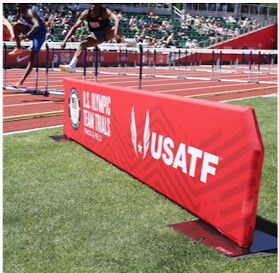
Women who want to enter the race must have qualified with a 2:37 marathon or faster, or a 1:12 half marathon or faster. The marathon time is 8 minutes faster than the 2:45 required to get into the 2020 Trials. (The half marathon time in 2020 was 1:13.)
For men, the times are 2:18 and 1:03, one minute faster at both distances than the 2020 times (2:19 and 1:04).
The qualifying window for marathon times opens on January 1, 2022 and for half marathon times, January 1, 2023.
The 2020 Trials, held in Atlanta, had a historically large field, with 511 women and 260 men qualified to run. Improved shoe technology made it easier for many sub-elite runners to hit the times they needed to qualify for the race.
The top three made the Olympic team—for the women, it was Aliphine Tuliamuk, Molly Seidel, and Sally Kipyego. On the men’s side Galen Rupp won, Jake Riley was second, and Abdi Abdirahman was third.
Behind them, the race turned into a celebration of the strength of distance running in the U.S., with hundreds of runners who had no realistic shot of making the Olympic team soaking up the crowd support along the course and celebrating their achievements.
Leaders at USATF apparently decided the field was too big. Based on the women’s qualifying list from 2020, only 83 women had a marathon time faster than 2:37. Only eight women qualified with a half marathon faster than 1:12.
Conceivably, with the stricter standards, the women’s field could go from 511 in 2020 to 91 runners in 2024.
By the same measure, the men’s field from 2020 would have been 76 people smaller in the marathon, 15 smaller in the half marathon. The men’s field would shrink from 260 to 169.
Much of this discussion may be moot. World Athletics, which governs track and field and the marathon at the Olympics, has encouraged national governing bodies to rely on world rankings to choose their national teams, rather than a one-day Trials format from which the top three make the team.
The Olympic standards are also expected to be stricter, too. In 2021, for the marathons in Sapporo, Japan, the Olympic standards were 2:11:30 for the men and 2:29:30 for the women—in other words, it wasn’t enough for Americans to have finished in the top 3 at the Trials in the marathon. They also had to have run a marathon faster than the Olympic standard to get to go to the race.
World Athletics has not yet announced what the 2024 Olympic standards will be.
USATF has not yet sent out a request for proposal (RFP) for cities to host the Trials, which puts the process well behind its typical cycle. (Atlanta was announced as the host of the 2020 Trials by April 2018, meaning bids were in to USATF months before that.) Races are not thought to be clamoring to host, after a year in which most major marathons were canceled due to the pandemic and finances are stretched in the road racing industry.
Although the Trials in Atlanta were seen as a huge success, the local organizing committees usually lose money on the race because of restrictions on which companies can sponsor the event.
(12/05/2021) ⚡AMPby Runner’s World
Cherono, Jelagat dominate Valencia Marathon
In the women's category, Jelagat won her first-ever marathon, clocking 2:19:31 as Ethiopia's Woldu Etagene came second in 2:20:16
The win by Cherono in the Spanish city comes after victories in Chicago and Boston in 2019, Amsterdam Marathon in 2018 and 2017, Honululu in 2017, Czech in 2016 and Sevilla in 2015.

•Cherono clocked 2:05:12 to fend off Ethiopian Deso Chalu (2:05:16) in a sprint finish while Philemon Kacheran rounded off the podium positions by posting 2:05:19.
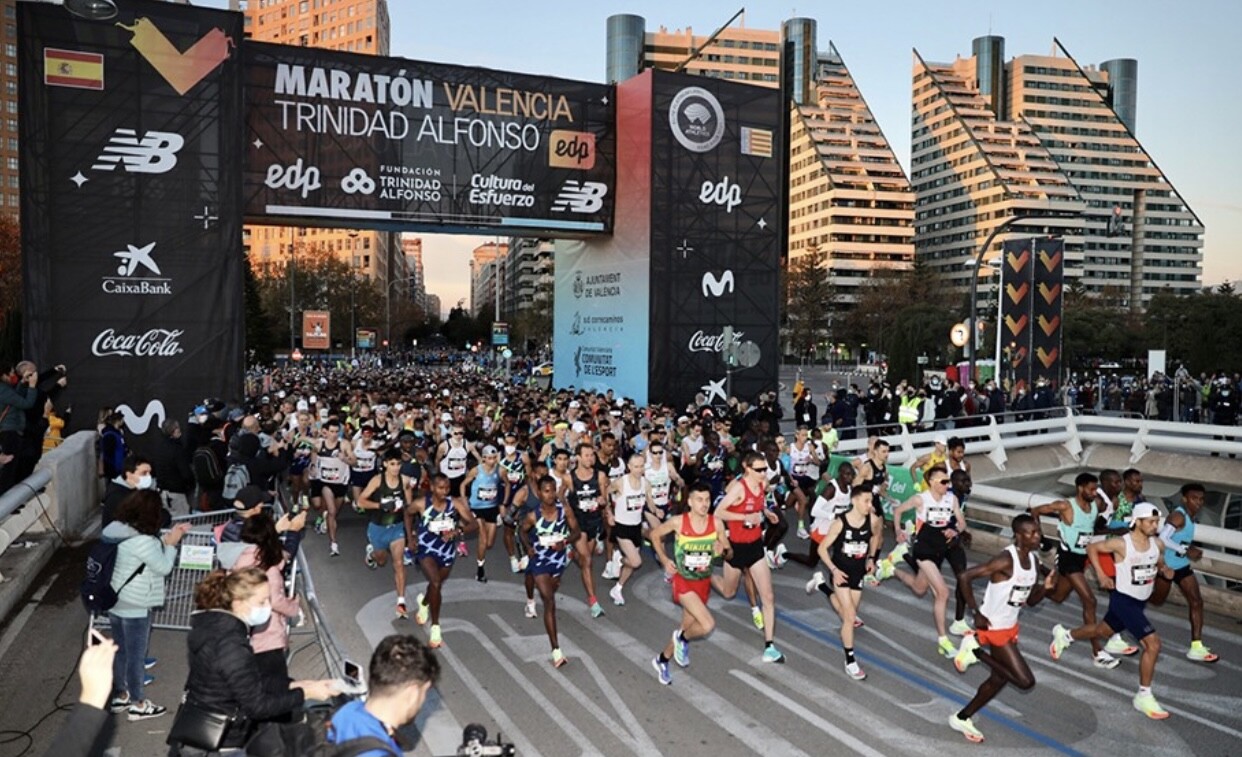
Lawrence Cherono and Nancy Jelagat secured a Kenyan double at the Valencia Marathon on Sunday.
Cherono clocked 2:05:12 to fend off Ethiopian Deso Chalu (2:05:16) in a sprint finish while Philemon Kacheran rounded off the podium positions by posting 2:05:19. Former winner Geoffrey Kamworor finished fourth in 2:05:23.
The win by Cherono in the Spanish city comes after victories in Chicago and Boston in 2019, Amsterdam Marathon in 2018 and 2017, Honululu in 2017, Czech in 2016 and Sevilla in 2015.
In the women's category, Jelagat won her first-ever marathon, clocking 2:19:31 as Ethiopia's Woldu Etagene came second in 2:20:16 with compatriots Degefa Beyenu (2:23:04) and Tusa Rahma (2:23:20) finishing third and fourth respectively.
Fionnuala McCormack of Ireland completed the top five positions in 2:23:58
(12/05/2021) ⚡AMP
Githae wins final edition of Fukuoka Marathon
Michael Githae was victorious at the 75th and final edition of Fukuoka International Marathon on Sunday (5), winning the World Athletics Elite Label road race in 2:07:51.
Githae, who runs for Suzuki track team, improved his previous best of 2:08:17, which he set when finishing fourth at last year’s Fukuoka Marathon. Japan’s Kyohei Hosoya finished second, 25 seconds adrift of Githae.
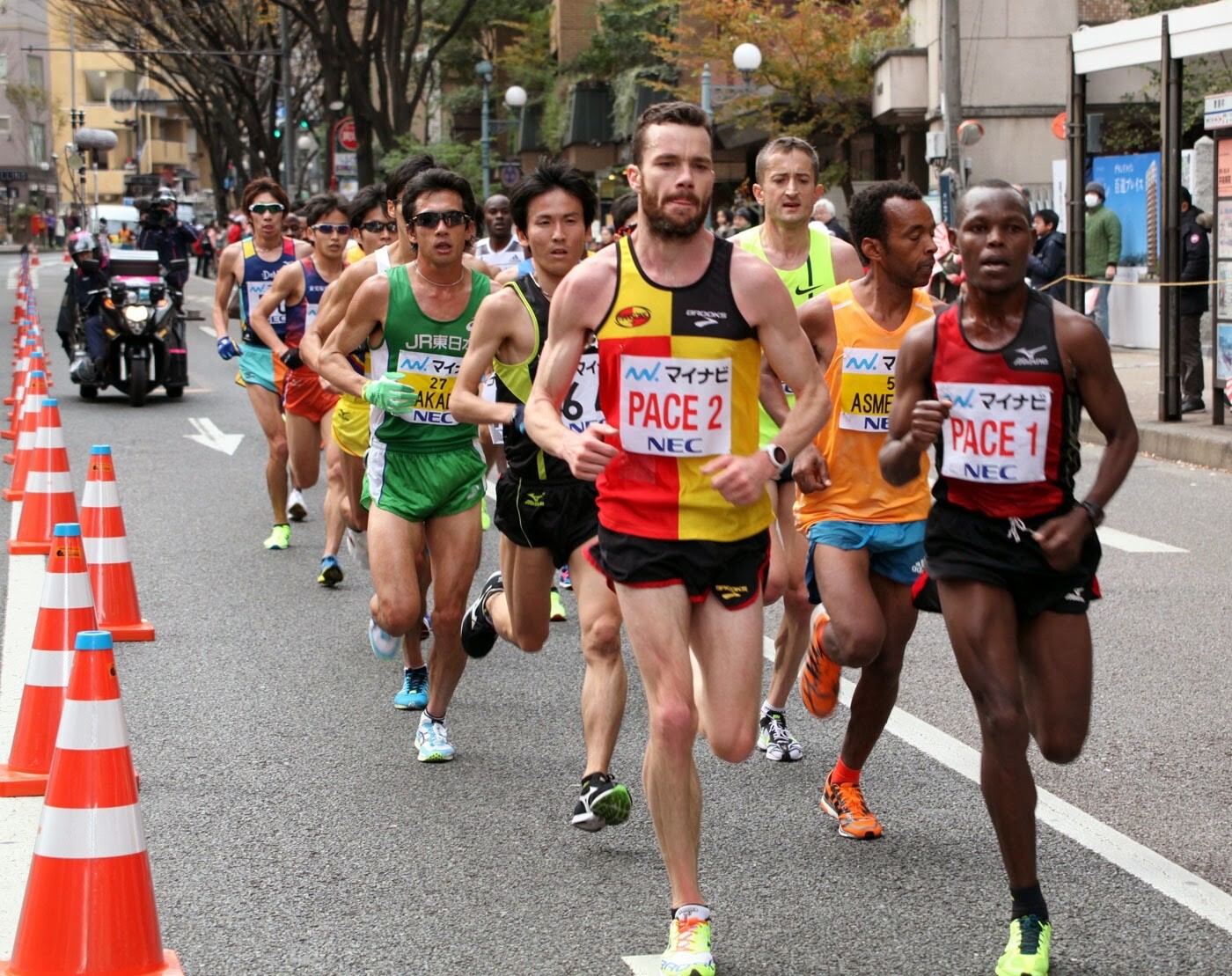
The pacers, led by 2012 Olympian Yuki Sato, directed the huge lead pack through 5km (14:47), 10km (29:39), 15km (44:30) and 20km (59:24) in what turned out to be something of a race of attrition. Yuta Shitara was one of the athletes to fall out of contention before the half-way stage; the former national marathon record-holder dropped out at 20km.
The half-way point was reached in 1:02:41, meaning an attack on the 2:05:18 course record was not out of the question. Simon Kariuki and Charles Wanjiku kept the pace going at the start of the second half, and 30km was reached in 1:29:08. But the pacemakers dropped out soon after, and the pace dramatically slowed down.
Nevertheless, the pack became strung out to almost a single file, and by 34km just Githae, James Rungaru, Hosoya and Ryu Takaku remained in contention. Soon after, Githae surged and Hosoya made a valiant effort to stay close but Githae gradually pulled away to win by 25 seconds in 2:07:51.
In third, Rungaru set a PB of 2:08:25, while fourth-placed Shohei Otsuka and Ryu Takaku and Daisuke Uekado in fifth and sixth respectively were just outside their PBs. Yuki Kawauchi, running his 12th Fukuoka Marathon, fittingly finished 12th in 2:11:33. He is planning on running the Hofu Marathon in two weeks’ time.
Looking back at Fukuoka's history
The Fukuoka International Marathon – which was awarded a World Athletics Heritage Plaque in 2019 – started in 1947 and is the second oldest marathon in Japan behind the now defunct Lake Biwa Marathon.
In its 75-year history, the world record was broken twice there – first in 1967 when Derek Clayton became the first runner to break 2:10 with 2:09:37, and then in 1981 when fellow Australian Rob de Castella ran 2:08:18.
De Castella isn’t the only global marathon champion to have contested the race over the years. Frank Shorter, the 1972 Olympic champion, notched up four consecutive Fukuoka Marathon victories between 1971 and 1974. 2000 Olympic champion Gezahegn Abera won in 1999, 2001 and 2002, while 1996 Olympic champion Josiah Thugwane won in 1997. The late Samuel Wanjiru, winner of the 2008 Olympic title, made a remarkable marathon debut in Fukuoka in 2007, winning in 2:06:39. And two-time world champion Jaoud Gharib won in 2010.
Numerous world record-holders have also competed in Fukuoka, including Haile Gebrselassie (winner in 2006), Belayneh Dinsamo (1990 winner) and Patrick Makau (2014 and 2015 champion).
Japanese runners have also enjoyed moments of victory in Fukuoka. Toshihiko Seko won four times (1978-1980 and 1983), and Takeyuki Nakayama won twice (1984 and 1987). During his 1987 run, Nakayama was on world record pace through 20km (58:37) and 35km until a heavy downpour in the closing stages slowed him down, and he eventually finished in 2:08:18.
When asked about the end of the Fukuoka Marathon, four-time winner Seko said: “It is like part of my history is being erased.”
Japan Running News, a leading authority on the sport in Japan, has produced a docu-film on the Fukuoka Marathon, entitled ‘Inside the Outside – When the World Came to Fukuoka’.
Leading results
1 Michael Githae (KEN) 2:07:512 Kyohei Hosoya (JPN) 2:08:163 James Rungaru (KEN) 2:08:254 Shohei Otsuka (JPN) 2:08:335 Ryu Takaku (JPN) 2:08:386 Daisuke Uekado (JPN) 2:08:567 Kohei Futaoka (JPN) 2:09:148 Masaya Taguchi (JPN) 2:09:359 Toshiki Sadakata (JPN) 2:10:3110 Takuma Kumagai (JPN) 2:10:4111 Ryota Komori (JPN) 2:11:3212 Yuki Kawauchi (JPN) 2:11:33
(12/05/2021) ⚡AMPFormer World Athletics president Lamine Diack has died
The former head of global athletics Lamine Diack, who presided over the sport from 1999 to 2015 but was later convicted for corruption, has died aged 88, his family told AFP.
The Senegalese was head of the International Association of Athletics Federations (IAAF), now renamed World Athletics, the world governing body of track and field, the cornerstone of Olympic sport.
Diack, who was also a powerful figure at the International Olympic Committee (IOC), was found guilty of corruption by a French court in 2020 for covering up Russian doping cases in exchange for millions of dollars of bribes.
He was sentenced to four years in prison, of which two were suspended, and fined 500,000 euros ($560,000).

The trial in Paris heard that the money was paid in return for "full protection", to allow Russian athletes who should have been banned to escape punishment.
Twenty-three Russian athletes had their doping offences hushed up so they could compete at the 2012 London Olympics and 2013 world championships in Moscow.
Because of his age, Diack, a former long jumper, football coach and then businessman and politician who was decorated in the Kremlin in late 2011, was spared jail.
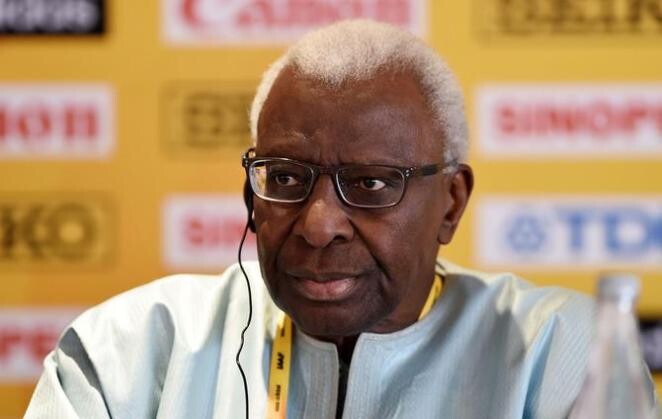
His son Papa Massata Diack, a former marketing executive for the IAAF, was tried in absentia because Senegal refused to extradite him. He was sentenced to five years in prison, fined one million euros and banned from all sport for 10 years.
- Olympic figure -
Lamine Diack, a member of the IOC from 1999 to 2013 and then an honorary member from 2014-15, was embroiled in another corruption affair linked to the awarding of the 2016 Rio Olympics and the Tokyo Olympics, that were postponed because of the pandemic but took place this year.
Despite not being jailed over the Russian corruption, he was held in France because of his indictment in the case involving suspected Olympic vote-buying. His passport had been confiscated.
But a judge soon lifted the ban on Diack leaving France, provided he paid a bond and that he continued to respond to summonses.
Senegalese Premier League side Jaraaf de Dakar, where Diack was club president, said it had sold part of its headquarters property to pay the bail.
Diack was replaced by Britain's Sebastian Coe in August 2015 as head of world athletics. The disgraced Senegalese had resigned from the IOC in the same year.
Coe had been one of Diack's vice-presidents at the then-IAAF between 2011 and 2014.
Born in Dakar on June 7, 1933, Diack started his sporting career as a long jumper, winning the French athletics championships title in 1958. A knee injury prevented him from competing in the 1960 Olympics, however.
He was also a footballer and was technical director of Senegal's national team from 1966 to 1969.
Diack also became head of Senegal's Olympic Committee, mayor of Dakar, a lawmaker and was head of the West African country's national water company before becoming the first non-European to take over as head of the IAAF following the sudden death of its previous president Primo Nebiolo.
The African power-broker said he had played a key role in globalising athletics and his time at the top certainly coincided with a huge boom in its revenues.
Diack was in charge as the sport grew and developed beyond its European and North American core.
He oversaw its move from amateur to professional status, ensured complete equality in events and prize money for men and women, and established international competition circuits for athletes in all the disciplines.
But the Senegalese had previous brushes with scandal before the most recent charges.
Diack and Issa Hayatou, acting FIFA president for four months in wake of the 2015 corruption case against Sepp Blatter, both received warnings from the IOC in 2011 over cash payments they received from International Sport and Leisure (ISL), a marketing company whose collapse caused a major scandal for football's governing body.
(12/04/2021) ⚡AMPby AFP
Former Boston Marathon Lawrence Cherono will be leading Kenyan charge in Valencia Marathon
Former Boston Marathon Lawrence Cherono will be leading an elite field during this years’ Valencia Marathon in Spain on Sunday, a race which is considered to have one of the fastest courses.
According to Cherono, he has had good training and is looking forward to running well after a good recovery for the last two months.
He will be aiming to win the race after he was narrowly beaten last year by Evans Chebet who sprinted in the last 50 metres to bag victory in 2:03:00 with Cherono registering his personal best of 2:03:04. Ethiopia’s Birhanu Legese came third after timing 2:03:16.
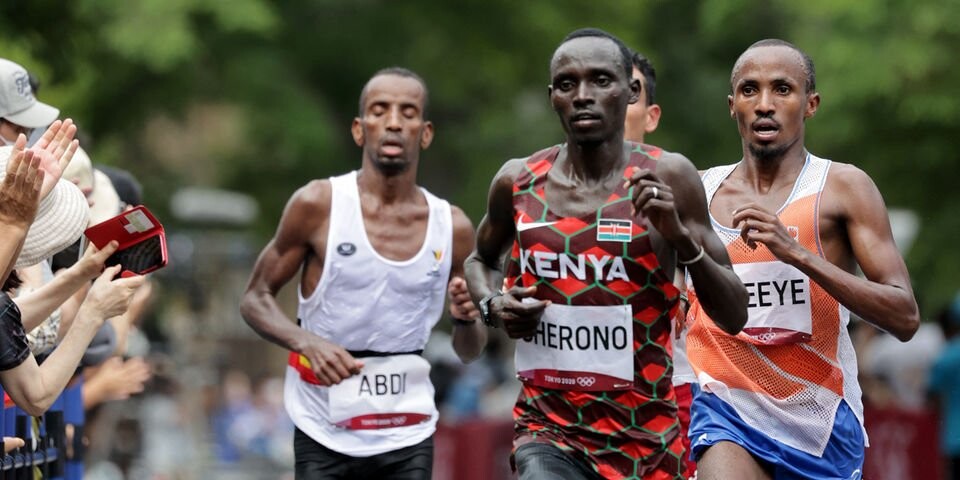
“I have recovered well after participating in the 2020 Olympic Games and went straight to camp to prepare for this race. It is competitive but I believe I will be able to run well on Sunday,” said Cherono who did not defend his Chicago and Boston Marathons races this year.
Also in the race is Geoffrey Kamworor who is seeking a comeback after some time out of competition due to an injury he suffered when he was knocked down by a speeding motorcycle in Eldoret, Uasin Gishu County in June last year.
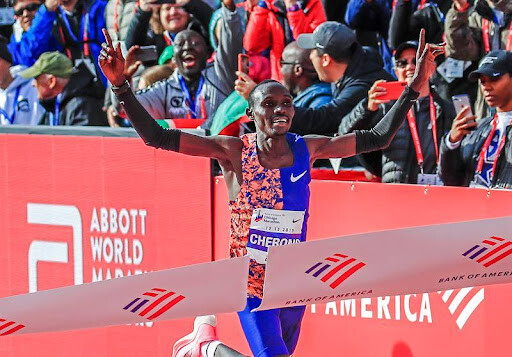
Dr. Victor Bargoria who treated Kamworor then told Nation Sport that he had fractured his tibia and had bruises in his head, something that forced him to take a break from competition.
Kamworor also missed the Olympic Games despite making the team in the 10,000m race after he was advised by his doctor to recover fully before competing again.
The two-time World Half Marathon champion who is fondly referred to as ‘man of all surfaces’ due to his good performance in track, cross country, road races and marathon will be looking to pull another surprise when he competes in Spain.
Cherono, who has the fastest time of 2:03:04 in the elite field will be battling it out with Ethiopians Herpasa Negasa (2:03:40), Kinde Atanaw (2:03:51) and Abebe Negewo (2:04:51), Chalu Deso (2:04:53).
Also in the lineup are Kenyans Philemon Kacheran (2:06:05) who also trains with Kamworor in Kaptagat, Michael Kunyuga (2:06:43), Alex Kibet (2:07:09), Bethwell Kipkemboi (2:07:41) and Japheth Kosgei (2:08:08).
Turkey's Polat Kemboi (2:08:14), Belgium’s Koel Naert (2:07:39), Eritrea’s Goitom Kifle (2:08:09) are the other notable competitors.
In the women's category, 2018 Prague Marathon champion Bornes Chepkirui will be battling it out with other athletes notably Uganda’s record-holder Juliet Chekwel and three-time Rome Marathon champion Rahma Tusa of Ethiopia.
Dorcas Tuitoek, who will be debuting during the race will also be looking to shine having trained with Olympics marathon champion Peres Jepchirchir in Kapsabet, Nandi County.
(12/04/2021) ⚡AMPby Bernard Rotich
VALENCIA TRINIDAD ALFONSO
The Trinidad Alfonso EDP Valencia Marathon is held annually in the historic city of Valencia which, with its entirely flat circuit and perfect November temperature, averaging between 12-17 degrees, represents the ideal setting for hosting such a long-distance sporting challenge. This, coupled with the most incomparable of settings, makes the Valencia Marathon, Valencia, one of the most important events in...
more...Kamworor aims to conquer Valencia
The Valencia Marathon Trinidad Alfonso EDP, a World Athletics Elite Platinum Label event, will return on Sunday (5) and as usual, the organizers have brought together a mouth-watering line-up, headed by Kenya’s Geoffrey Kamworor.
The city of Valencia has witnessed a number of world records in recent years – at 5000m, 10,000m, 10km, and the half marathon – and organizers aim for Valencia to be the epicenter of the running world again this Sunday.
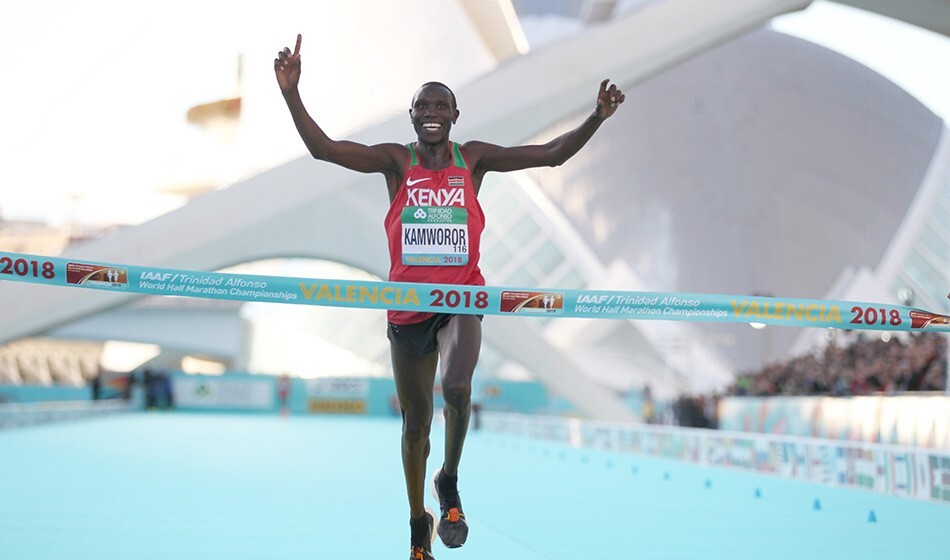
Undoubtedly, all eyes are on the three-time world half marathon champion Kamworor, who turned 29 last month. The Kenyan ace is now fully recovered from the injury which prevented him from competing at the Tokyo Olympics and his last outing was a promising 27:01.06 10,000m at the altitude of Nairobi during the Kenyan trials before he got injured. Once recovered, the two-time world cross country champion focused exclusively on his build-up for Valencia, where he should far improve his relatively modest 2:06:12 lifetime best set on his debut in Berlin back in 2012.
Kamworor has great memories of Valencia, as he became a commanding world half marathon champion in the city back in 2018. “Valencia is the city of running, the atmosphere is special,” he said. “I managed to be world champion here, I know the circuit is incredibly fast and definitely it’s a great opportunity to record a quick time.”
Reflecting after the injury, Kamworor's coach, Patrick Sang, said: “To me, Geoffrey came back stronger physically but also mentally. He is a more professional athlete now. I do not set any target for athletes like Geoffrey, or any other athlete actually, because setting targets is putting pressure. I believe that serious athletes like them, they have the willingness to give their best and that’s always what we should ask from them."
The course record is the goal
A large group of pacemakers – headed by Alexander Mutiso, Bernard Ngeno, and Victor Chumo – will target a steady 2:55 pace to go through the half marathon in 1:01:30, on schedule to break the course record of 2:03:00 set last year by Kenya’s Evans Chebet.
Kenya’s Lawrence Cherono should be one of Kamworor’s stiffest opponents. The 33-year-old was runner-up last year in a career best of 2:03:04 and finished just outside the medals at the Tokyo Olympics with a fourth-place to his credit.
The Ethiopian contingent is also strong as it comprises four athletes to have dipped under the 2:05:00 barrier during their careers: Herpasa Negasa, Kinde Atanaw, Abebe Negewo and Chalu Desu. The former boasts a 2:03:40 PB set in Dubai in 2019 but he has barely competed since then, while Atanaw took the victory in Valencia in 2019 thanks to a 2:03:51 performance, although he could not go faster than 2:11:00 in his only appearance so far this season in Prague.
As for Desu, he finished sixth last year and will be looking to bounce back after a below-par outing in Chicago two months ago, while Negewo, eighth in 2020, will be making his debut at any distance this year. The other sub-2:05 athlete on show is Tanzania’s Gabriel Geay, who ran 2:04:55 in Milan last May and is fresh from a season’s best of 1:00:16 at the Valencia half marathon six weeks ago. Watch out too for Ethiopian debutante Andamlak Belihu, a 58:54 half marathon performer.
Germany’s Amanal Petros, who has a lifetime best of 2:07:18, recently set a national half-marathon record of 1:00:09, also in Valencia, and Norway’s former European record-holder (2:05:48) Sondre Moen, who ran 1:00:15 on that occasion, also promises a fast time over the classic distance on Sunday. Spain’s Hamid Ben Daoud will attack the Spanish record of 2:06:52 following his half marathon PB of 1:01:05 here.
Wide open women’s contest
The women’s cast is led by Ethiopia’s Guteni Shone, holder of a career best of 2:20:11 set in Dubai a couple of years ago, while her season’s best is 2:21:46 to finish runner-up in Prague in May. The 30-year-old will be joined by her compatriots Azmera Gebru, who races her second marathon this year after clocking 2:22:58 in Tokyo in March; Bedatu Hirpa, owner of an identical time in Prague earlier this year; and Rahma Tusa, whose PB stands at 2:23:46.
The Kenyan squad includes 2:21:26 athlete Bornes Kitur, who ran barely six weeks ago in Rotterdam and will be eager to bounce back from her 2:30:41 clocking there, plus debutante Dorcas Tuitoek, a 1:06:33 half marathon specialist, and Nancy Jelagat, holder of a quick 1:05:21 clocking in the shorter distance.
Ugandan record-holder Juliet Chekwel won the Seville Marathon last year in a career best of 2:23:13 and should be a dangerous outsider on Sunday. While the course record of 2:17:16 set by Kenya’s Olympic champion Peres Jepchirchir last year doesn’t seem to be in jeopardy, organisers have planned a sub-70-minute split for the half marathon in the hunt for a sub-2:20 performance.
The weather looks set to be sunny but very windy, with the thermometer reaching 10-12ºC by the time of the event.
(12/04/2021) ⚡AMPThe Importance of Not Getting Too Cold During Winter Runs
There is a man in my neighborhood in Boulder who walks his two yellow labs every morning. No big deal, right? That's just good dog ownership. But here's the thing that makes him the talk of the cul de sac: no matter what, he's wearing shorts. Whether it's rain or shine or snow or probably zombie apocalypse, he lets his shins breathe, as if he's a nudist from ankle to knee.
Apparently, that is a thing, as chronicled by the Wall Street Journal. I imagine that most of us look at always-shorts people and chuckle a bit, wondering what their deal is. Whatever their motivation, that's their prerogative-they are probably not risking much other than some discomfort. What's a much more worrying thing to me is seeing runners pass by our driveway seemingly underdressed.

It'll be 25 degrees F and windy, and someone passes by in short shorts. Or at 0 degrees F, they'll be in light tights. In training logs, I'll see people write comments like this: "Was freezing cold on my run today and couldn't warm up," or "Didn't feel my feet during the entire run."
Often, it's said as if it's a point of pride to demonstrate toughness in northern climates, like they're auditioning as an extra for the Game of Thrones finale. And sometimes, it coincides with a bad workout or an Achilles or foot injury appearing shortly thereafter.
So this article has a simple message. You can wear whatever you want when you run, but letting your body get too cold may increase injury risk and reduce performance, in addition to being way less cozy. Grab some hot cocoa, and we will go over the basics.
Cold muscles may have reduced maximal performance.
Go to run an all-out interval or race with cold legs and you might find yourself paraphrasing an old Seinfeld line to explain your performance: "If you think that's me, then you're under a complete misapprehension." A 2014 study in the Journal of Sports Medicine summarized that moderate cooling may influence maximal muscle performance. That study examined the shrinkage effect by having 16 participants submerge their lower legs in 10-degree-Celsius water for 20 minutes. The shin muscle generated reduced isometric maximum force and the calf muscle showed signs of fatigue. That study had a major caveat that activities at sub-maximal effort (like long-distance running) were not affected, but couched that finding with the idea that the cooling might not have been severe enough.
Other studies dig into the effect of cooling on muscle performance. A 2008 review article in Medicine and Sports Sciences summarized the slowed enzymatic processes and nerve conduction as temperatures drop, along with a likely reduction in local muscular endurance. In other words, a cold calf muscle may not operate as efficiently as a warm one, but where exactly that temperature threshold lies is up for debate. Meanwhile, reduced efficiency of motion was addressed by a 2004 study in the Gait & Posture journal (a fun drinking game would be to make up one journal name a week and see if you can guess it). Using force plates and other gait-measurement tools, that study found that extra-cold feet and reduced plantar sensation changed ground contact and push off.
And there are dozens more similar studies. The basic takeaway is that when local temperature in leg muscles drops below a certain point, max muscle power decreases, too, possibly due to nervous system responses, with too-low core temperature causing similar issues. The same may apply to biomechanical efficiency, which could impact running endurance and speed, though there is uncertainty and individual variability.
Cold muscles and joints may be at higher risk of injury.
This point gets back to the effects on the nervous system and proprioception (awareness of body position and movement). A 2002 article in the Journal of Applied Physiology found that repetitive work in the cold causes changes in electromyogram readings, indicative of increased fatigue. That's a fancy way of saying there are less efficient muscle contractions, which the study concludes creates a higher risk for overuse injuries. You could imagine a similar conclusion from the cold-feet study above, which found changed gait patterns (though the authors did not draw that conclusion). Other studies connect cold with joint stiffness that could impact range of motion. A 2014 master's thesis put it all together and found higher rates of injury per run in the winter than in the summer, a finding I have seen anecdotally in athletes over time, though that could be attributable to the slippery surfaces.
All of this comes with a big, steaming pile of disclaimers. First, the body generates a heck of a lot of heat during running. Core temperature is unlikely to drop far unless severely underdressed, but local temperature may be at risk depending on the intensity of activity and the conditions.
Second, cool temperatures are optimal for performance, as demonstrated by a real-world study in PLoS One that looked at millions of marathon results and found around 50 degrees F or a bit under to be a sweet spot. However, if some is good, more is not always better. In the rain, cold and wind of the 2018 Boston Marathon, the winning men's time was 2:16 and winning women's time was just under 2:40. In the 90-plus-degree day in 2012, the winning times were 2:12 and just under 2:32. That's just a snapshot with no statistical significance, but countless athletes complained of the cold sapping their energy as much as the headwind.
Third, everyone is immensely different in how they handle environmental conditions. Ignore this article if cold isn't a problem for you. Heck, you might have so much leg hair that it's like you are perpetually wrapped in a fuzzy blanket. Or you might have been born in Canada. Or both (that Venn Diagram probably has a lot of overlap).
No matter what, we can agree that being too cold is bad for performance and injuries, though how much work the word "too" is doing in that statement varies a lot. At the very least, you don't want frostbite. So how should you dress?
Ideally, you start the run bundled up so that you can raise peripheral temperature, followed by stripping down as needed after the body generates enough heat.
That mid-run striptease might not be possible for you, in which case it may be best to make sure your legs are warm, more than worrying about your upper body. Core temperature will increase in most conditions, so that puffy jacket can probably stay at home. But since we're worried about local temperature of the feet, ankles, shins, calves, knees and quads, it may be helpful to ensure that they are properly layered. Some essentials:
Good, preferably water-resistant socks. Winter socks can prevent some of the loss of feeling that may be associated with reduced efficiency.
Flexible running tights. They can serve as a base layer in almost all conditions.
A pair of light running pants. When tights aren't enough, the light pants on top can keep you warm down to rather frigid conditions (in my experience, that's down to around 0 degrees F wind chill, though everyone is different). Plus, they are easy and fun to strip if needed.
A pair of heavier running pants. I often recommend these without tights in conditions around freezing or just below. Over tights, they can keep you warm on most any day.
Below 0 degrees F, a thicker pair of tights might be needed for some people, or even more layers. Combine that with good gloves (or your favorite mittens), a hat that covers your ears, a Buff to cover your neck and a jacket, and you can handle most conditions. If possible, warming up your feet and lower legs under hot water or next to a heater pre-run can help avoid local muscle temperature dropping too far.
Or . . . you can just run on the treadmill. But that sounds like it makes for way fewer fun stories about snot icicles.
(12/04/2021) ⚡AMPby Trail Runner Magazine
It's official: Hoka's dropped the One One
When Nicolas Mermoud and Jean-Luc Diard founded Hoka One One in 2009, there was one question on everyone’s lips: how the heck do you pronounce it?! The issue of pronunciation has been a constant query for runners for many years, but it may no longer be a problem: the brand appears to have dropped the confusing bit and has simplified its name to just Hoka.
The original name, which means “fly over earth” in Maori (the language spoken by the Maori people of New Zealand) is pronounced oh-nay oh-nay, not “won won” as most English speakers are wont to say. Now, according to Dan Empfield at slowtwitch.com, the brand is just going by Hoka, or “fly”. As he points out, the brand’s website is no longer hokeoneone.com, but simply hoka.com. As you navigate your way through the site, you’ll notice there is no One One to be found in any of the brand’s messaging.
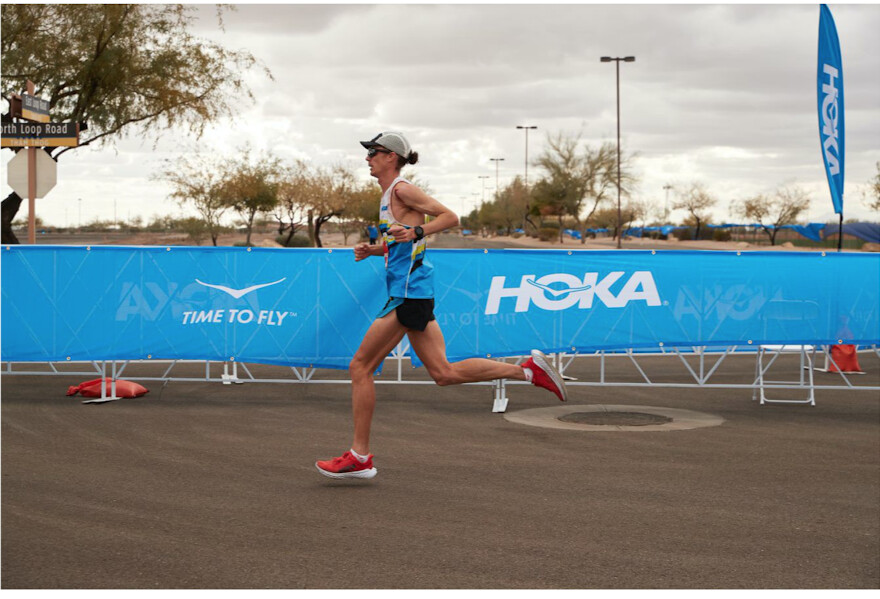
The brand itself has not yet made an official announcement about the change, and so far the new name appears to have largely gone unnoticed — likely because we were all referring to it as Hoka (full stop) already. If you’re a Hoka fan, have no fear — nothing has changed about the brand aside from the name. And if you currently own a pair of One One’s, you’ve officially got a relic.
(12/04/2021) ⚡AMPby Running magazine
Canadian releases Fukuoka Marathon documentary
Brett Larner of the Japan Running News website released his documentary on the iconic Fukuoka International Marathon, which saw its final running (open to locals only) on Dec. 6. Inside the Outside: When the World Came to Fukuoka tells the story of the non-Japanese runners, who, over the race’s long history, turned it into the unofficial world men’s marathon championship.
The film, which is introduced by Larner (and which he produced), does not focus on the 24 Japanese athletes who pushed each other to victory at Fukuoka over the race’s 75-year history, but on the foreigners who came to race there, giving the race an international profile and contributing significantly to its mystique. (Larner himself ran it in 2007 – the year that Sammy Wanjiru of Kenya, who would go on to win Olympic gold the following year, set a course record in his marathon debut.)

The first outsider to be interviewed is Pavel Kantorek of the former Czechoslovakia, who won Fukuoka in 1961. He raced there six times in all and never performed worse than fifth; he also ran in the Olympic marathon in 1956, 1960 and 1964. Kantorek, who was married at the time, comments that he kept getting invited to return because of his exemplary behaviour, unlike some of the runners, who were “more interested in the Japanese geisha than in racing.”
Other notable athletes interviewed include Amby Burfoot, who won the Boston Marathon in 1968 and was fifth at Fukuoka the same year, finishing just shy of the American record; double Olympic medallist Frank Shorter, who won Fukuoka every year from 1971 to 1974, who says “Fukuoka is where I was born as a marathon runner”; and Canada’s own Jerome Drayton, a two-time Olympian who won the Boston Marathon in 1977 and the Fukuoka Marathon in 1969, 1975 and 1976 (and his 1975 winning time, 2:10:09, was the Canadian marathon record for 43 years). Four-time Boston Marathon and NYC Marathon champion Bill Rodgers, who ran in the 1976 Olympics, won Fukuoka in 1977 and was third in 1975.
For many of the early Fukuoka runners, it was the first time they’d been invited to compete at an international marathon, and it became very prestigious on that basis. The meaning the race holds for them is obvious in their words, many of which were delivered via iPhone, thanks to the constraints of pandemic-style filmmaking. Fans of the marathon’s history will find a great deal of value in the film.
(12/04/2021) ⚡AMPby Running magazine
USATF’s relationship with Nike under criminal investigation
A grand jury is reportedly investigating the financial relationship between Nike and U.S.A. Track and Field. According to a report by Runner’s World, the U.S. Attorney’s Office for the District of Columbia has requested documents pertaining to USATF, its board of directors and three businesses, including Nike, Indianapolis marketing firm Matchbook Creative and New York media and commercial rights advisory firm Bevilacqua Helfant Ventures LLC.
The Runners World report outlines the Nike-USATF deal behind the investigation, which was announced in 2014 and started in 2017. The deal, which was thought to be worth more than $400 million, was meant to extend through to 2040 and pay USATF roughly $19 million per year.
This new agreement was a significant bump from their previous deal, in which Nike paid $10 million to the organization annually. The RW report says this new deal took USATF’s marketing budget from $12 million in 2014 to $22 million in 2019, according to 2019 tax filings made by the organization.

Bevilacqua Helfant Ventures LLC is also named on the subpoena because it is owned by the two former Nike employees who negotiated the deal, Chris Bevilacqua and Adam Helfant.
According to a 2016 Washington Post investigation, commission expenses were to be paid out to the firm for its part in the negotiations for the deal every year until 2039. The firm earned more than $900,000 in 2018 and 2019 from USATF, according to RW.

The third company named on the subpoena is Matchbook Creative, which has ties to USATF CEO Max Siegel. USATF is a client of the marketing firm, and the 2016 WP investigation reported that before it became Matchbook Creative, the firm was previously called a Max Siegel Company. The RW report also noted that employees at Matchbook previously had emails ending with @maxsiegelinc. RW goes on to detail Siegel’s earnings throughout the last seven years, which have been criticized as excessive for the CEO of a non-profit organization.
In 2019 he reportedly earned $1.197 million, over $400,000 more than the CEO of the U.S. Olympic and Paralympic Committee, Sarah Hirshland, despite the fact that USATF earnings were $33.7 million compared to the U.S. Olympic and Paralympic Committee earnings, which were $193.6 million. Meanwhile, all but the country’s top athletes are struggling to make a living without major sponsorships or support from USATF.
The size of the Nike/USATF deal, along with the significant payouts being made to the other entities named on the subpoena, has made some uncomfortable, and USATF critics are welcoming the investigation. You can read more about the investigation here.
(12/03/2021) ⚡AMPby Brittany Hambleton
St. Jude Memphis Marathon turns 20 as 17,000 runners return to the Bluff City
For Keri Nunley, participating in the St. Jude Memphis Marathon Weekend started as a way to honor her father, who died two decades ago after a battle with cancer. After his death, Nunley found out her father had long been donating to the children’s hospital and wanted his memorial fund to go to St. Jude.
A friend of hers was going to participate in the marathon weekend that year, the first iteration of the annual event in 2002, and invited Nunley to join. While she had never been a runner, she signed up and walked. And the McMinnville, Tennessee, resident has done it every year since.
Each year, more friends and relatives joined her, and the weekend became a family reunion, with Nunley’s relatives coming from as far as Pennsylvania, California, Florida and Texas. And while it remains a way to honor her father, Nunley also participates for another reason.
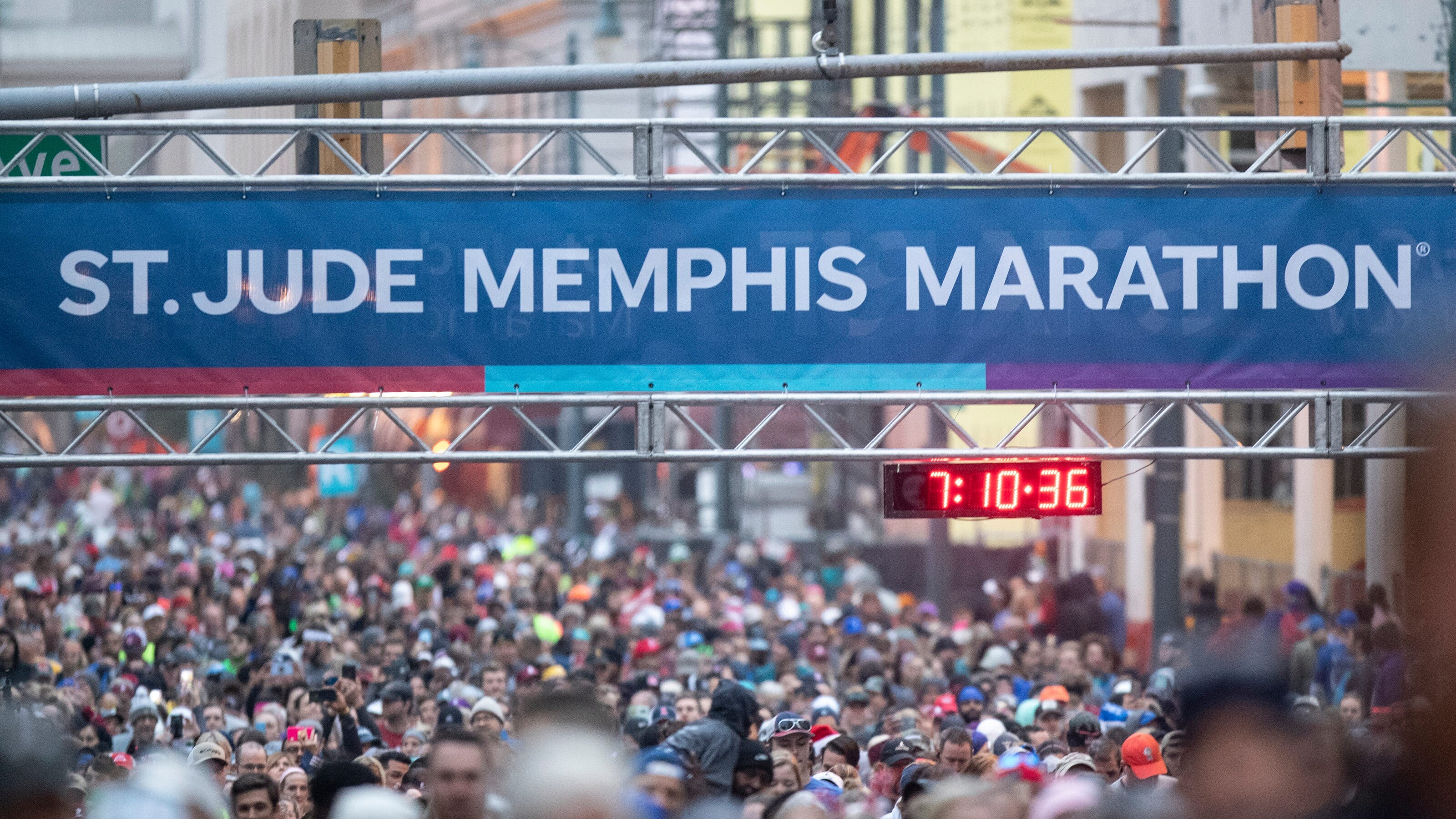
“I'm very passionate about the kids,” she said. “They need our help.”
Her favorite part of the half marathon was always passing by Target House, an apartment building provided for families of St. Jude patients who are on campus for more than three months.

“You run a little faster as you go by there with a mother standing out there with a sign, ‘Thank you for running for my kids’... It just pushes you to do more. It is a community,” she said. “There's houses along the route in neighborhoods that all of those people have gotten involved, and they're out there every year… It's amazing how much it has grown over the years.”
Over the years Nunley's team has raised about $300,000 for the hospital.
Saturday marks the 20th St. Jude Memphis Marathon, and Nunley is one of only a few people who have participated every year, according to the organization. But over the past two decades, the event has grown from a small, local fundraiser to an international event drawing thousands and raising millions.
Over the life of the race, it has raised more than $100 million for St. Jude. It is the largest single-day fundraiser the organization has. The goal for the 20th-anniversary race was to raise $9 million. According to ALSAC, the fundraising and awareness organization of St. Jude Children's Research Hospital, the race is on track to raise more than $12 million this year.
There will be more than 20,000 people participating in the marathon weekend in 2021. About 17,000 will be running or walking in person, while the rest are participating virtually. Those runners come from all 50 states and 71 different countries.
Last year's all-virtual event raised $7.5 million. About 15,000 people participated.
The race is also more than a fundraiser for St. Jude, it's a community event, drawing area residents to the course to cheer for the runners and walkers and filling up Memphis hotels, restaurants, cafes and bars.
Annually — with the exception of 2020, when the races were all virtual — the race has a multi-million economic impact on the city and the wider region. According to Memphis Tourism, the 2021 race is expected to fill almost 4,000 hotel rooms.
(12/03/2021) ⚡AMPby Corinne S Kennedy
St Jude Memphis Marathon
The St. Jude Memphis Marathon Weekend is more than just a race. It's an action-packed weekend of fun, food and entertainment! Start and finish lines two blocks apart and near a dozen Downtown hotels, lots of restaurants, and Beale Street, the Memphis entertainment district. Dynamic finish in AAA baseball stadium, with use of locker rooms and shower facilities. Wave start,...
more...Six nutrients you might be missing in your diet
Eating properly in order to run well is more than just simply trying to consume enough calories. It also involves eating a variety of the right foods to ensure you’re meeting your daily requirements of vitamins and minerals.
Running can deplete your stores of important nutrients and put you at risk for deficiencies, but you can help yourself out by knowing which nutrients to be mindful of and how to know if you’re not getting enough.
This is one of the most common deficiencies among runners, particularly females. Since iron is necessary for transporting oxygen to your muscles and plays an important role in energy production, a deficiency can wreak havoc on your ability to run.
1.- Iron

The most common signs of an iron deficiency are unexplained fatigue, weakness, pale skin, shortness of breath, heart palpitations, cold hands and feet, brittle nails and hair loss.
Foods that are high in iron include red meat, liver, dark leafy green vegetables, beans, nuts, dried fruit and fortified cereals. Vitamin C aids in your absorption of iron, so eating iron-rich foods with good sources of vitamin C, like citrus fruits or bell peppers, can also improve your nutrient status. Many runners also choose to take an iron supplement, however you should talk to your doctor and have bloodwork done before starting a supplementation protocol, since taking too much iron can have dangerous consequences.
2.- Magnesium
Magnesium plays an important role in bone health and helps convert the food you eat into energy. Muscle spasms and cramps are common signs of magnesium deficiency, as well as irregular heart rhythms, nausea and vomiting and dizziness and confusion.
Good sources of magnesium include whole grains, dark leafy green vegetables, low-fat milk, yogurt, dried beans and legumes and nuts.
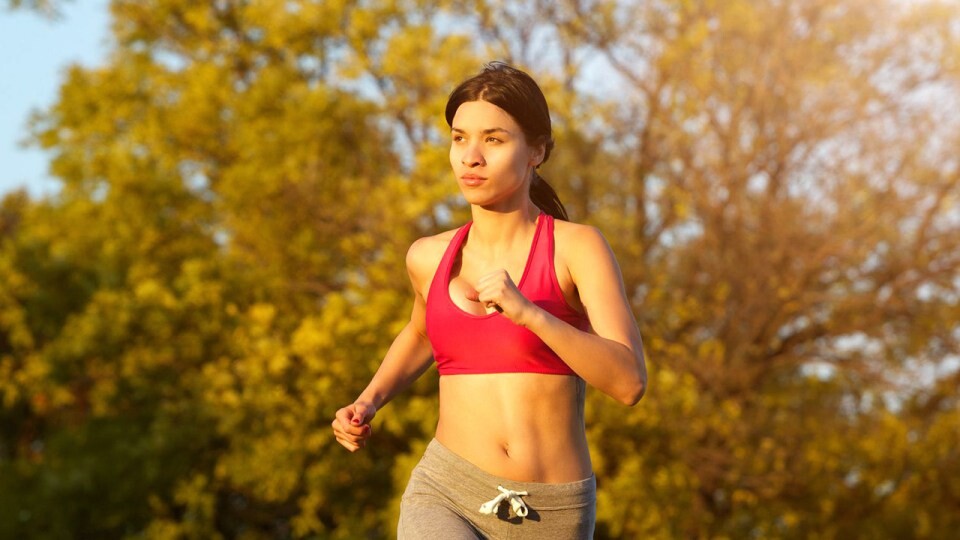
3.- Vitamin D
Vitamin D regulates the amount of calcium in your body, which makes it very important for your bone health. Recent research has also found that it plays a crucial role in the health and function of your immune system. Symptoms of a deficiency include muscle weakness, pain, fatigue and low mood or depression.
Your body synthesizes vitamin D when your skin comes in contact with sunlight, however most Canadian runners don’t get adequate sunshine exposure because of our long winters and use of sunscreen in the summer. There are some food sources of vitamin D, such as oily fish (like salmon or sardines), red meat, liver, egg yolks and fortified cereals, however many nutrition experts recommend taking a vitamin D supplement to ensure you meet your daily requirements.
4.- Calcium
Calcium is important for maintaining strong bones and preventing bone stress injuries, but it’s also a key nutrient for ensuring proper muscles contractions and the healthy functioning of your heart. Muscle spasms or cramps, low mood, weak or brittle nails, confusion or memory loss and frequent stress fractures.
Of course, dairy products like milk and cheese are a good source of calcium, but green leafy vegetables and fortified foods (like non-dairy milk alternatives and bread made with fortified flour) are good sources as well.
5.- Vitamin B12
Vitamin B12 maintains the health of your nerves and blood cells, and also prevents megoblastic anemia, which makes you feel very tired and weak. Other symptoms of vitamin B12 deficiency include pale skin, pins and needles, disturbed vision, irritability and low mood.
Good food sources of vitamin B12 include meat, milk, fish, eggs fish and cheese, as well as some fortified breakfast cerials. Runners who follow a vegan diet are more likely to be deficient in vitamin B12, so they should speak with a dietitian about taking a vitamin B12 supplement.
6.- Zinc
Zinc is important for maintaining proper immune function and helps your body process the fats, carbohydrates and proteins from your diet. Symptoms of zinc deficiency may include hair loss, a compromised immune system and loss of appetite.
Oysters, red meat and poultry are excellent sources of zinc, and whole grains, milk products and fortified cereals are also good sources of the mineral. Baked beans, chickpeas, and nuts (such as cashews and almonds) also contain some zinc.
(12/03/2021) ⚡AMPby Brittany Hambleton
Omicron variant complicates travel home for Canadian ultrarunners Remi Poitras and Jean-Francois Cauchon in South Africa
Running 100 kilometers was something Remi Poitras always wanted to accomplish, so when he had the chance to compete at the Ultra-Trail Cape Town 100K last weekend in South Africa, he could not pass up the opportunity.
Poitras finished 26th out of the 237 runners who started the race, in 13:26:56. Although he had a great result in his 100K debut, the toughest part for Poitras has been trying to get home.
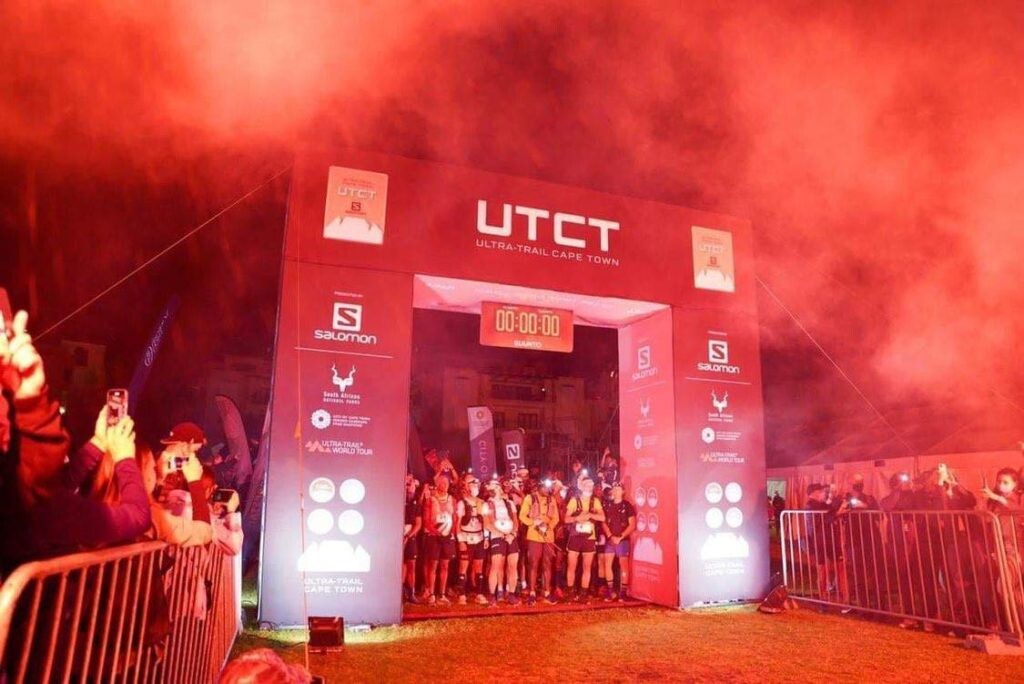
Poitras, a Moncton, N.B., native, always wanted to visit Cape Town to race internationally, but when he found out that international borders were closed to tourists, he was stuck in South Africa with fellow Canadian ultrarunner Jean-François Cauchon, who finished sixth overall at UTCT, seeking answers.
“In Cape Town, I didn’t notice anything out of the usual regulations we had in Canada,” Poitras says. “Locals were more concerned about the closures of the tourism industry.”

Since there are no direct flights to Canada from South Africa, there are only a few ways to travel. One option is to travel through Europe, but many major airlines such as Air France and KLM have stated that they will carry EU passengers only. The only city in North America that connects with Johannesburg is Atlanta, Ga., but again, U.S. citizens only. Another option to get back to Canada is to fly through Addis Ababa, Ethiopia, a country currently dealing with a civil war between the government and rebel groups.
Flights out of South Africa have reached high prices for tourists, and the airports are packed with tourists from Europe and North America looking to get home. “I tried connecting with the Canadians Abroad emergency hotline to see what they know and what they could do,” says Poitras. “After six days of no news or communication from the Canadian government, I decided to take matters into my own hands and book a flight to London.”
Unfortunately, there aren’t many PCR testing centres in South Africa, yet both Canada and Great Britain require negative results upon entry. “Keeping us all here is only prolonging our exposure,” says Poitras. “Everyone is scrambling trying to find a way home, the government isn’t helping us.”
Update: On Dec. 2, Cauchon and Poitras left South Africa on a flight to London, England, where they both await the results of their PCR tests to return to Canada. Poitras looks back on his first Ultra-Trail race as an unbelievable experience and hopes to conquer more ultras in 2022.
(12/03/2021) ⚡AMPby Marley Dickinson
Oregon distance runner Cooper Teare leaves Ducks for pro career with Nike
The Ducks’ star distance runner recently signed a sponsorship contract with Nike and will not return for what would’ve been his senior season of indoor and outdoor track.
“I’ve loved every second of being a Duck,” Teare said. “It was kind of a hard decision but I’m happy I’m with the one I made.”
Teare leaves Oregon as a two-time collegiate record holder (indoor mile and distance medley relay), a two-time NCAA champion (DMR and outdoor 5,000), and three-time school record holder (5,000, mile, DMR).
All of those accomplishments came during a memorable junior season in 2021 when Teare and former teammate Cole Hocker spent six months keeping Oregon’s men’s distance program in the national spotlight as they raced together through the U.S. Olympic Track & Field Trials at Hayward Field.
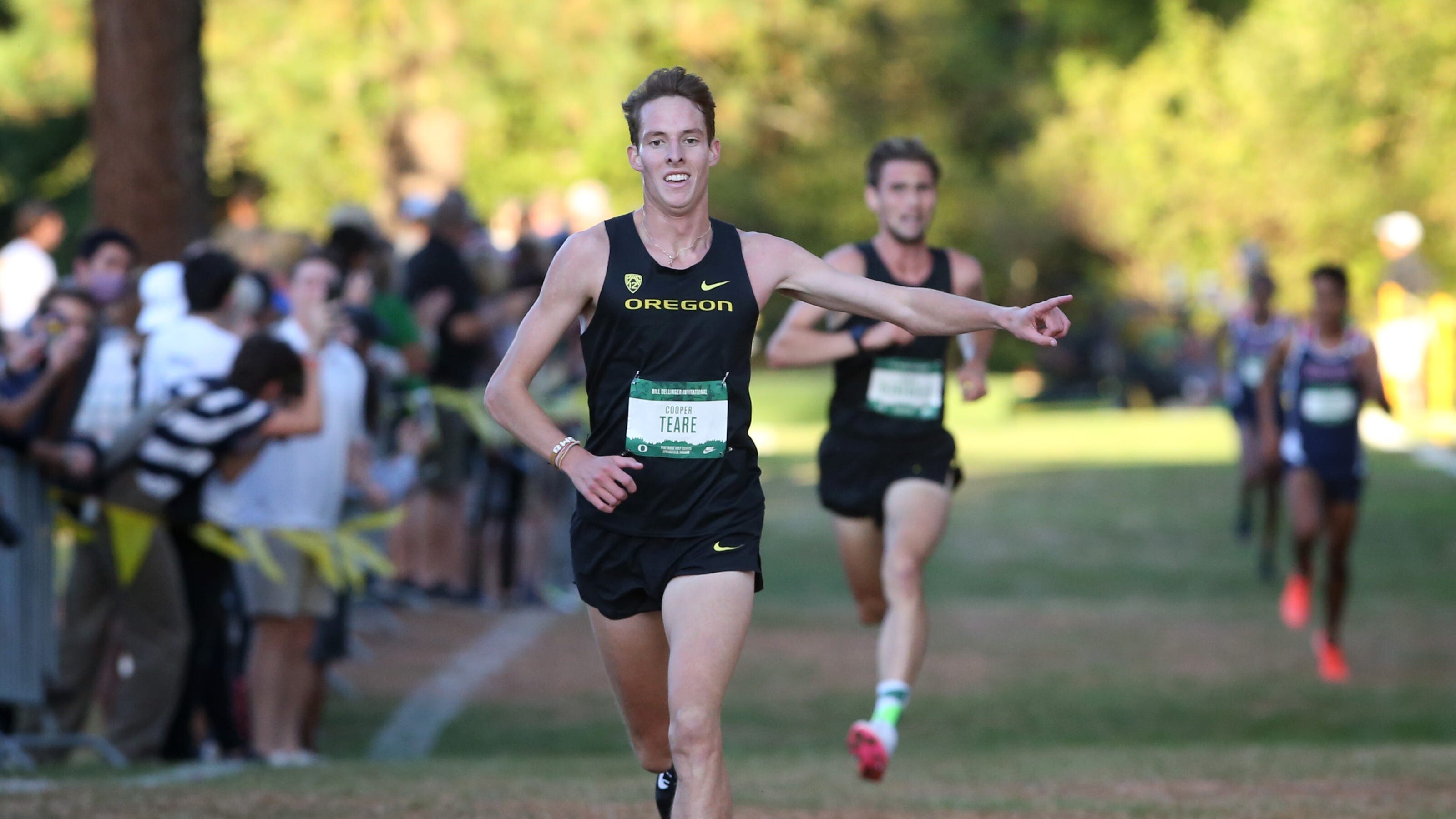
That’s where Teare’s season ended, with a fourth-place finish in the 5,000 meters. Hocker won the 1,500 and finished sixth at the Tokyo Olympics before leaving the Ducks after one season to sign with Nike in September.
Teare said he also had an opportunity to turn pro over the summer, but wanted to run one more cross country season for Oregon as he wrapped up his business degree.
“I’ve sort of been going through the process for months now,” Teare said. “Some people thought I was going to turn pro right after the outdoor track season so it was nice to have a little bit of extra time to go through the motions and talk to the people I had to talk to.”
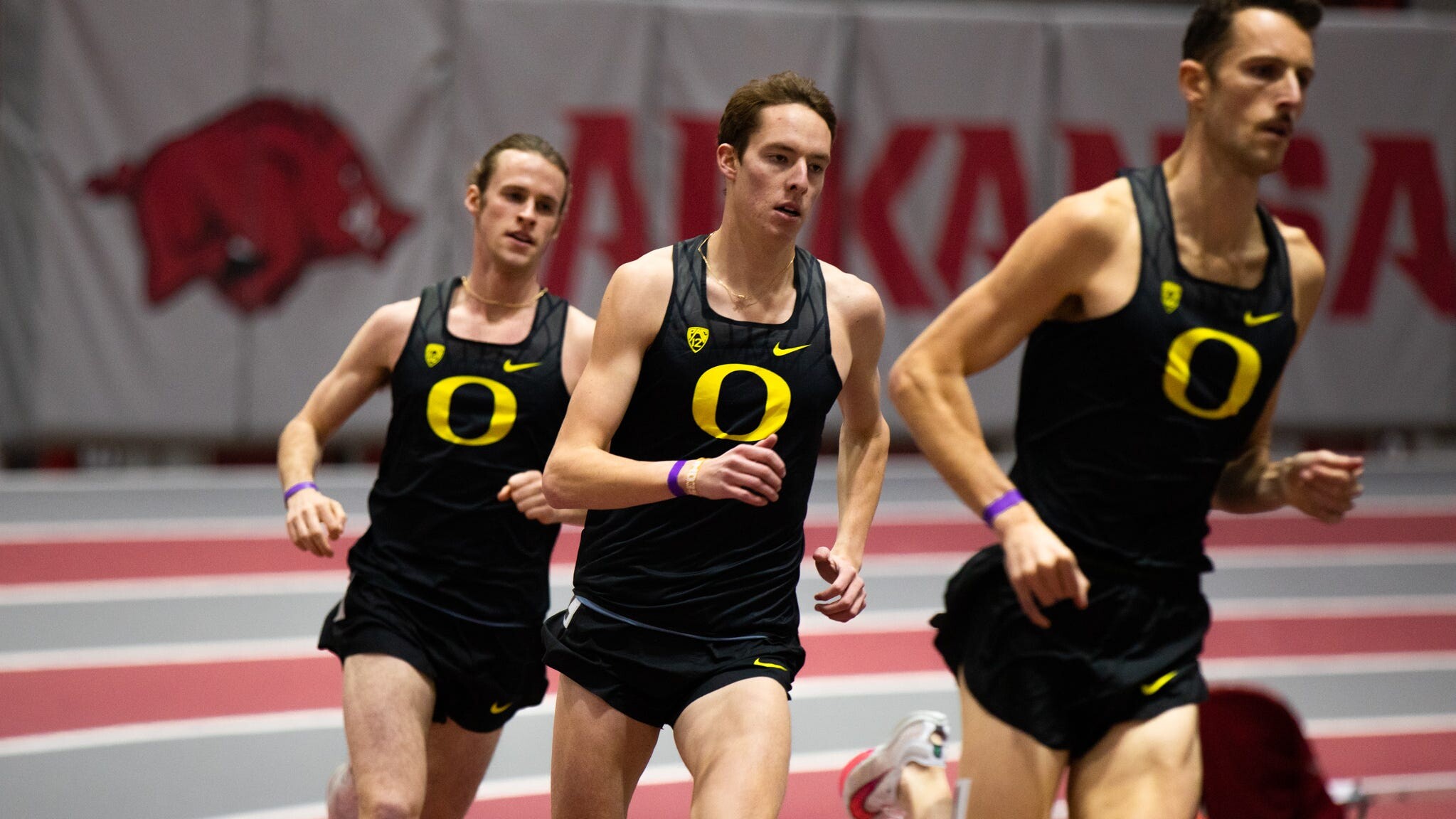
The cross country season opened on a positive note as Teare earned his first collegiate victory at the Bill Dellinger Invitational at Pine Ridge Golf Club in Springfield. He was also the runner-up at the Pac-12 championship meet.
But at the NCAA championships on Nov. 20, Teare’s legs gave out late in the 10,000-meter race and he crawled his way to the end before regaining his balance long enough to collapse across the finish line in 247th place — just three spots out of last.
“I left nothing in the tank and it just wasn’t my day,” said Teare, who was a cross country all-American in 2019 when he finished sixth. He didn’t compete in cross country during the delayed 2020 season.
Teare said it didn’t take long after that race to decide his collegiate days were done.
“That was a hard way to end it off but also I felt it was time to start a new chapter,” he said. “I talked to my coaches and we all got on the same page and everything fell into place and made sense. … I was considering going pro up right up until the start of cross country.
"The nice thing was (Nike) had seen enough of me and I had proven myself to the point where cross country wasn’t going to change much. They were ready to support me no matter what happened.”
His performance at the cross country championships did nothing to dim the track season he had earlier this year, which was highlighted by a collegiate record in the indoor mile at 3:50.39 and winning the outdoor title in the 5,000 when he ran 13:12.27. That is the fastest time ever by an American collegian and second all-time only to Henry Rono’s 1978 record of 13:08.4.
Teare is staying in Eugene to begin his professional career and will continue to be coached by Oregon associate head coach Ben Thomas. Hocker has a similar arrangement and Teare has been able to witness first-hand his training partner’s transition to the pros during the last few months.
“It was kind of nice having Cole as the guinea pig,” Teare said with a laugh. “It’s been kind of cool to see him go about figuring it all out and I think that will make it easier for me as well.”
As Teare wraps up his final days in the classroom, he is mapping out a path to next summer and what it will take to compete in the World Athletics Outdoor Track & Field Championship meet at Hayward Field.
“It doesn’t feel real,” Teare said. “It hasn’t really set in. It’s really hard to get a grasp of, OK, now I’m doing this as my job. I think once I’m done with school here in the next week it’s going to start to feel more real.”
(12/02/2021) ⚡AMPby Chris Hansen
How to eat to speed up recovery, simple improvements to your diet can help you get back on the road faster
There is no quick fix for running injuries. Healing them takes time and patience, but the right nutrition strategies can speed up the process so you can get back on the road as soon as possible.
If you’re currently sidelined with an injury, take a look at your diet to see if there’s any room to optimize your nutrition for injury recovery, and check out these tips to help you get better faster.
Don’t cut calories
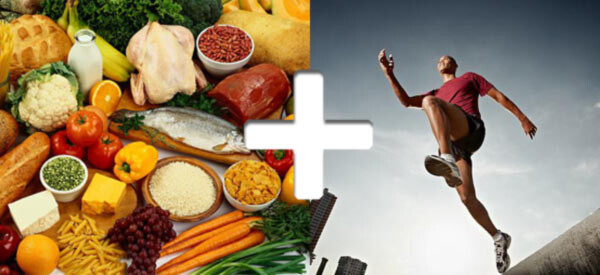
When dealing with an injury, many runners are tempted to cut back on their caloric intake because they’re not expending as much energy as they would if they were still training, but this is a mistake. Restricting calories can slow down the recovery process, so make sure you continue eating, focusing on good nutrition (more on that in a minute). Depending on the severity of the injury, you may even need more calories, so if you’re unsure how much you should be eating while recovering from an injury, talk to a dietitian with a background in sports nutrition for guidance.
Protein helps build and repair muscle tissue, so when you’re trying to heal an injury it’s important to get plenty of protein in your diet. This is even more crucial if the injured area has to be immobilized for any length of time because you’re at a greater risk for muscle loss. Leucine, one of the branched-chain amino acids (BCAA’s) that make up complete protein is particularly important because of its ability to stimulate muscle protein synthesis compared to other amino acids. Foods high in leucine include chickpeas, soy-based products, eggs, chicken, salmon and beef.
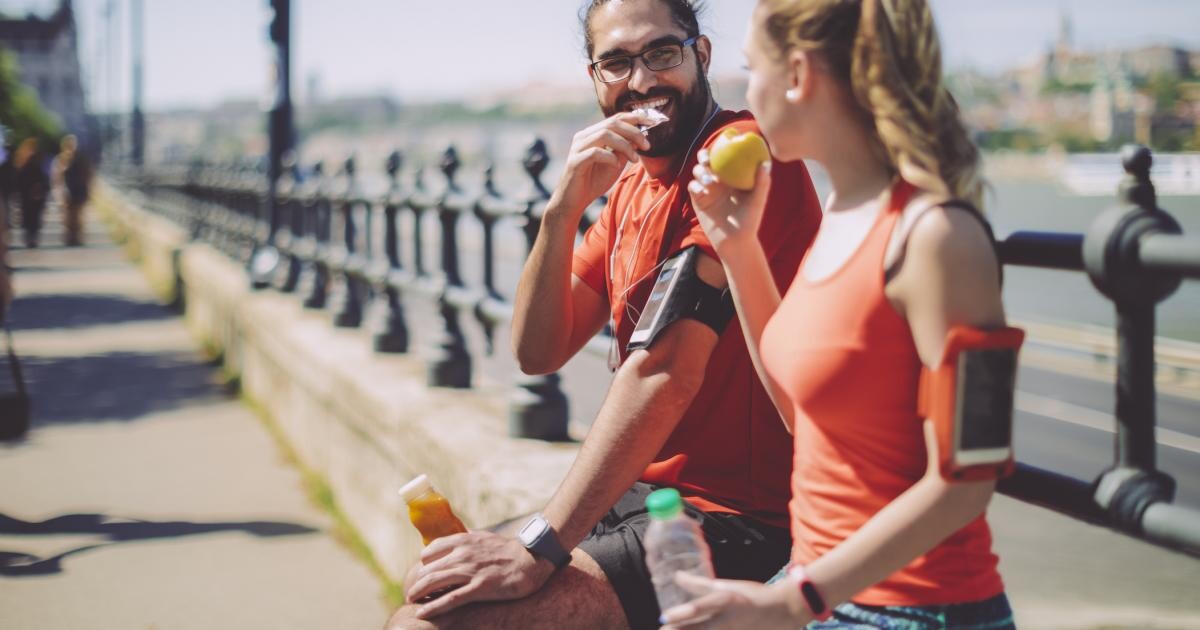
Eat carbohydrates
For a similar reason to cutting calories, some runners think they should eat fewer carbohydrates while they’re injured since they don’t need the fuel for their runs. When you eat too few carbohydrates (and again, not enough calories), you risk your body having to dip into your protein stores for energy. This prevents the protein you eat from being used to repair an injured muscle, which slows down the recovery process.
Increase your omega-3 intake
Omega-3 fatty acids help decrease recovery time by reducing inflammation, so make sure you’re including plenty of fatty fish and seafood (like salmon, tuna and sardines), nuts, seeds and fortified products like eggs, yogurt and milk.
Get plenty of vitamin C
The sunshine vitamin is a mandatory co-factor in collagen formation, which is a main component of bone, muscle and skin. Eating more vitamin C will help improve your body’s collagen formation, thus expediting your injury recovery.
Up your calcium and vitamin D intake
If your injury is bone-related, you should aim to increase both of these bone-building nutrients. Calcium is crucial to building and repairing bone, but without adequate vitamin D, your body will have difficulty absorbing the calcium from your diet. It can be difficult to get enough vitamin D in the winter months, so focus on eating plenty salmon, eggs and fortified foods, and talk to your doctor about adding a supplement to your diet.
Eat plenty of fruits and veggies
When you’re recovering from an injury, you want to get as many vitamins and minerals as possible because when you support your overall health, you support the injury recovery process. Do your best to make sure you’re including a variety of fruits and vegetables in your diet every day to ensure you aren’t missing out on anything.
(12/02/2021) ⚡AMPby Brittany Hambleton
Kenyan Geoffrey Kamworor faces tough test on fast course in Valencia
Kenyan leads strong line-up in the marathon on Sunday and judging by past results we are likely to see some very fast times
Geoffrey Kamworor believes he can break the world marathon record in future and possibly dip inside two hours. This Sunday (Dec 5) should offer clues as to whether he’s correct when he takes on a strong field on a super-fast course in Valencia.
The Maraton Valencia Trinidad Alfonso EDP takes place in a Spanish city that has hosted a number of record-breaking distance running performances lately. Before he thinks about getting close to Eliud Kipchoge’s world marathon record of 2:01:39, though, Kamworor must first win the race – and it won’t be an easy task.
Kamworor’s marathon best is “only” 2:06:12 but that dates back to 2012. In recent years he has focused on the New York City Marathon – which has no pacemakers and a slowish course – and which he has won in 2017 and 2019.
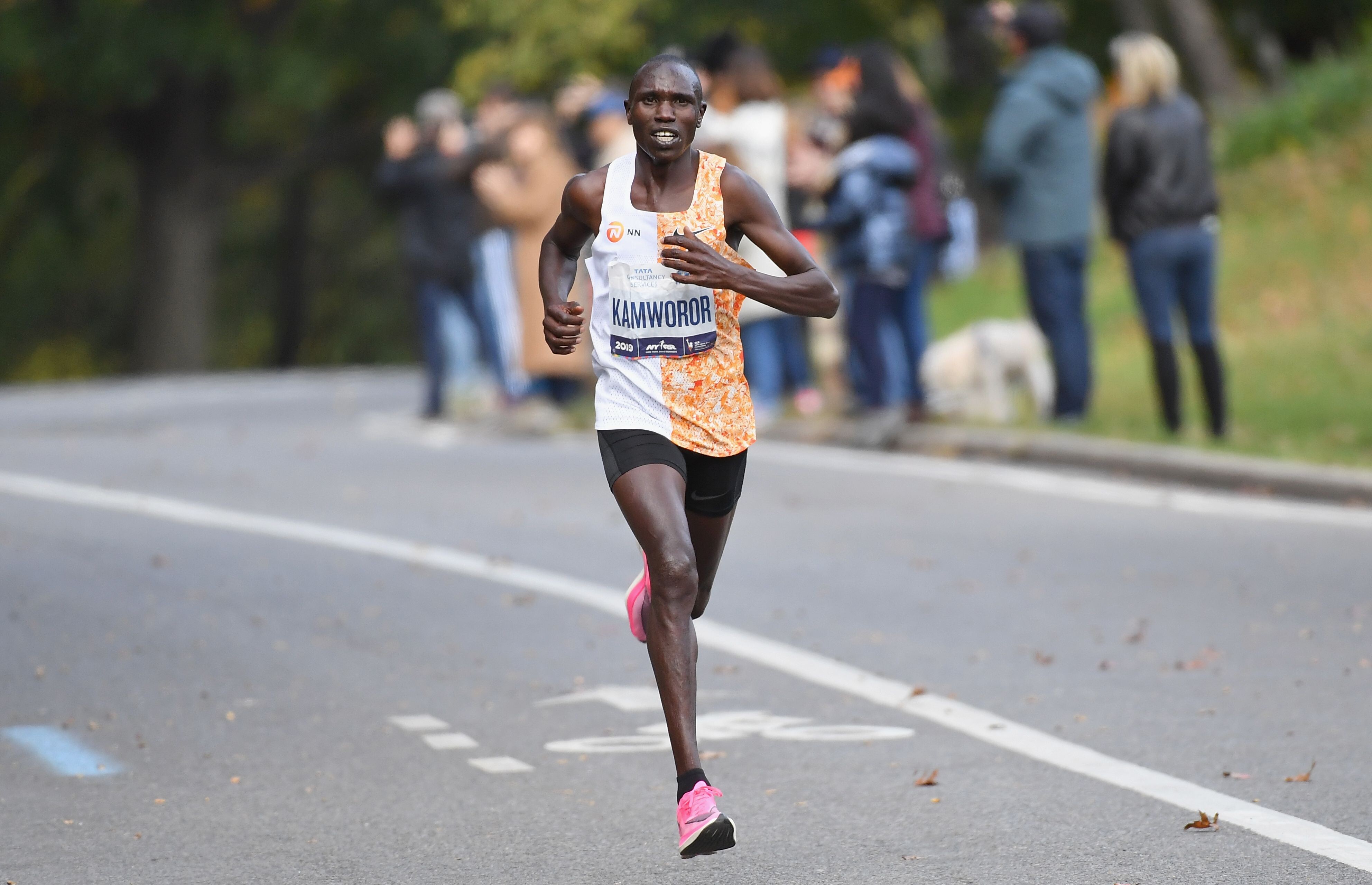
Kamworor is also a former world cross-country winner and has a good record in Valencia, as he won his third world half-marathon title in the city in 2018. When it comes to marathon potential, he will no doubt be comparing his fitness to training partner Kipchoge – as they are coached by the same man, Patrick Sang – although the 28-year-old is also on the comeback from a car accident last year.
“I have big dreams and ambitions in the marathon and want to run as fast as possible and break barriers,” he says. “Valencia will be ready to help us push our limits on race day and I am sure it will be amazing.”
Facing him in the marathon on Sunday are fellow Kenyan Lawrence Cherono, a former winner of the Boston and Chicago marathons with a best time of 2:03:04, which makes him the fastest in the field.
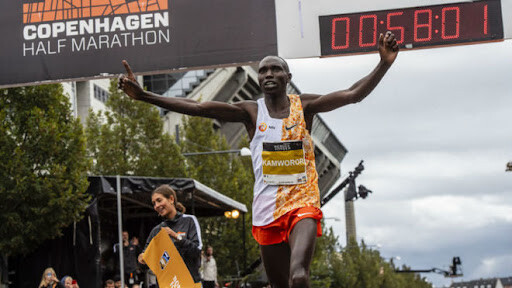
There is also Kinde Atanaw of Ethiopia, who won the Valencia Marathon in 2019 in 2:03:51 and was poised to run in London in October but had to withdraw after a positive Covid test.
In addition there is Herpasa Negasa of Ethiopia, who has a best of 2:03:51, another Ethiopian, Chalu Deso, who has a PB of 2:04:53, Tanzanian 2:04:55 man Gabriel Geay and Sondre Moen of Norway – the latter of whom held the European record until 2019.
Altogether there are three men who have run sub-2:04:00 and eight who have broken 2:06:00, which makes Kamworor only the 10th fastest in the field based on PBs.
The women’s field is not quite as strong, but is led by 2:20 performers Guteni Shone and Asmera Gebru of Ethiopia plus 2:21 runners Bornes Chepkirui of Kenya and Bedatu Hirpa of Ethiopia. Watch out too for Nancy Jelagat, who has a 65:21 half-marathon PB.
Sonia Samuels, Alice Wright and Norman Shreeve are among almost 500 British runners in the race, although the 16,000-strong field is of course dominated by more than 9000 runners from Spain. Samuels has a best of 2:28:04 but is now 42, whereas the US-based Wright is aiming to finish her first marathon.
There is a strong Irish contingent too which includes 2:26:47 runner Fionnuala McCormick, who ambitiously plans to run the European Cross Country Championships seven days later in Dublin.
The race is also taking place for the 41st time. The first race in 1981 was won by Teodoro Perez in a modest 2:57:55 with Nuria de Miguel the first woman home in 3:20:50.
After those humble beginnings the winning times began to improve rapidly, though, and in 1984 Vicente Anton won in 2:14:01 and the women’s winner Juana Pablos Acosta was inside three hours with 2:57:28.
Now in the era of super-shoes, the last four editions have been won in 2:05:15 (Sammy Kithara), 2:04:31 (Leul Gebresilase), 2:03:51 (Atanaw) and 2:03:00 (Evans Chebet) in an elite-only race minus the masses in 2020.
The last two women’s title, meanwhile, have gone to Roza Dereje in 2:18:30 in 2019 and Peres Jepchirchir with 2:17:16 in 2020. The latter of course went on to win the Olympic title this year.
(12/02/2021) ⚡AMPby Jason Henderson
VALENCIA TRINIDAD ALFONSO
The Trinidad Alfonso EDP Valencia Marathon is held annually in the historic city of Valencia which, with its entirely flat circuit and perfect November temperature, averaging between 12-17 degrees, represents the ideal setting for hosting such a long-distance sporting challenge. This, coupled with the most incomparable of settings, makes the Valencia Marathon, Valencia, one of the most important events in...
more...Michael Johnson's iconic gold spikes join the Heritage Collection
To mark the 226th World Athletics Council Meeting in Monaco, a special Heritage display was staged this week in the foyer of Le Meridien Beach Plaza. The exhibit contained 15 recent acquisitions made by the World Athletics Heritage Collection, which will soon be on display in glorious 3D in the virtual Museum of World Athletics (MOWA).
One of the oldest artefacts exhibited was a solid silver trophy donated by Kenya’s Olympic legend Kipchoge Keino, and one of the youngest items on show was a Tokyo 2020 Olympic Torch.
Yet arguably the greatest recent addition to the collection are three running spikes worn by eight-time world champion and four-time Olympic Games gold medalist Michael Johnson.
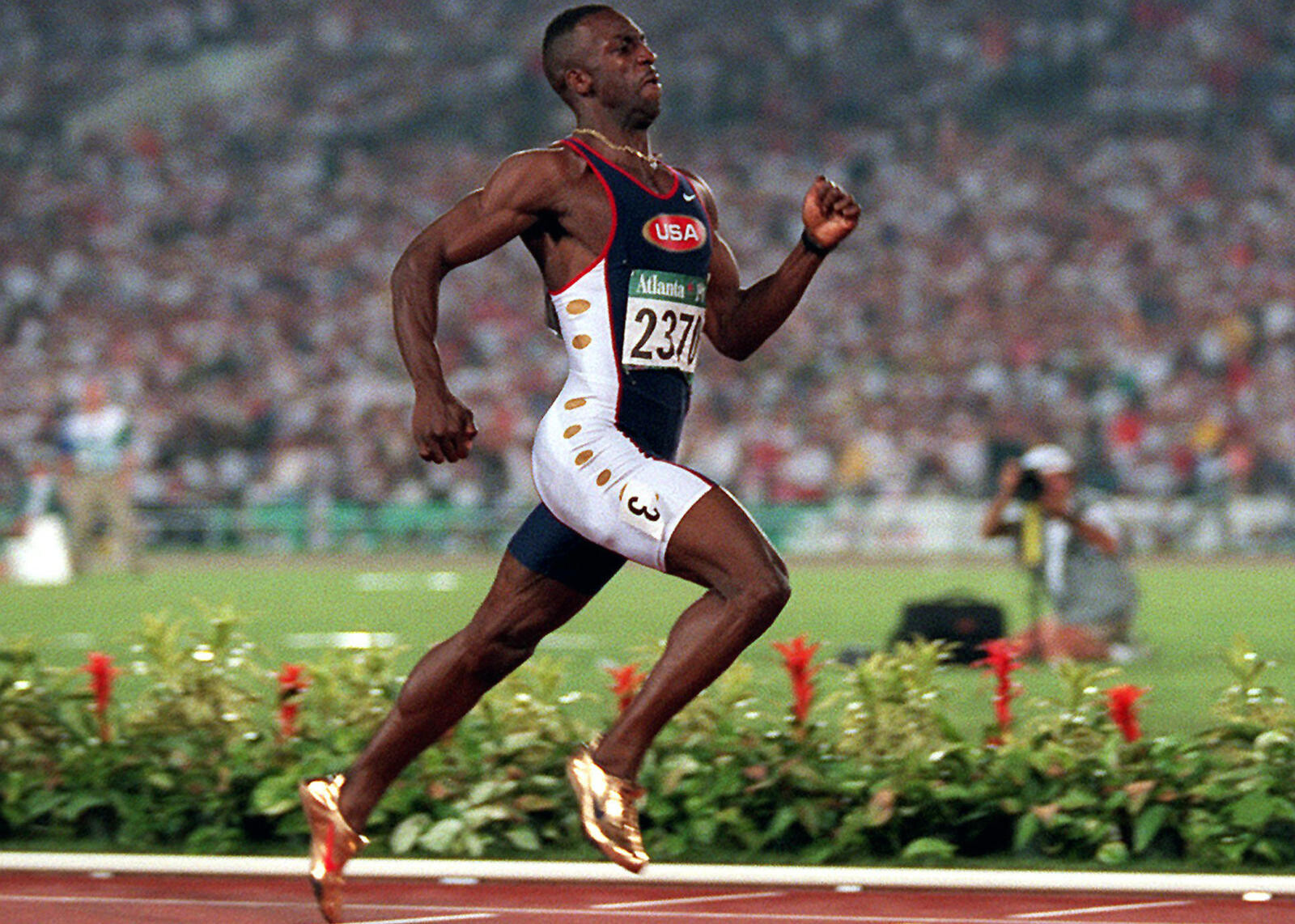
Entering the collection is one of Johnson’s iconic gold spikes from Atlanta 1996 (right foot), one from Sydney 2000 (left foot), and thirdly, a shoe from Johnson’s final race in 2001 (right foot). Each shoe is autographed.
“I can still vividly remember the chills I felt…”
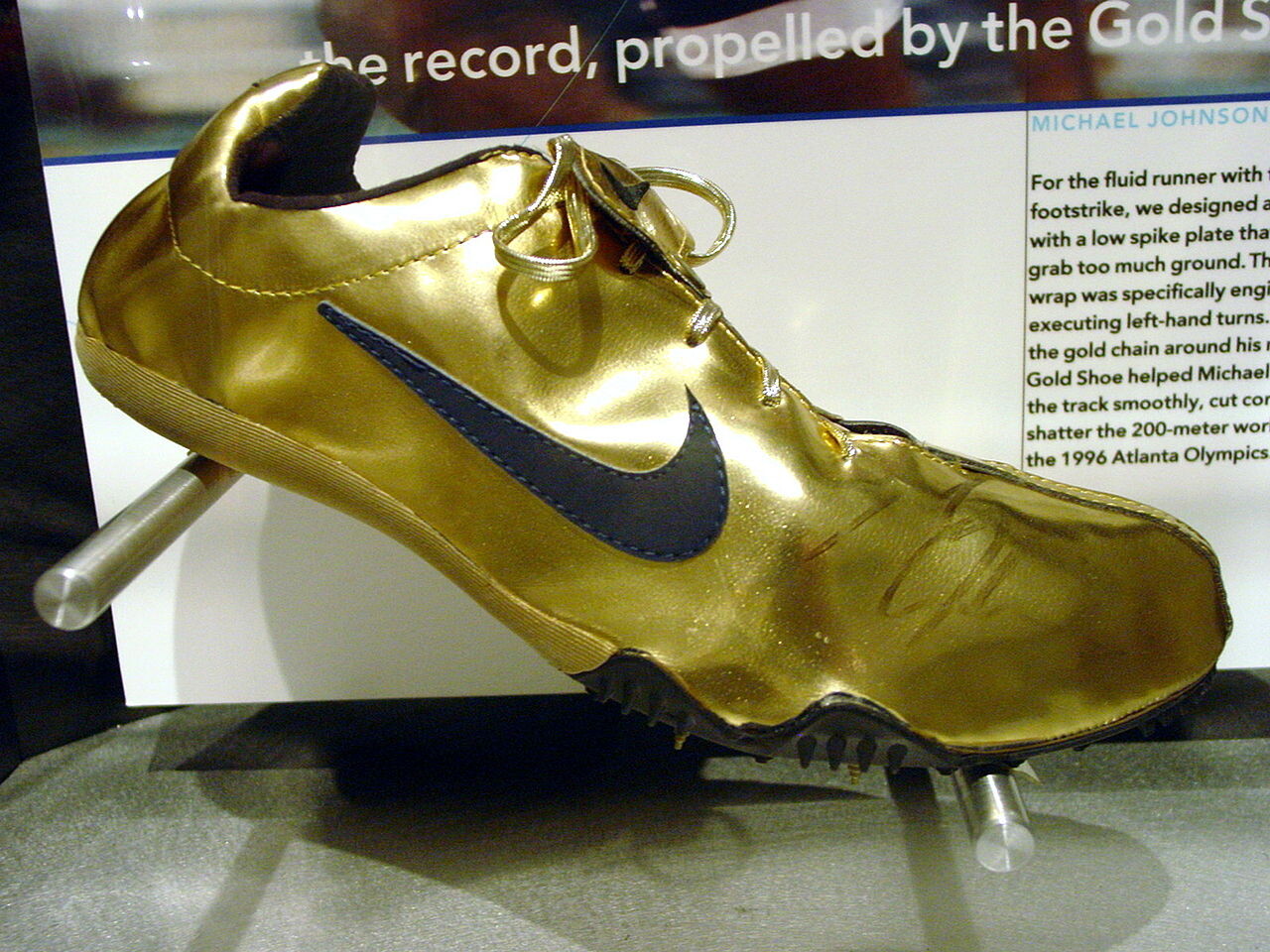
The trio now form part of the World Athletics Heritage Collection thanks the extraordinary generosity of Brad Hunt, who was Johnson’s agent during his outstanding running career.
“I visited the Heritage exhibition while at the 2019 World Athletics Championships in Doha,” commented Hunt. “The scale of the collection was particularly impressive, considering it had only been created in 2018.
“The historic display of artefacts included items from the careers of Jesse Owens, Carl Lewis and Usain Bolt. In men’s sprinting history, there was one glaring omission. By offering the spikes which Michael (Johnson) gave me after some of his most memorable races, I hope to have helped fill that gap in the World Athletics Heritage Collection,” added Hunt.
Johnson stunned the world of sport in 1996. At the Atlanta Games he won an unprecedented Olympic men’s 200m and 400m double. In the process, with a 19.32 clocking, Johnson destroyed his own 200m world record (19.66) which he had set less than two months before the Games on the same track at the US Olympic Trials.
“Both Olympic shoes were given to me two or three weeks following the Games they were used in,” confirmed Hunt. “The 1996 shoe was given to me in Hawaii, where we travelled for our post-Olympic celebrations. The 2000 shoe was given to me in Los Angeles.
“I can still vividly remember the chills I felt when I became the first person Michael told of his decision to wear gold spikes in the 1996 Olympic Games. We were sitting on a flight to Los Angeles from the Atlanta Olympic Trials to Los Angeles for Michael's first appearance on The Tonight Show with Jay Leno.
“Michael had just set his first world record (19.66 200m) the day before (23 June). We were discussing how much attention his purple spikes had received when he declared he would be wearing gold in the Games.”
14c gold in the material
Four years later, Johnson retained his Olympic 400m title in Sydney, Australia. Johnson had become world record-holder for the distance (43.18) at the World Championships in Seville, Spain, the previous year.
“Although the 2000 shoe is made with actual 14c gold in the material, thus making them shinier (with significantly more material value), the 1996 shoe is my favourite because these gold shoes were an actual media phenomenon!
“The amount of secrecy involved with the shoes' clandestine development and historical Olympic debut created one of the strongest identities an athlete has ever had with his or her footwear,” concluded Hunt.
The following year Johnson undertook his ‘Golden Victory Lap’ tour, finishing his career at the Goodwill Games in Brisbane. It is one of the shoes which he wore in that last season which completes this extra special induction of footwear into the World Athletics Heritage Collection.
The three spikes will soon be on display in the virtual MOWA.
In 2022, the spikes will also go on public show at MOWA’s onsite public exhibitions in Portland and Oregon, USA, in the lead into and during the World Athletics Championships Oregon22.
(12/02/2021) ⚡AMPby World Athletics
Olympic champs Elaine Thompson-Herah of Jamaica and Karsten Warholm of Norway have been named the World Athletes of the Year at the World Athletics Awards 2021
Elaine Thompson-Herah of Jamaica and Karsten Warholm of Norway have been named the World Athletes of the Year at the World Athletics Awards 2021, a ceremony held virtually on Wednesday (1).
Thompson-Herah produced one of the finest sprint seasons in history this year, retaining her Olympic 100m and 200m titles in Tokyo and adding a third gold medal in the 4x100m relay. On top of her Olympic triple, she also clocked world-leading times of 10.54 and 21.53 over 100m and 200m respectively, moving to second on the world all-time lists and coming within touching distance of the long-standing world records.
“I just take it year by year,” said Thompson-Herah. “I went very close to the world record so you know, anything is possible. No spikes hanging up any time soon!
“The World Championships in Oregon is most definitely my next big target,” she added. “It is close to home, I hope friends and family can come out and watch. I hope I get some crowd as well. That couldn’t happen in Tokyo but hopefully in Eugene I can get my friends and family to come and cheer me on.”
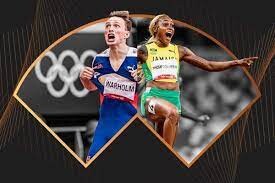
Warholm uncorked one of the most remarkable performances in athletics history when he stormed to gold in the 400m hurdles at the Tokyo Olympics. Having already broken the world record with 46.70 in Oslo in the lead-up to the Games, Warholm exceeded all expectations in the Japanese capital to claim gold in a stunning world record of 45.94. In a race of incredible depth, the top three athletes finished inside the pre-2021 world record.
“I’m so happy for this,” said Warholm. “First when I saw the time (in Tokyo), I was like, ‘This must be a mistake!’ Because I didn’t see that one coming. And I didn’t see the victory coming before crossing the finish line.
“It was a very intense race, I knew the American and the Brazilian and all the other guys were really chasing me. I always go out hard and I never know what is going on behind me. I was just fighting all the way to the finish line. When I realised 45.94 was the reality, I was thinking: ‘This is not too bad. I’ll take it!’"

World Athletics President Sebastian Coe congratulated all of tonight’s winners and finalists on their extraordinary achievements this year.
"We have this year celebrated some jaw-dropping performances in Tokyo, at the World Athletics U20 Championships in Nairobi and through our one-day meeting circuits – the Wanda Diamond League and the Continental Tour. So we’re delighted to recognise some of our stars at tonight’s awards.
"As a sport, we are in an incredibly strong position. 2021 has been an excellent year. We cemented our position as the number 1 Olympic sport coming out of Tokyo, we have the most God given talented athletes on the planet and our sport is the most accessible of all sports. Thank you to all our athletes around the world. I am looking forward to watching what you can all do in 2022."
The other award winners were:
Female Rising Star
Athing Mu
The US teenager was undefeated at 800m all year, winning Olympic gold at the distance following a long but successful collegiate season. She broke the senior US 800m record with her triumph in Tokyo and then improved it to 1:55.04 just a few weeks later. She also excelled at 400m, clocking a North American U20 record of 49.57 for the distance.
“It means the world to know that my support goes beyond friends and families and extends worldwide,” said Mu. “This award shows all young girls that your dreams can, indeed, come true."
Male Rising Star
Erriyon Knighton
Throughout 2021 the 17-year-old took down several marks that had belonged to sprint legend Usain Bolt. Knighton first set world U18 bests of 20.11 and 20.04 over 200m, but his rapid rise continued and he broke Bolt’s world U20 record for the distance with 19.88 and 19.84. He went on to finish fourth in the Olympic final with 19.93.
“I’m really thankful for this award,” said Knighton. “One of my most memorable moments of this year was making it to the Olympic final in Tokyo and finishing fourth at the age of 17.”
Member Federations Award
Federacion Costarricense de Atletismo (Costa Rica)
In recognition for their outstanding training, competition and development programme roll-out over the past 12 months, for their consultative work on the World Athletics Kids’ Athletics programme, and for successfully staging a host of international events over the past year.
Inspiration Award
Mutaz Barshim and Gianmarco Tamberi
The shared high jump victory between Qatar’s Mutaz Barshim and Italy’s Gianmarco Tamberi became one of the biggest talking points of the Olympic Games – not only for everything it represented in their own individual careers, having both battled serious injuries since the last Games, but mainly for the act of respect and sportsmanship between two friends.
“It is just crazy if I think about this story,” said Tamberi. “Thank you very much for this trophy.
“I now call Mutaz like five times a week because I need to speak with him. I feel that now we are not just friends, we are really like blood brothers.”
Barshim added: “I hope to inspire more people to love our sport and maybe share a gold one day!”
President’s Award
Peter Diamond, Executive Vice President of NBC Olympic programming
“Athletics owes Peter a massive debt of gratitude,” said World Athletics President Sebastian Coe. “Peter has worked alongside us for effectively 40 years and has been a constant source of great advice and wise counsel, and occasional humour that has softened the edges of any particular situation. And he has made athletics a lot better.”
Coaching Achievement Award
Bobby Kersee
The US coach has guided the careers of many legendary athletes over the years, but this year two of his charges made history. Allyson Felix became the most decorated female track and field Olympian in history after winning her 10th and 11th Olympic gold medals in Tokyo, while training partner Sydney McLaughlin broke two world records in the 400m hurdles and claimed Olympic gold in the discipline.
Woman of the Year Award
Anju Bobby George
The former international long jump star from India is still actively involved in the sport. In 2016 she opened a training academy for young girls, which has already helped to produce a world U20 medallist. A constant voice for gender equality in her role as Senior Vice President of the Indian Athletics Federation, Bobby George also mentors schoolgirls for future leadership positions within the sport.
Jean-Pierre Durand World Athletics Photograph of the Year
Ryan Pierse’s photograph of the women’s high jump qualifying at the Tokyo Olympic Games
This year’s award is dedicated to the memory of Jean-Pierre Durand, one of the sport’s most prolific photographers and photo chief for a number of World Athletics Series events, who died in October.
“This winning image was taken on one of the morning sessions in Tokyo and it was a hot one,” said Pierse, who is from Australia. “I wanted to illustrate the heat and how it was affecting the athletes. It is a picture that I worked on for a while, and it all came together. I am really happy with it.
“I think it’s incredibly fitting that this award is named in memory of Jean-Pierre Durand,” added Pierse. “I had the pleasure of working alongside him, most recently at the Tokyo Olympics.”
(12/01/2021) ⚡AMPby World Athletics


